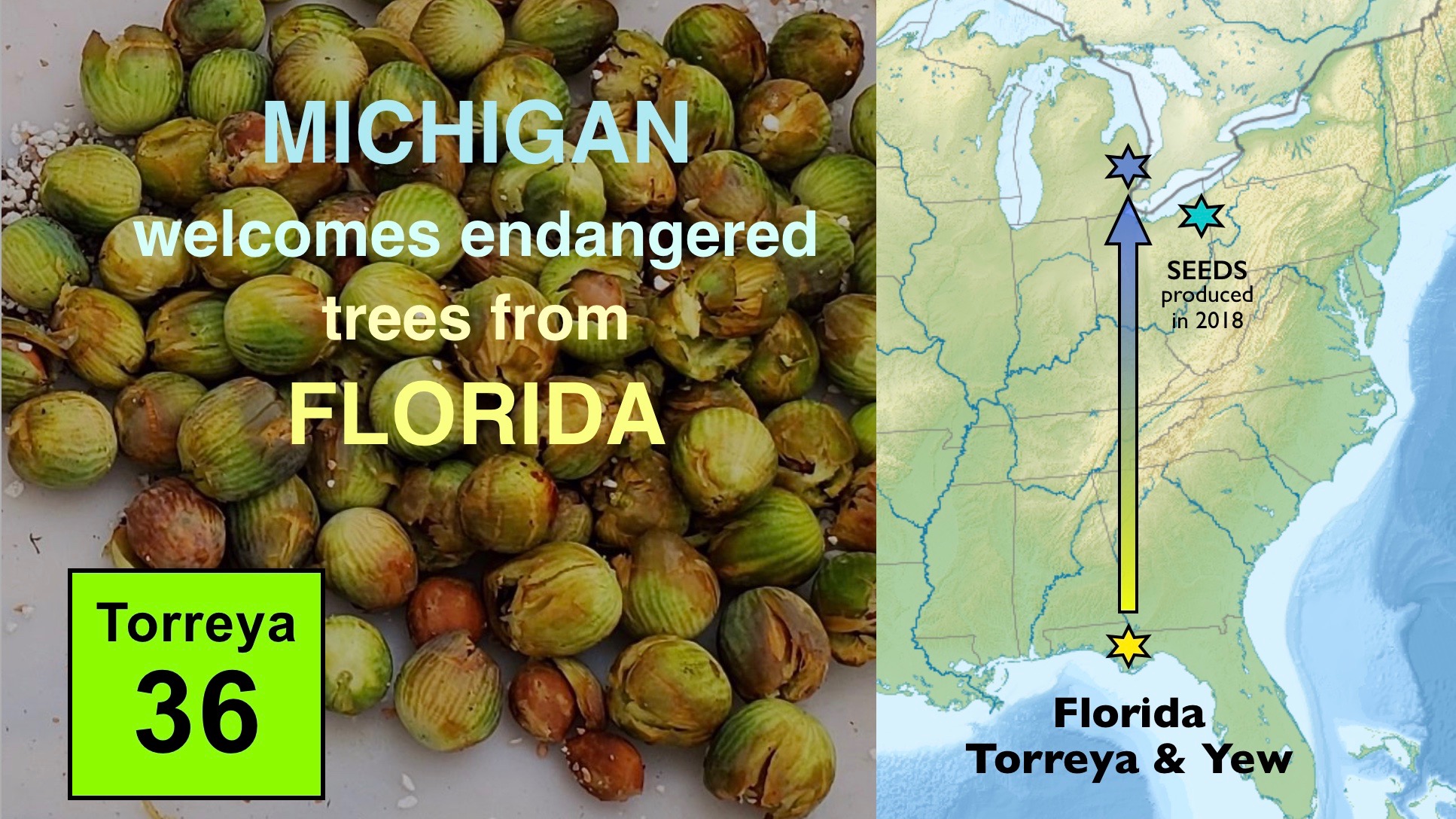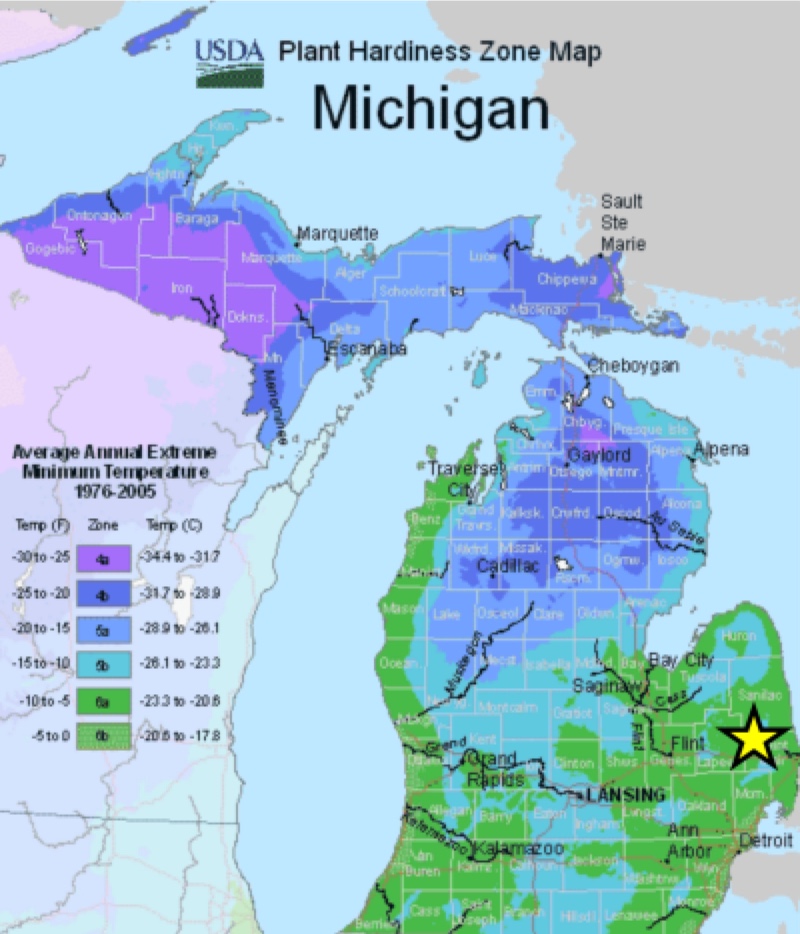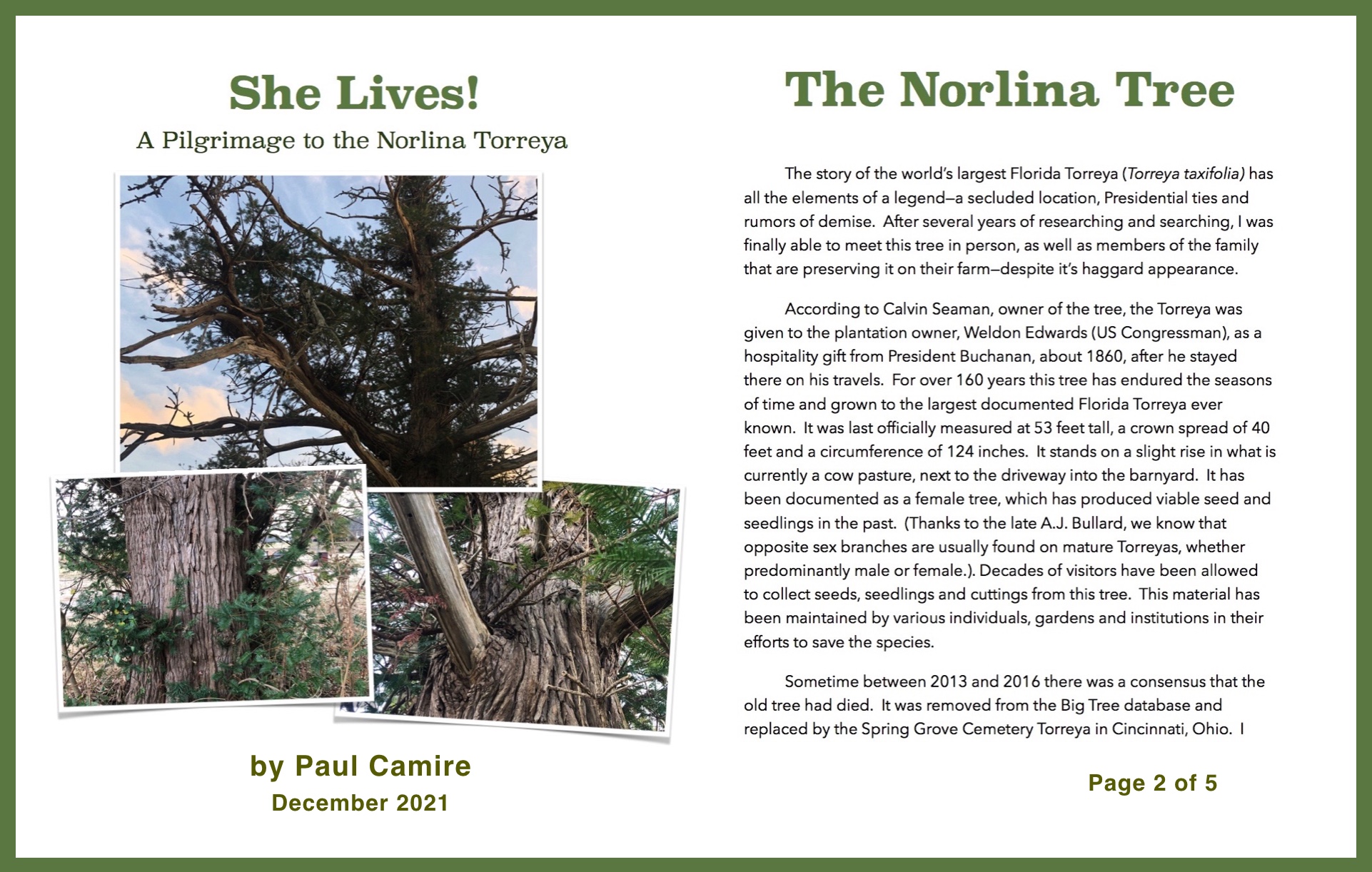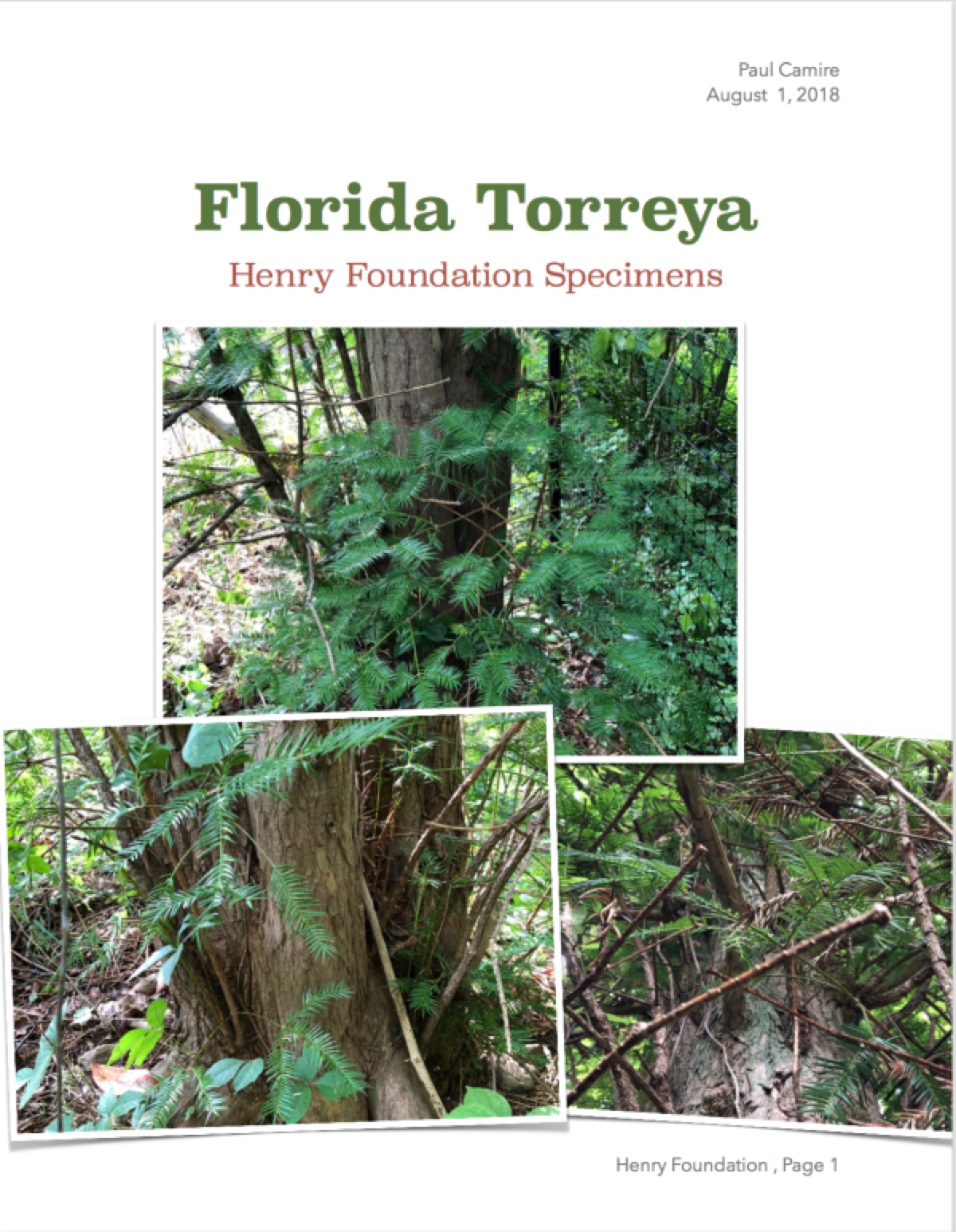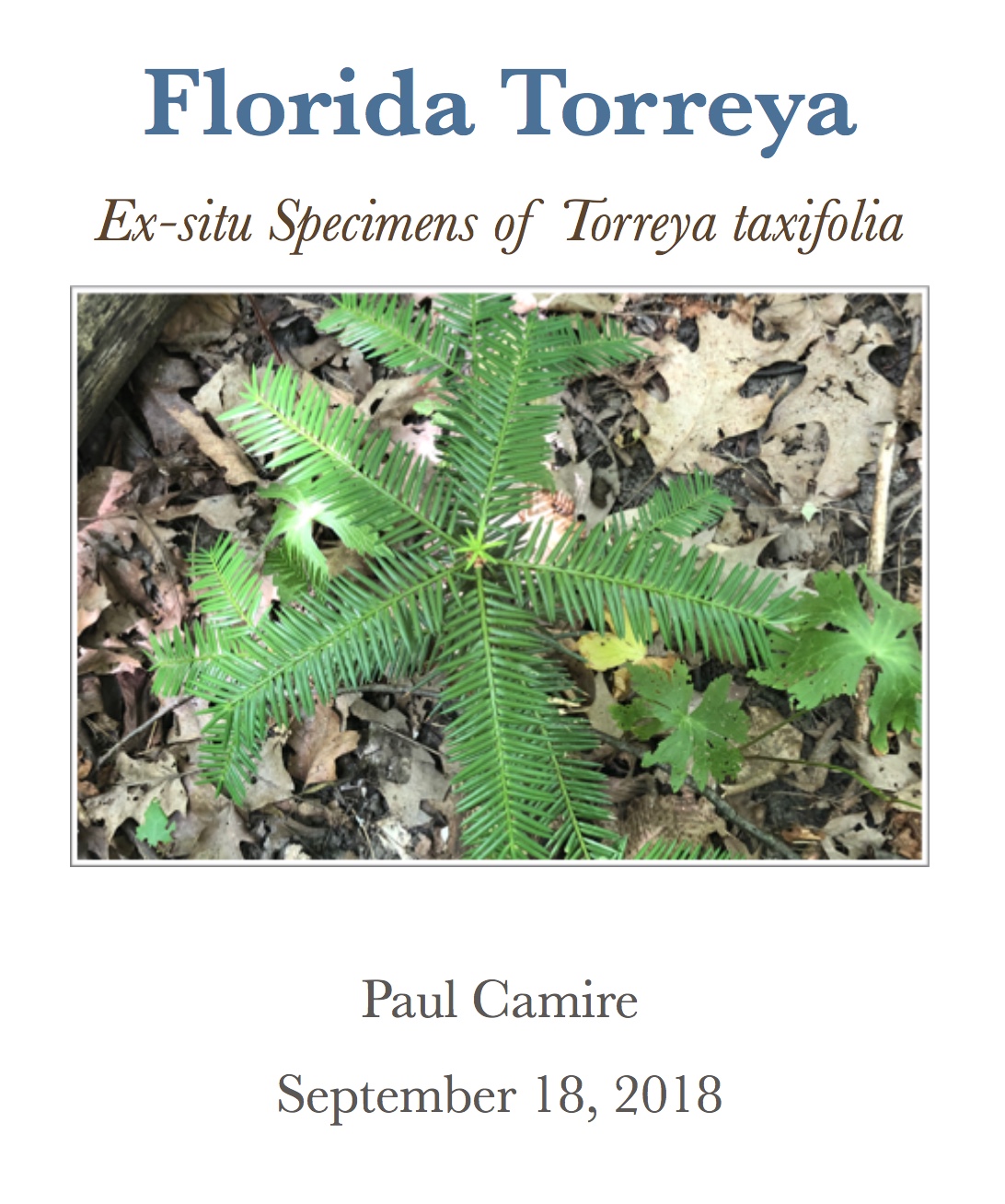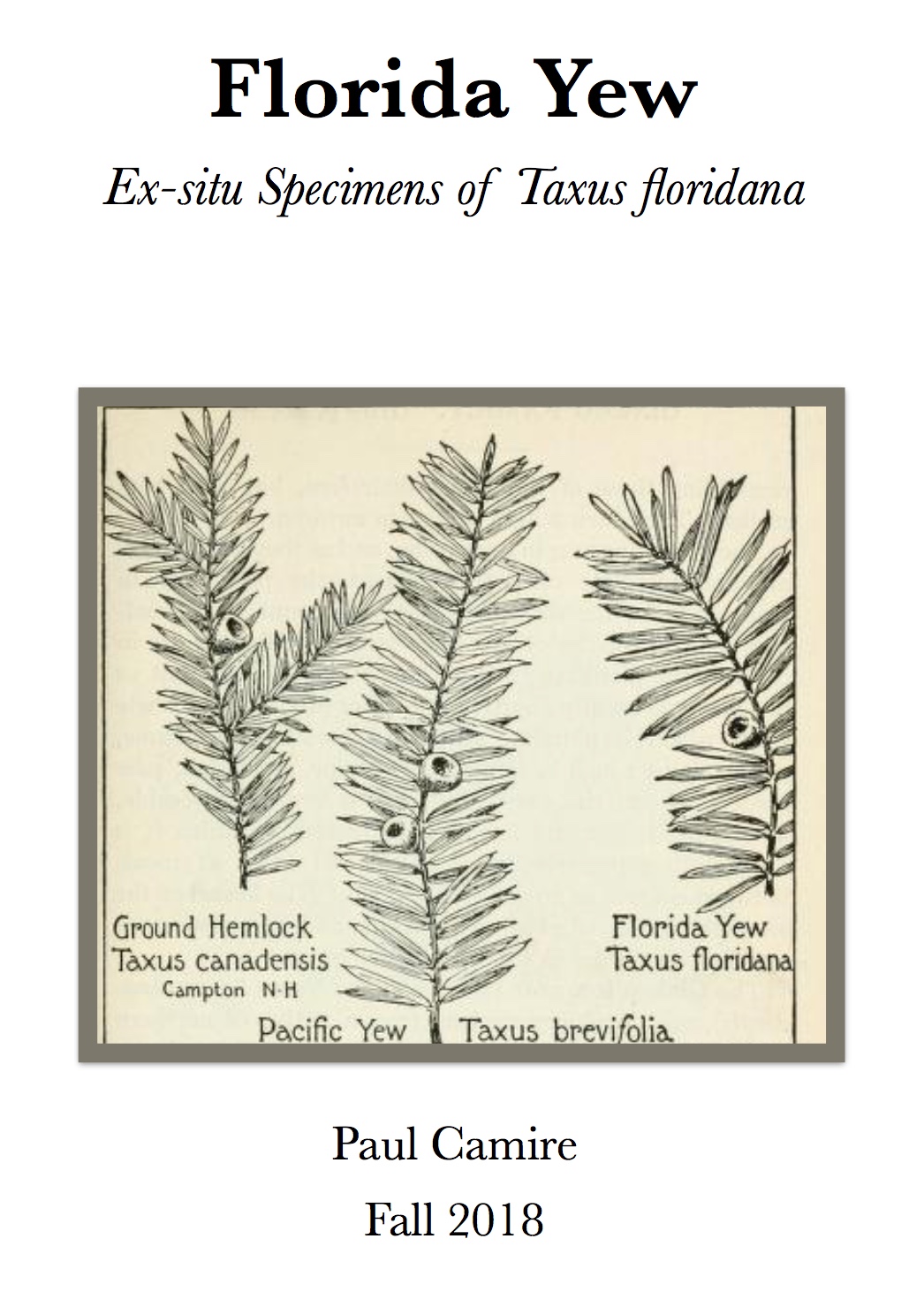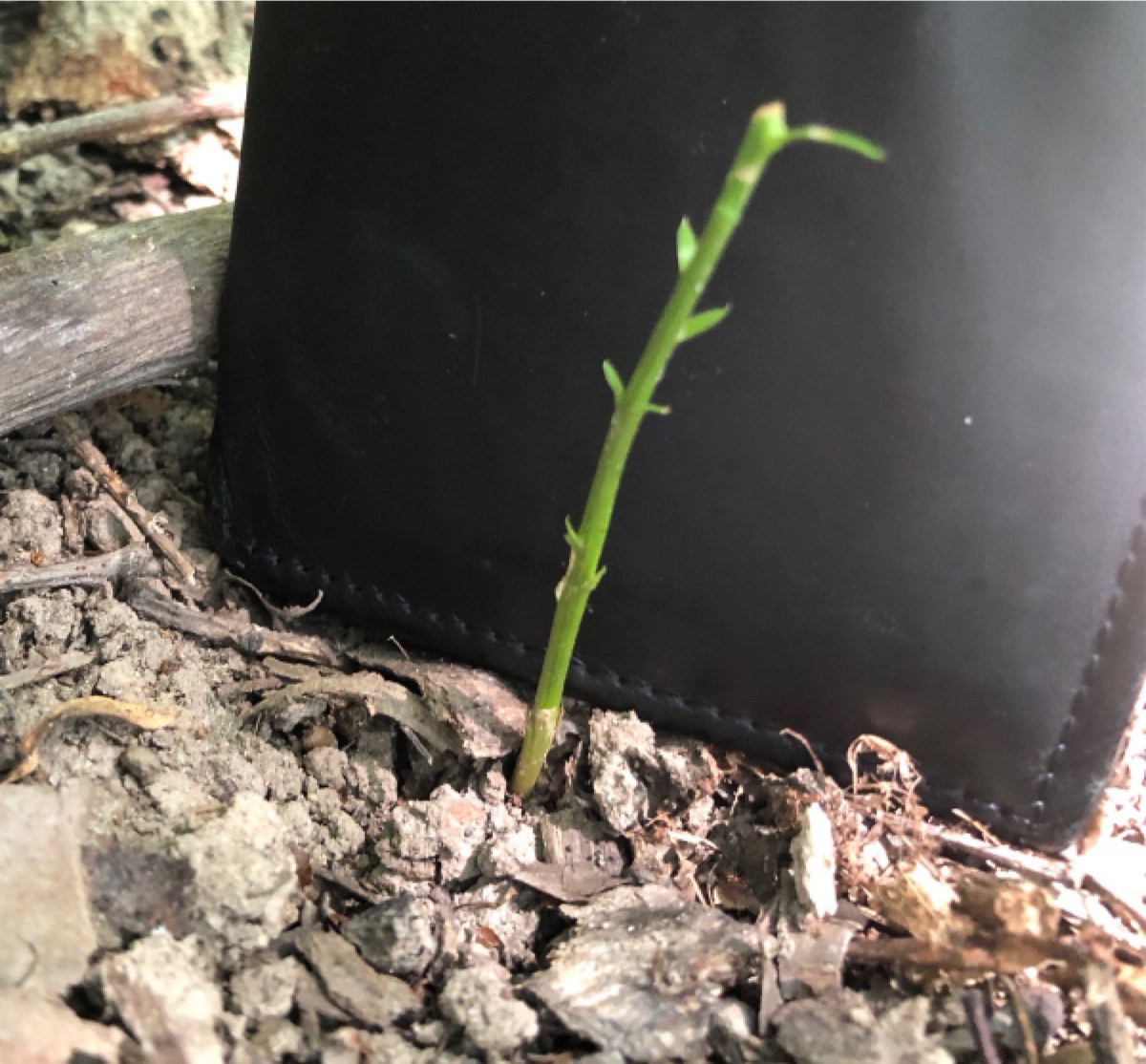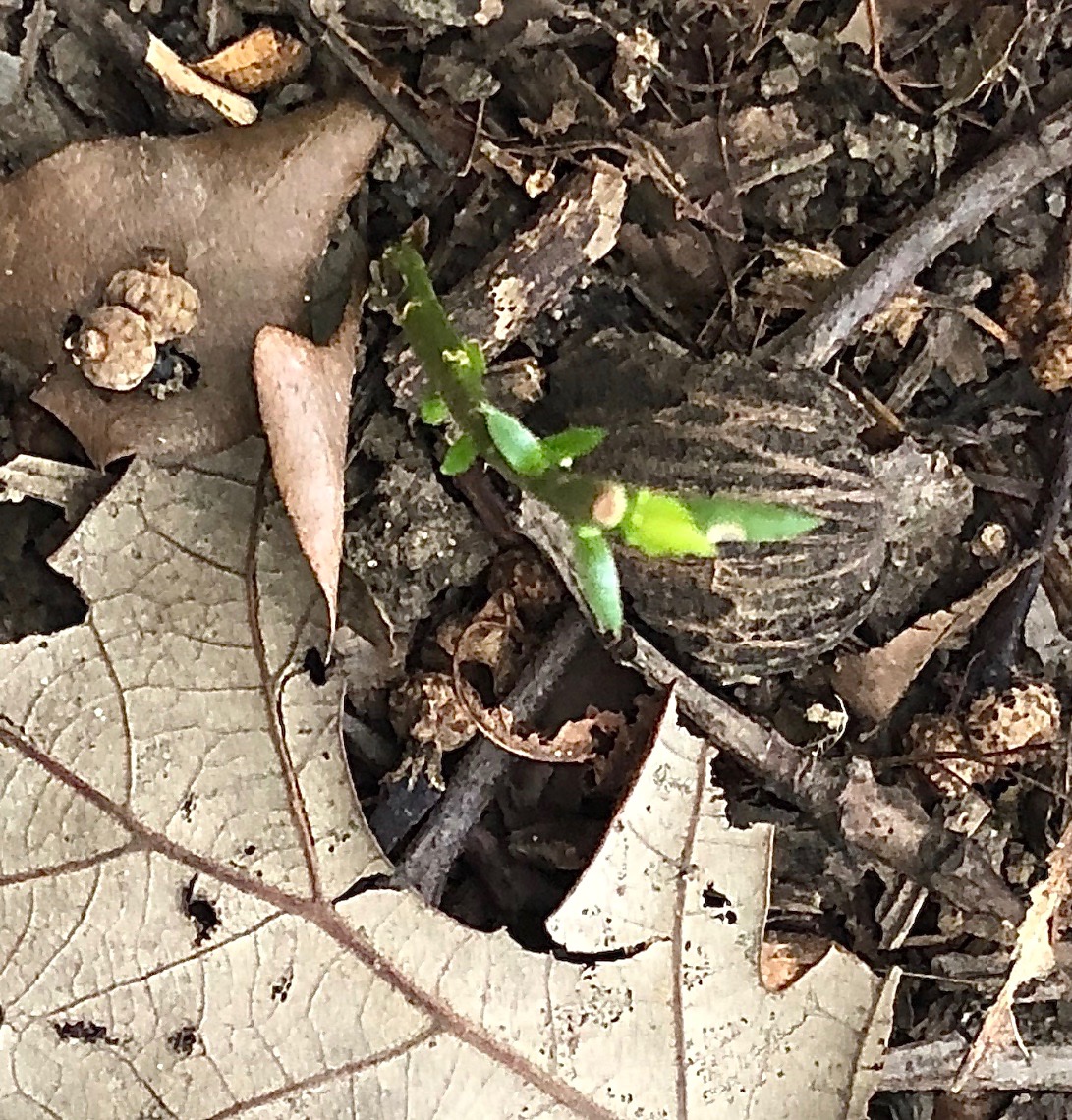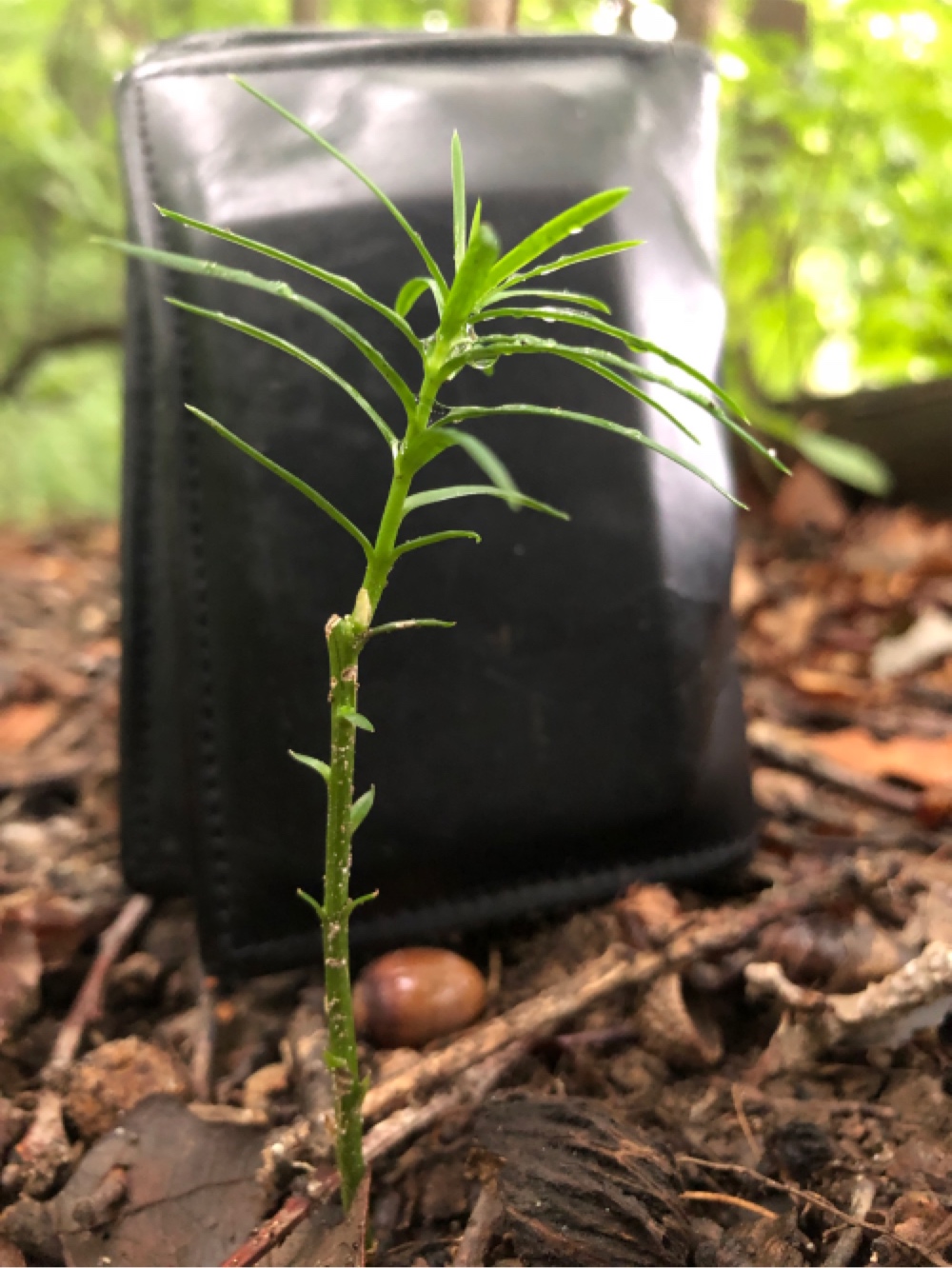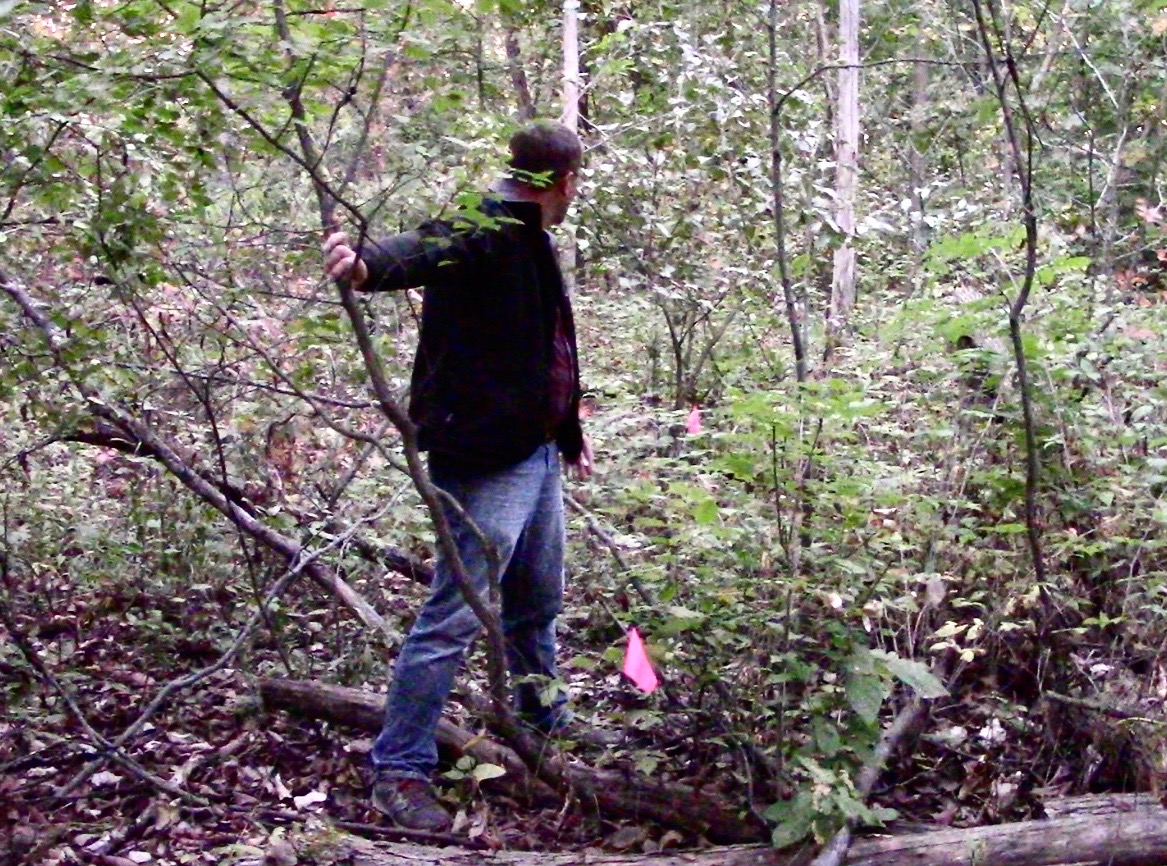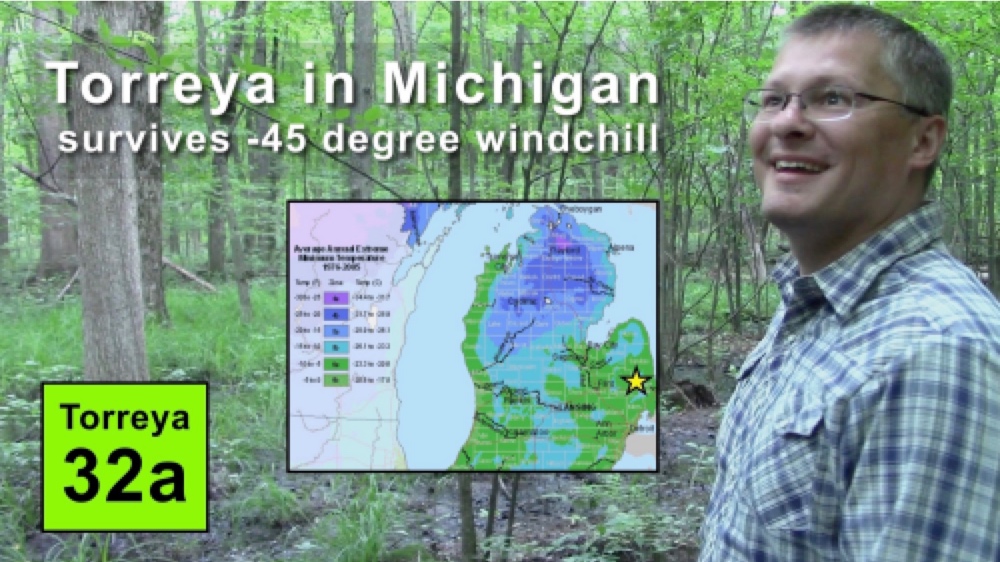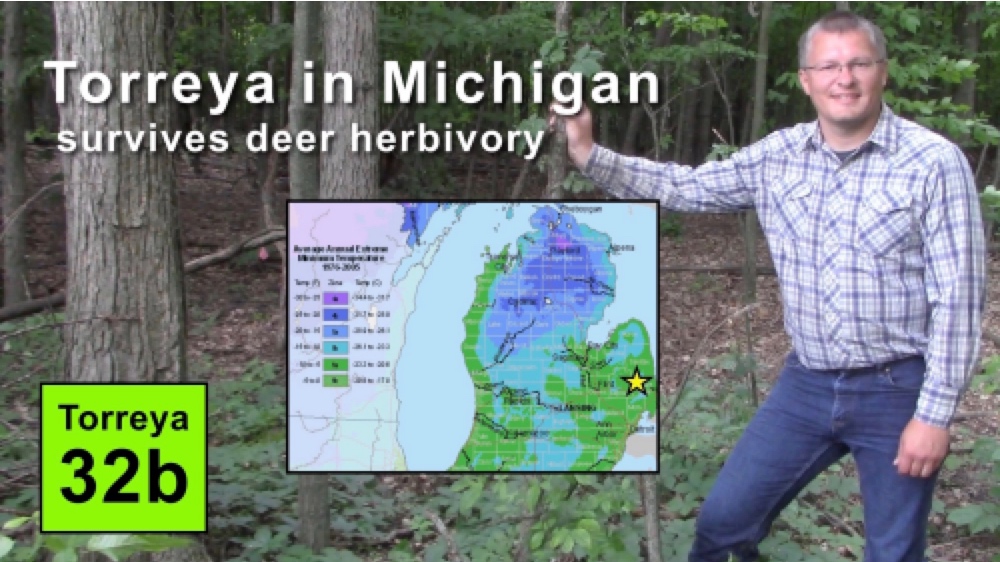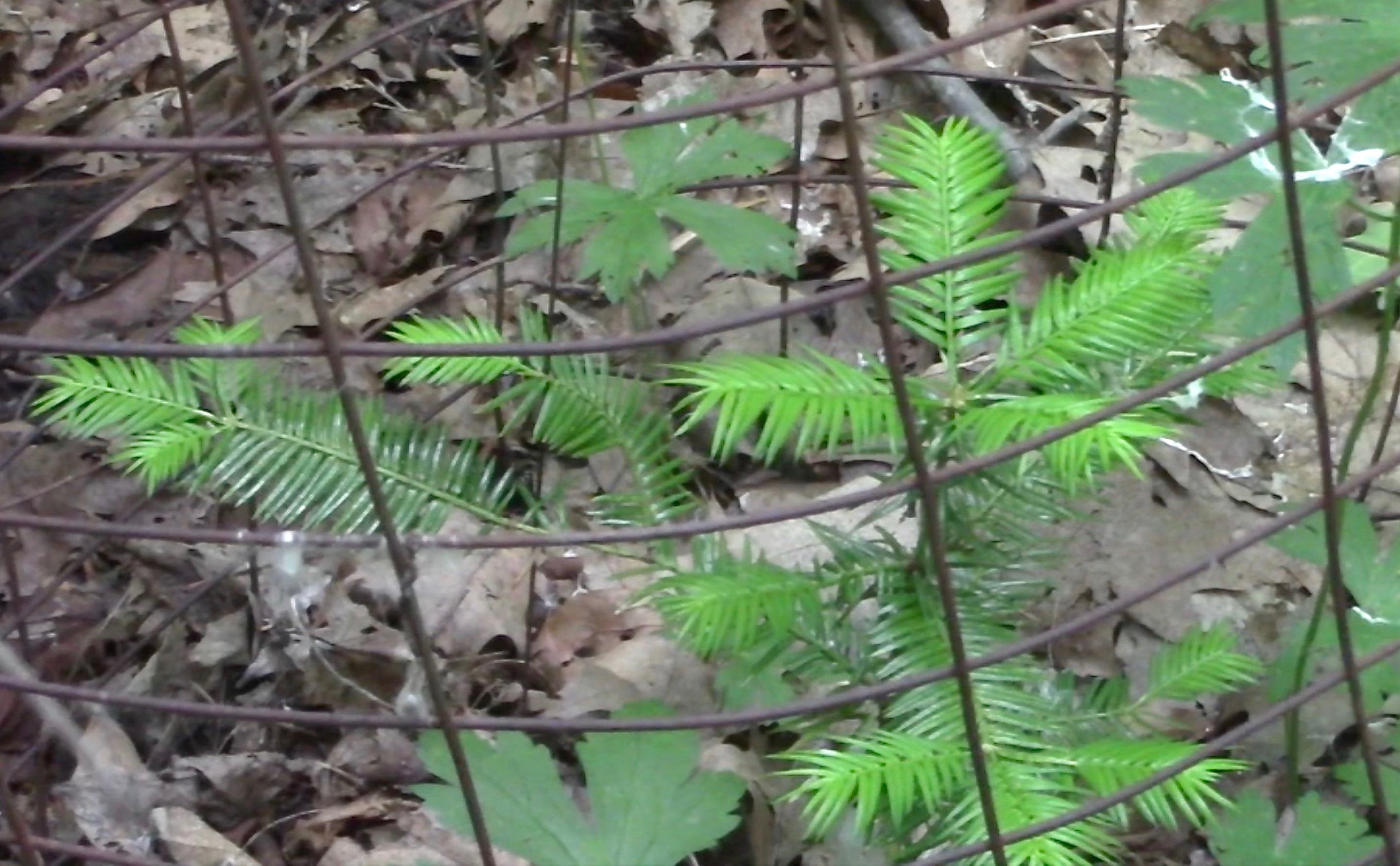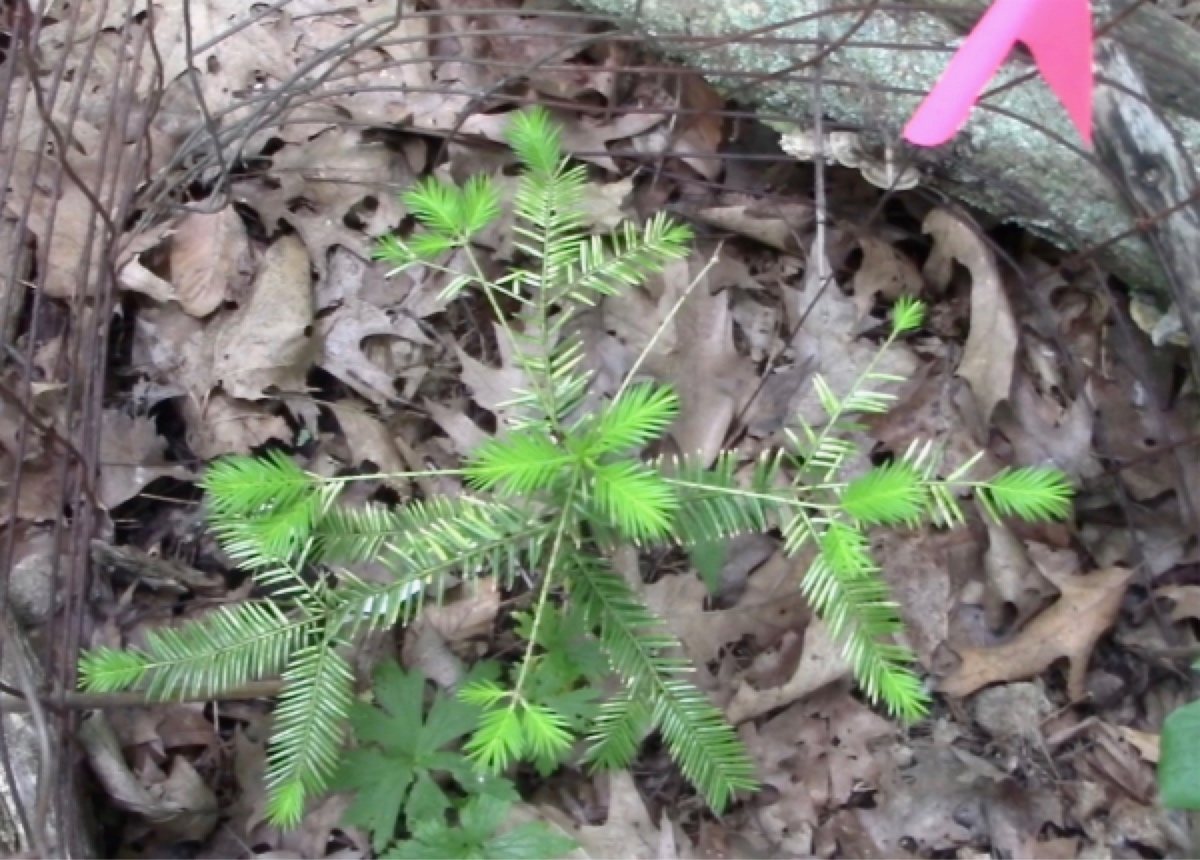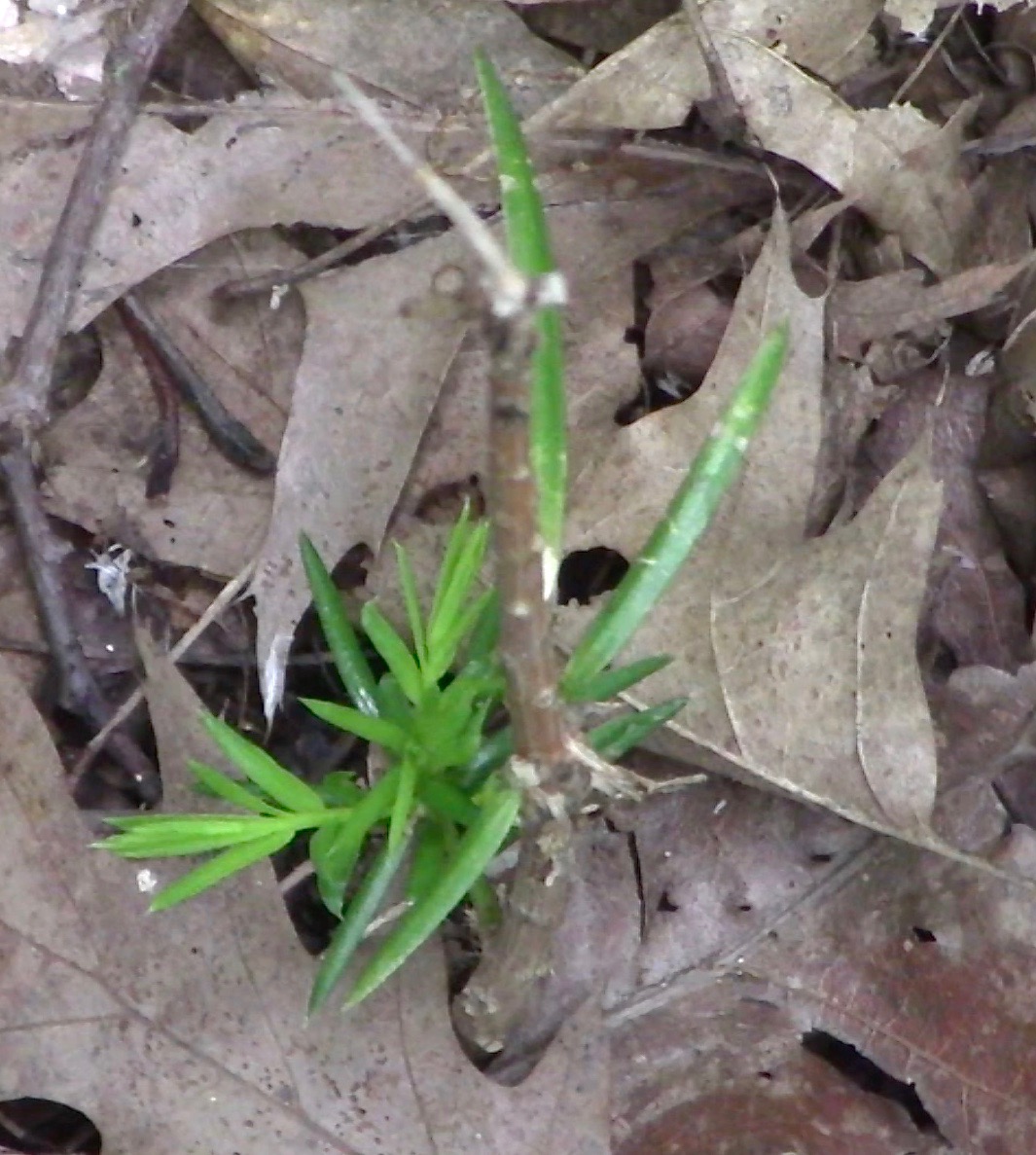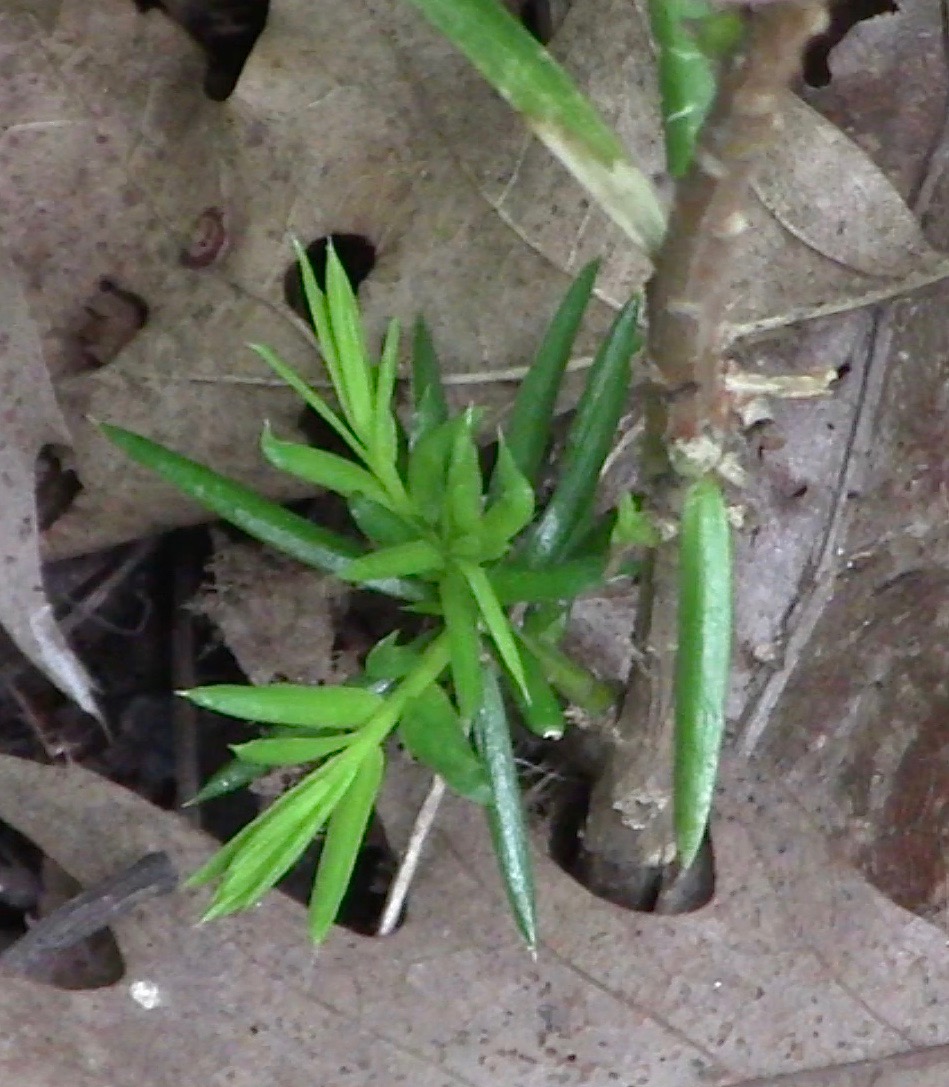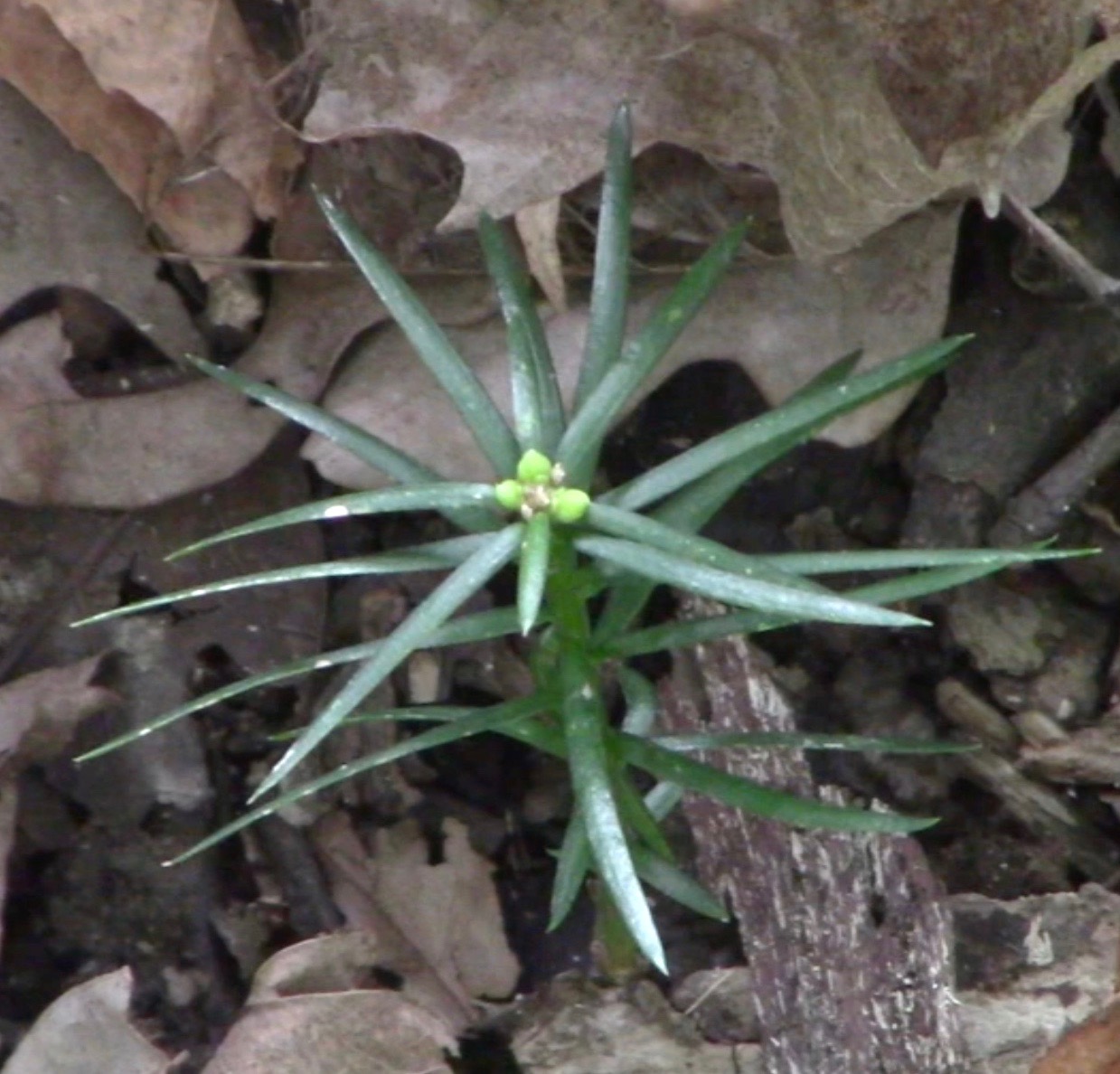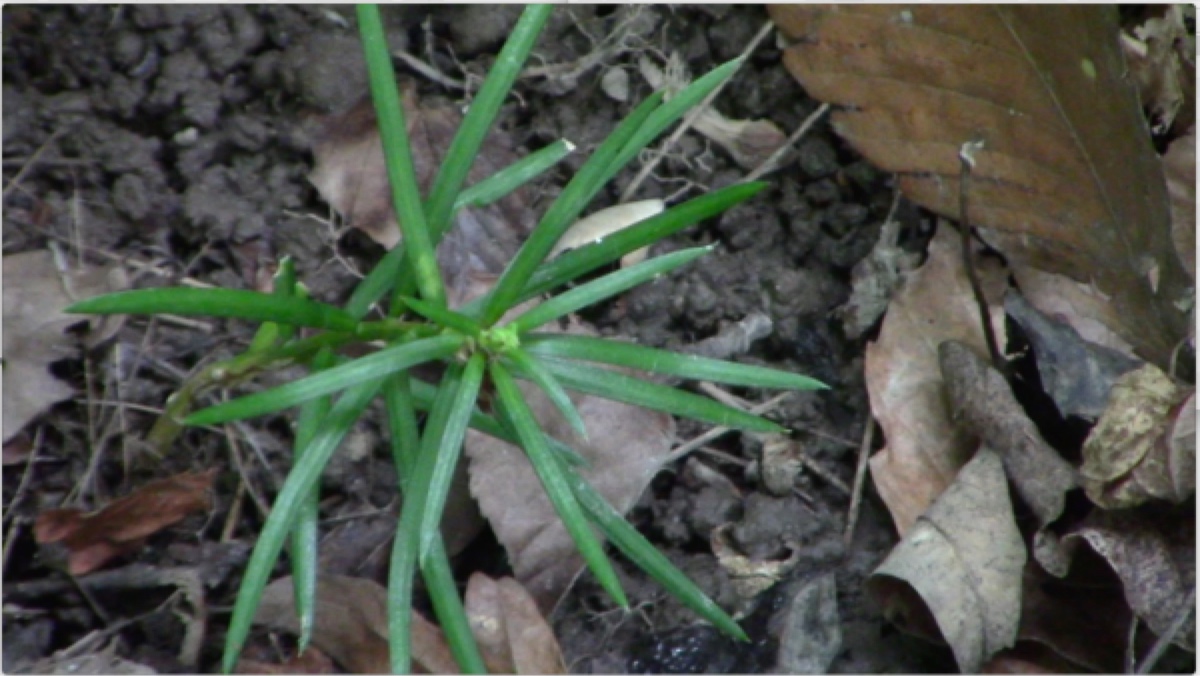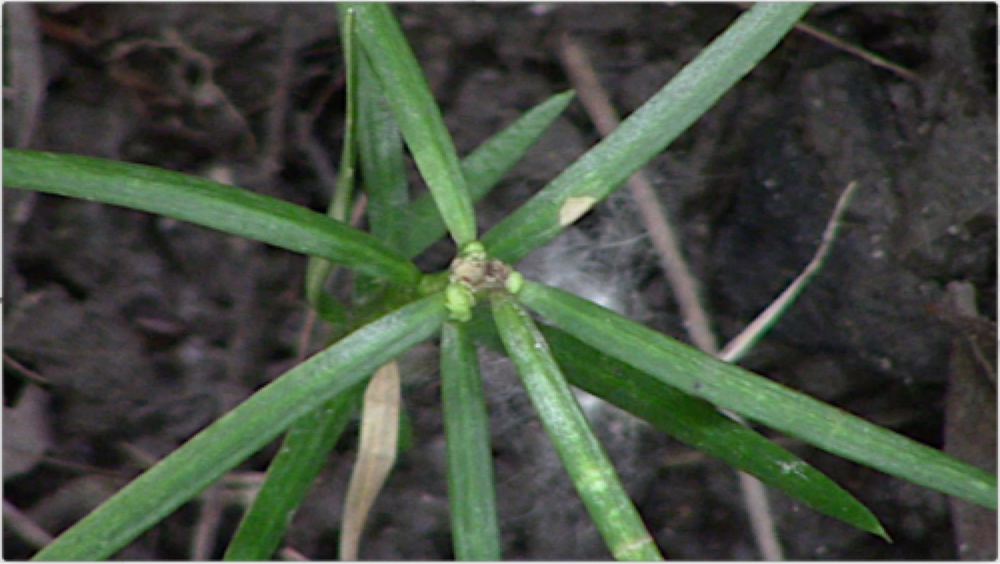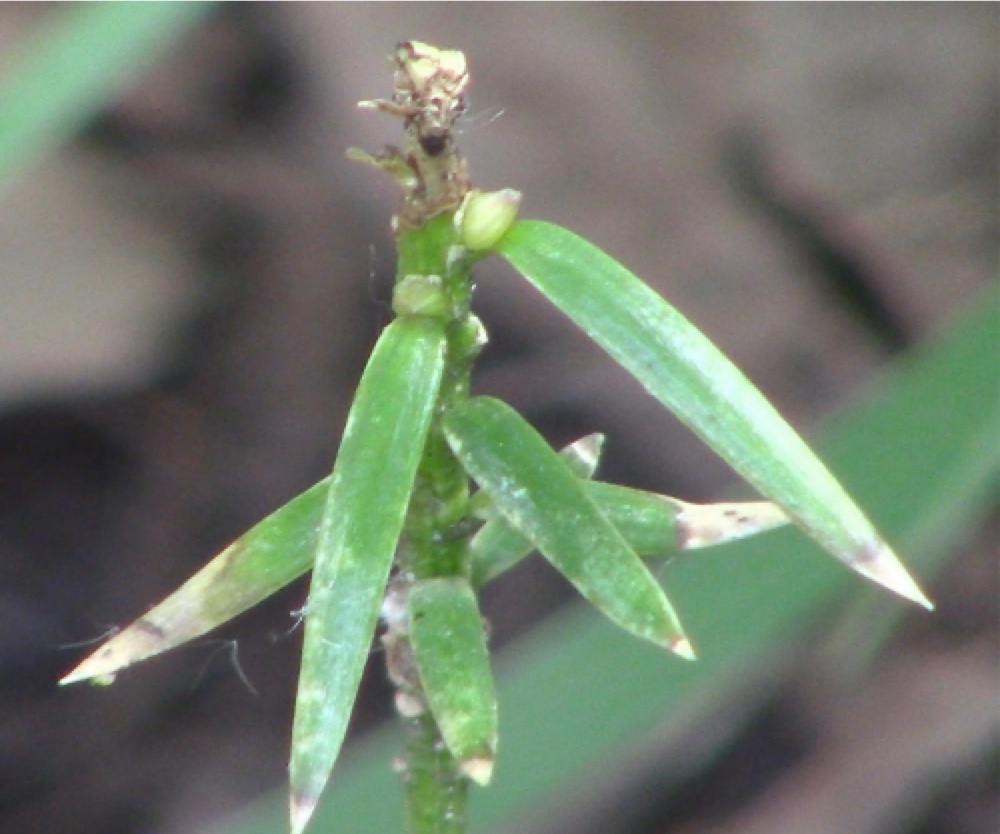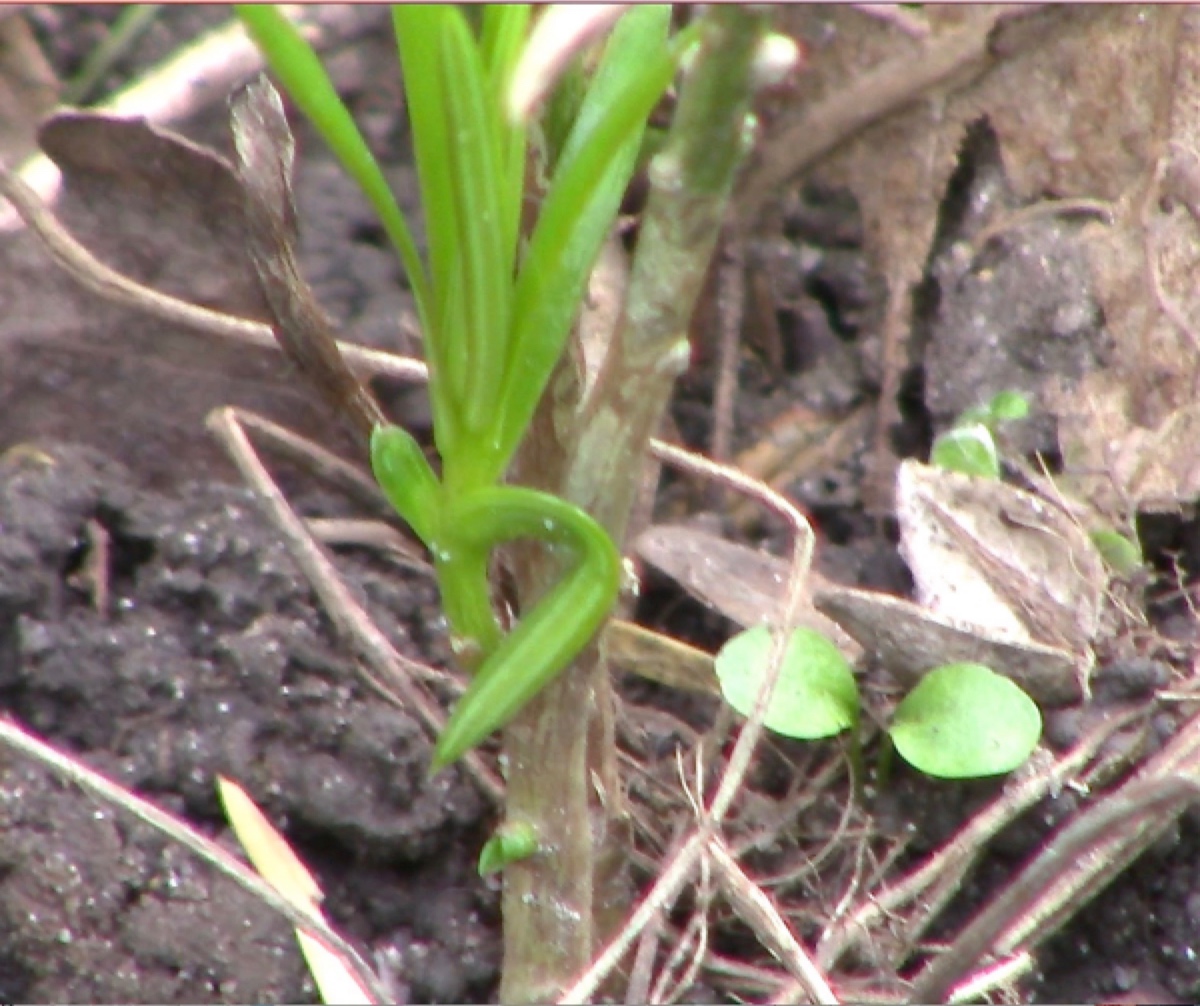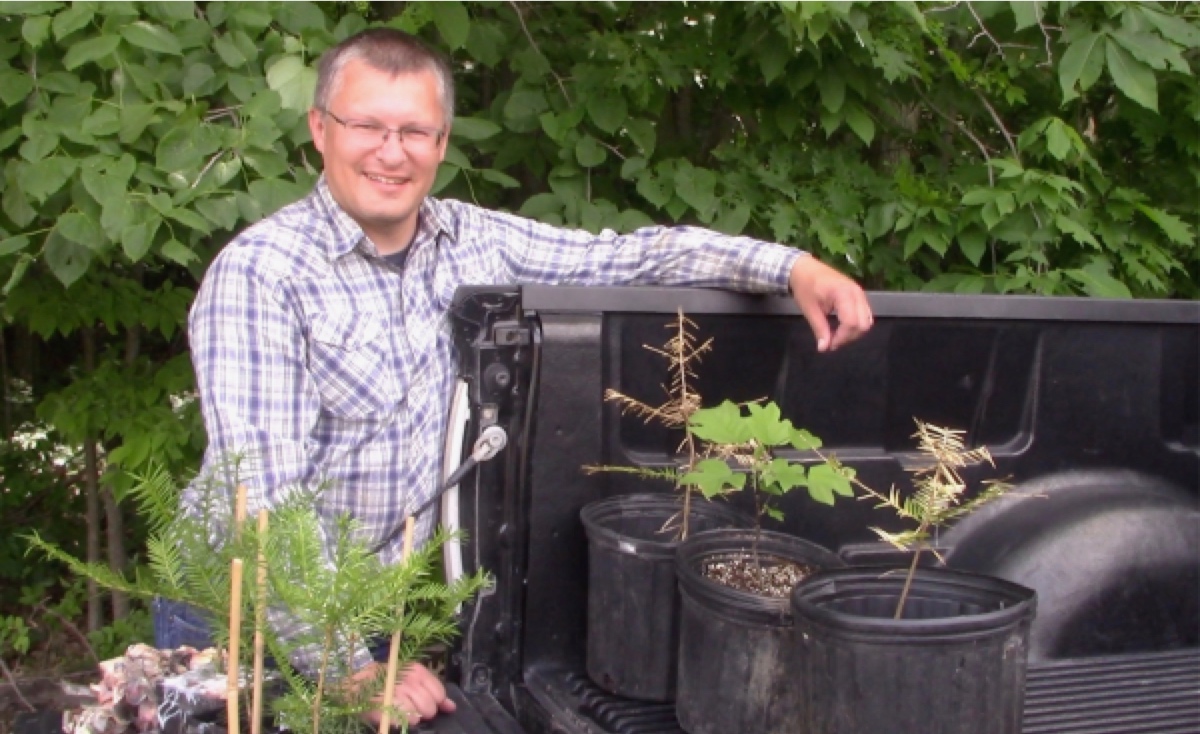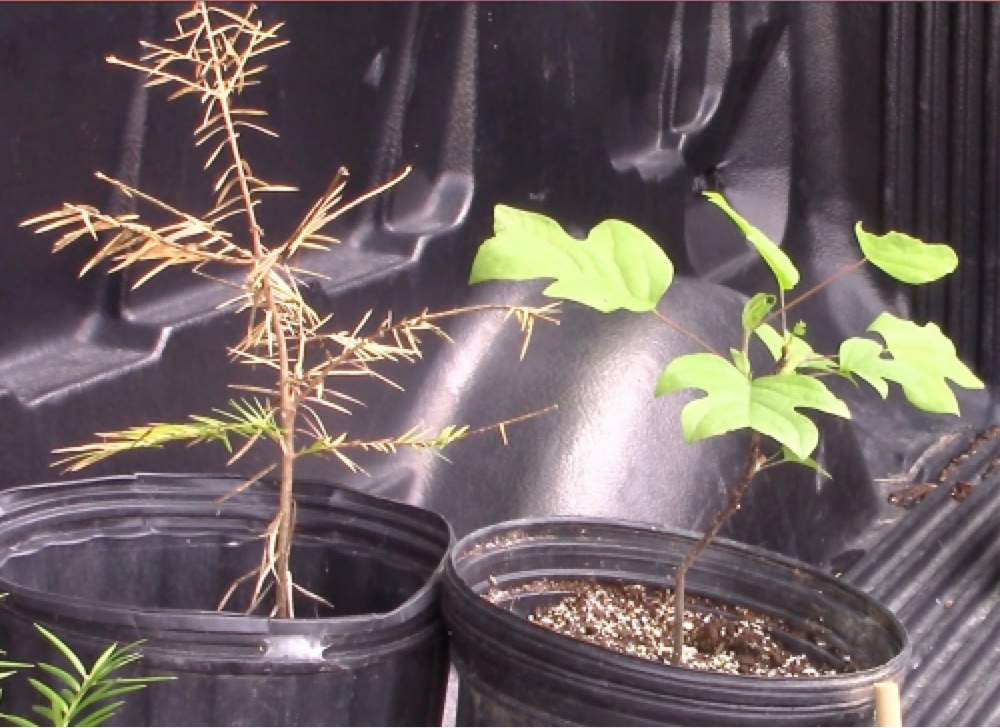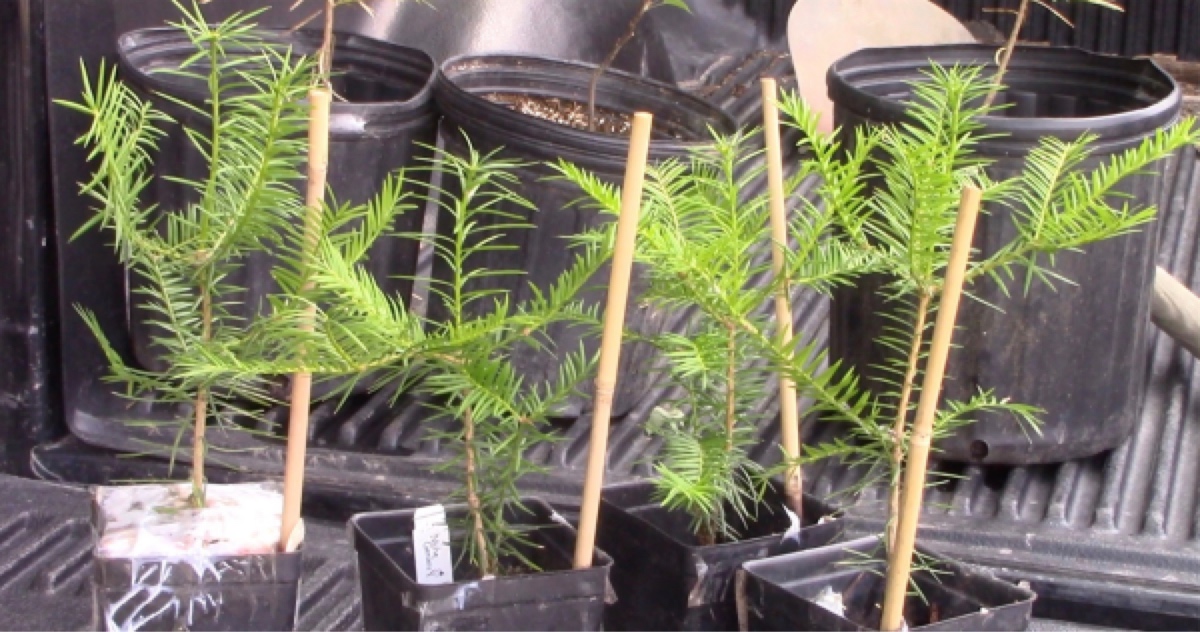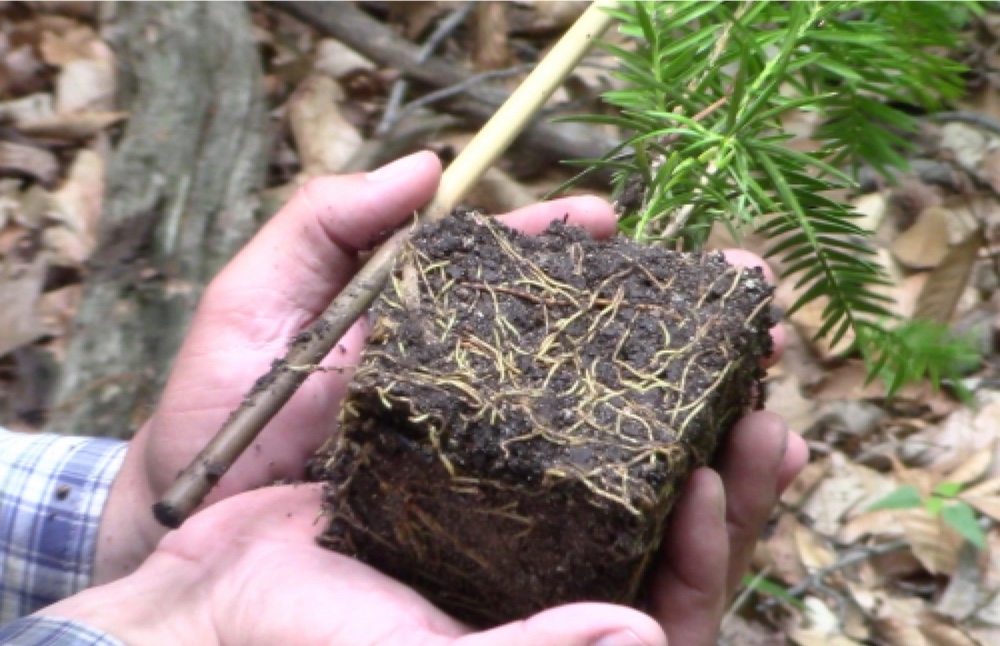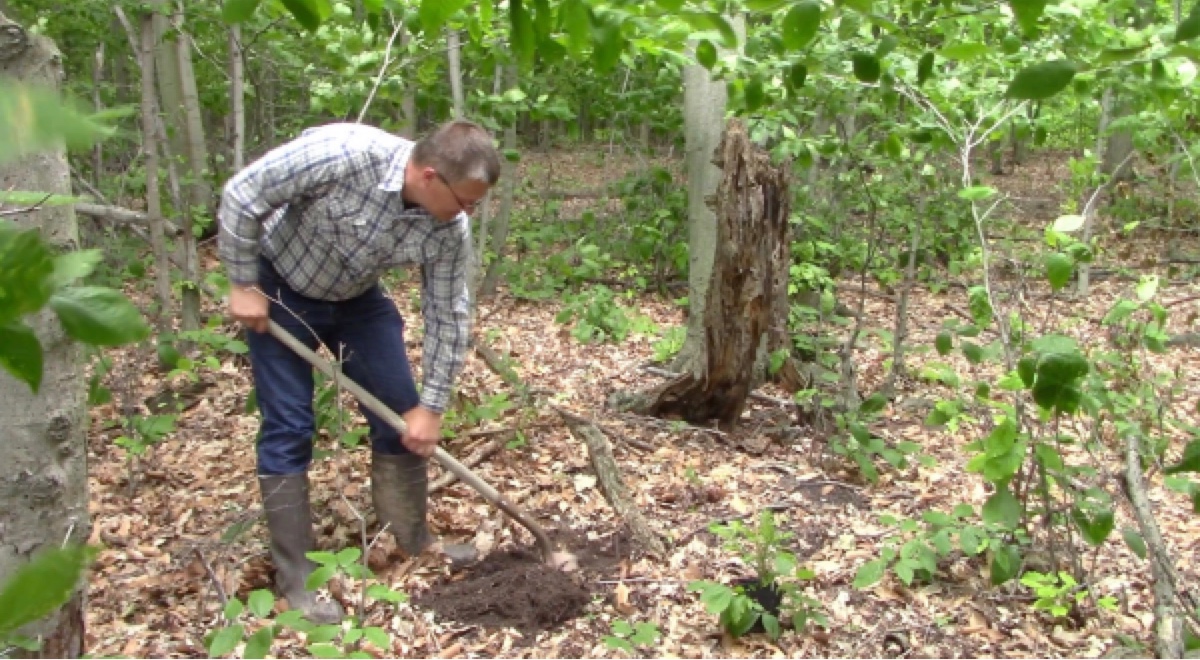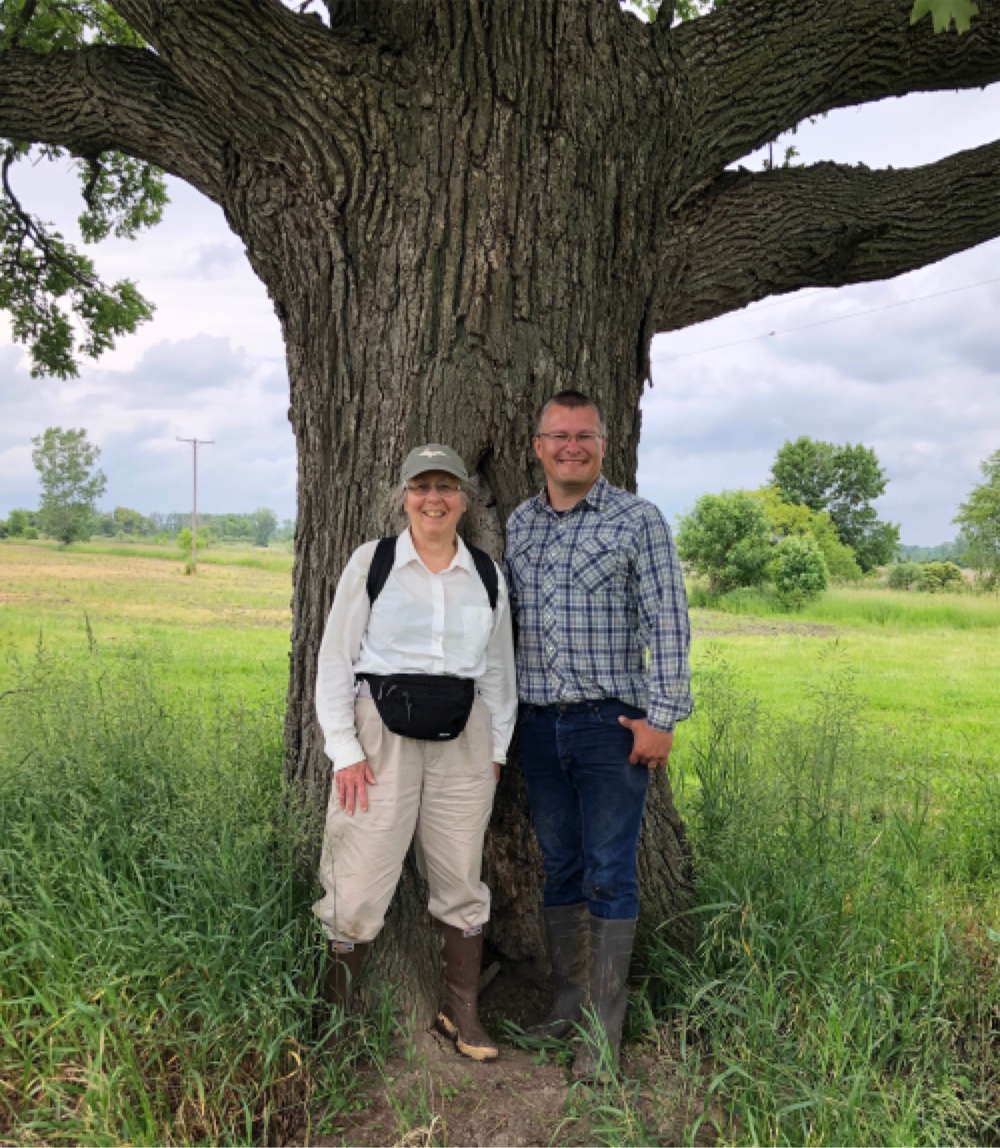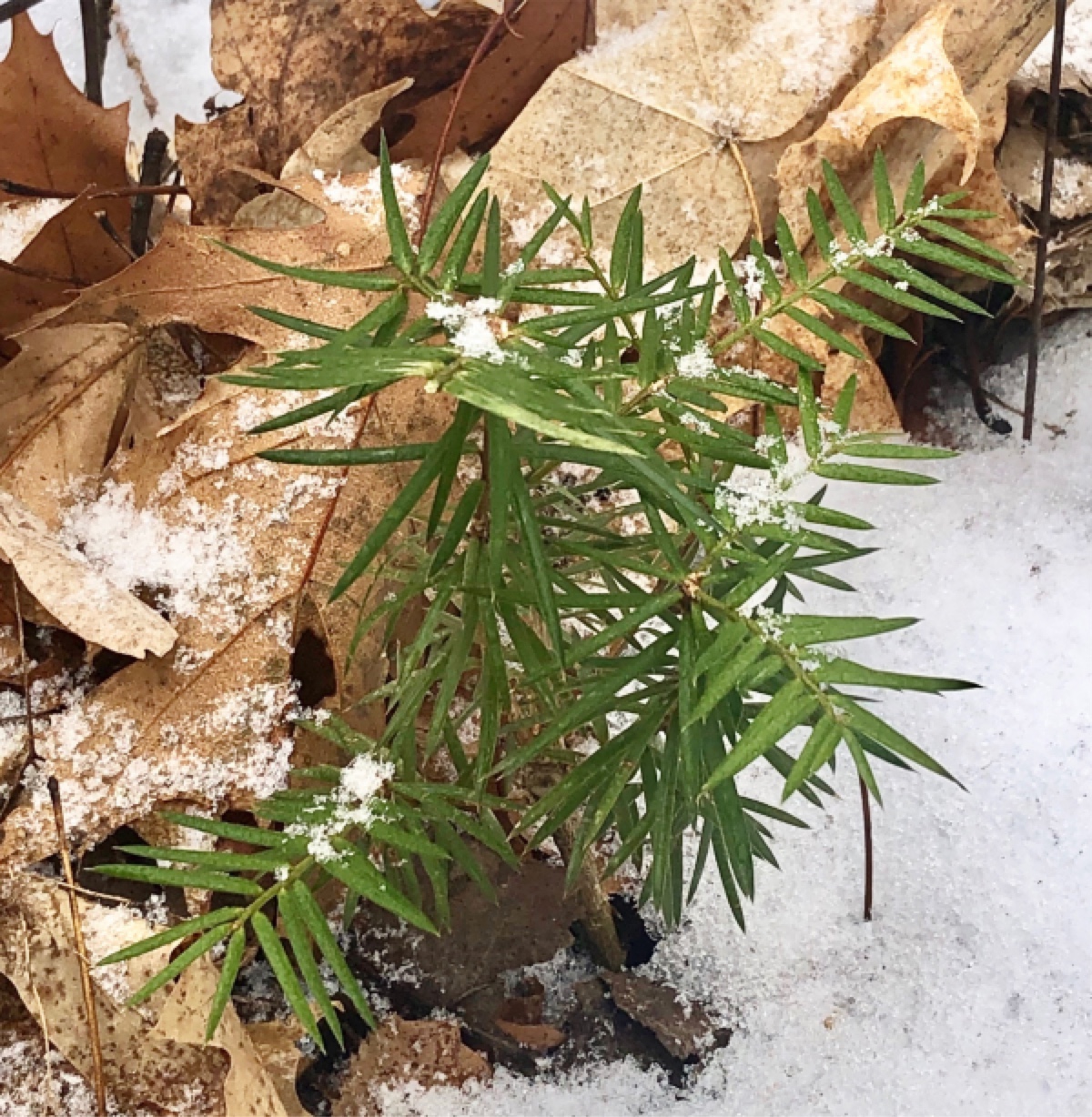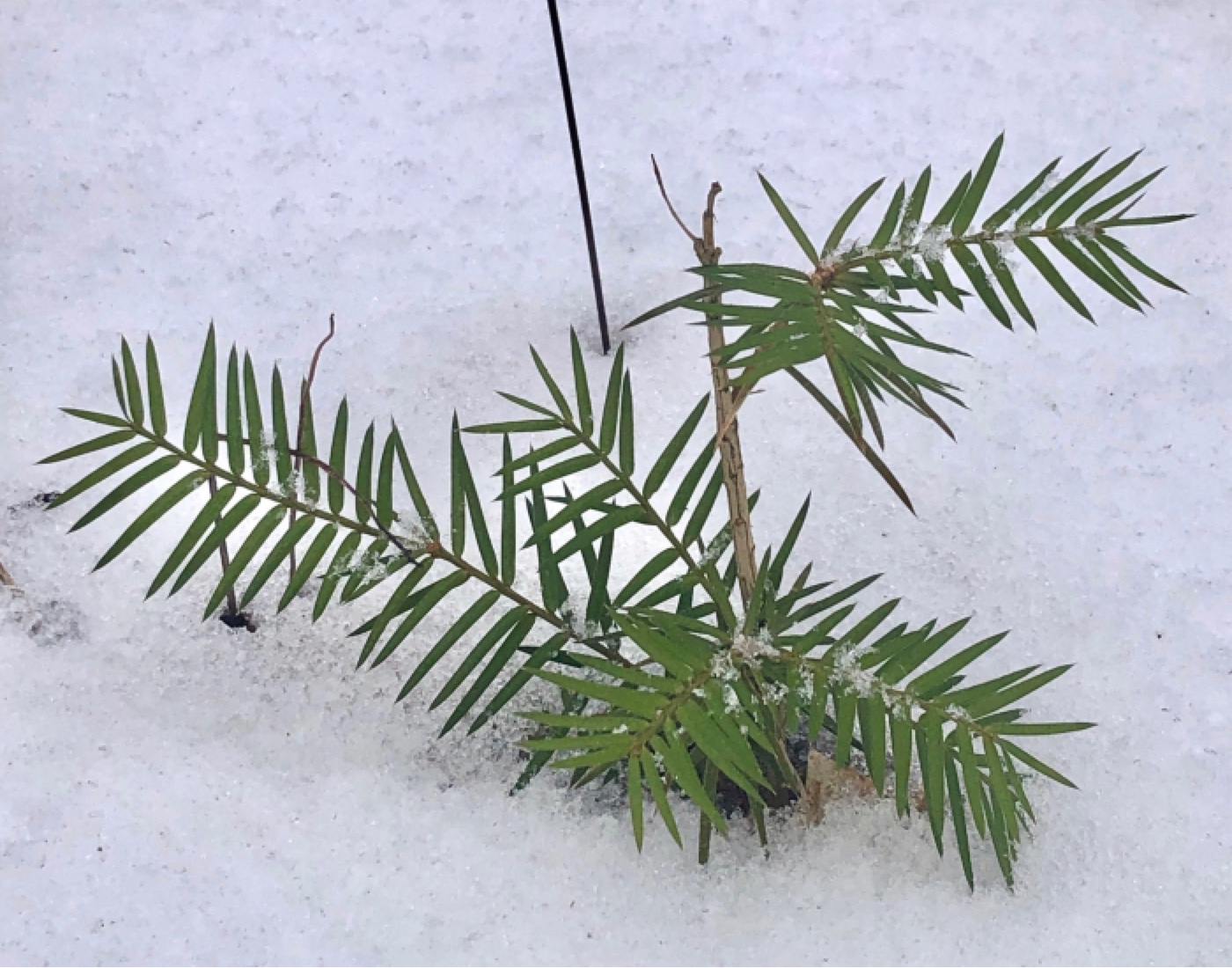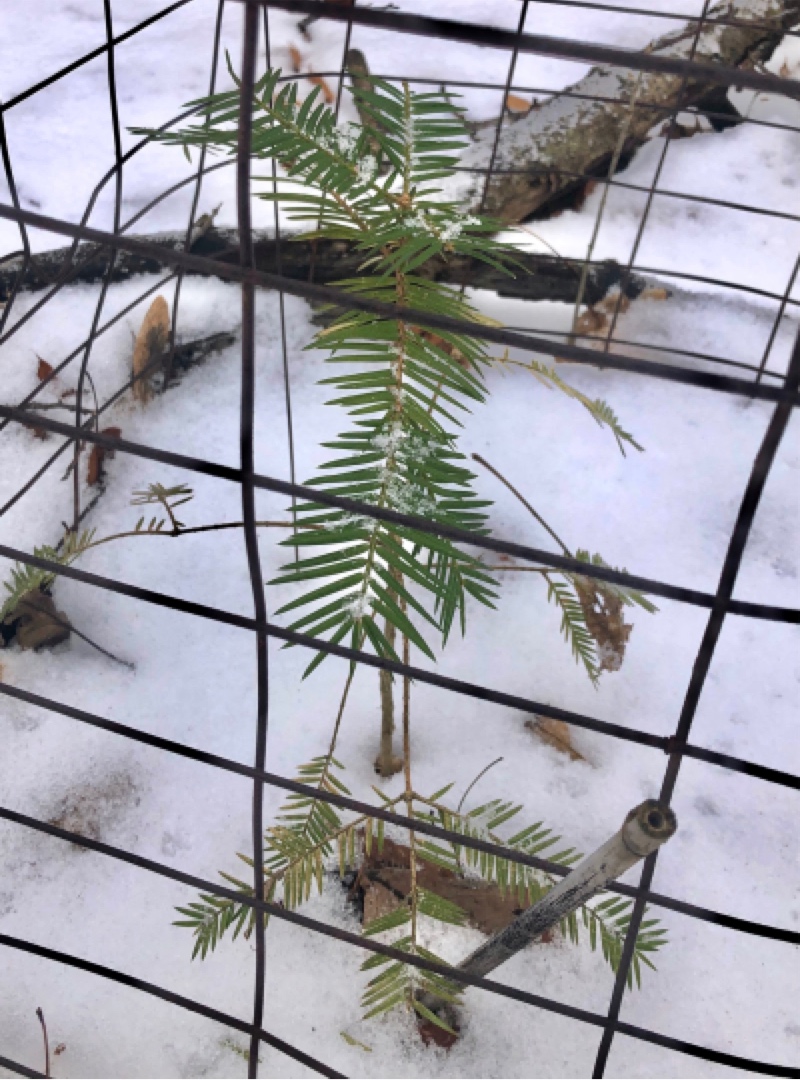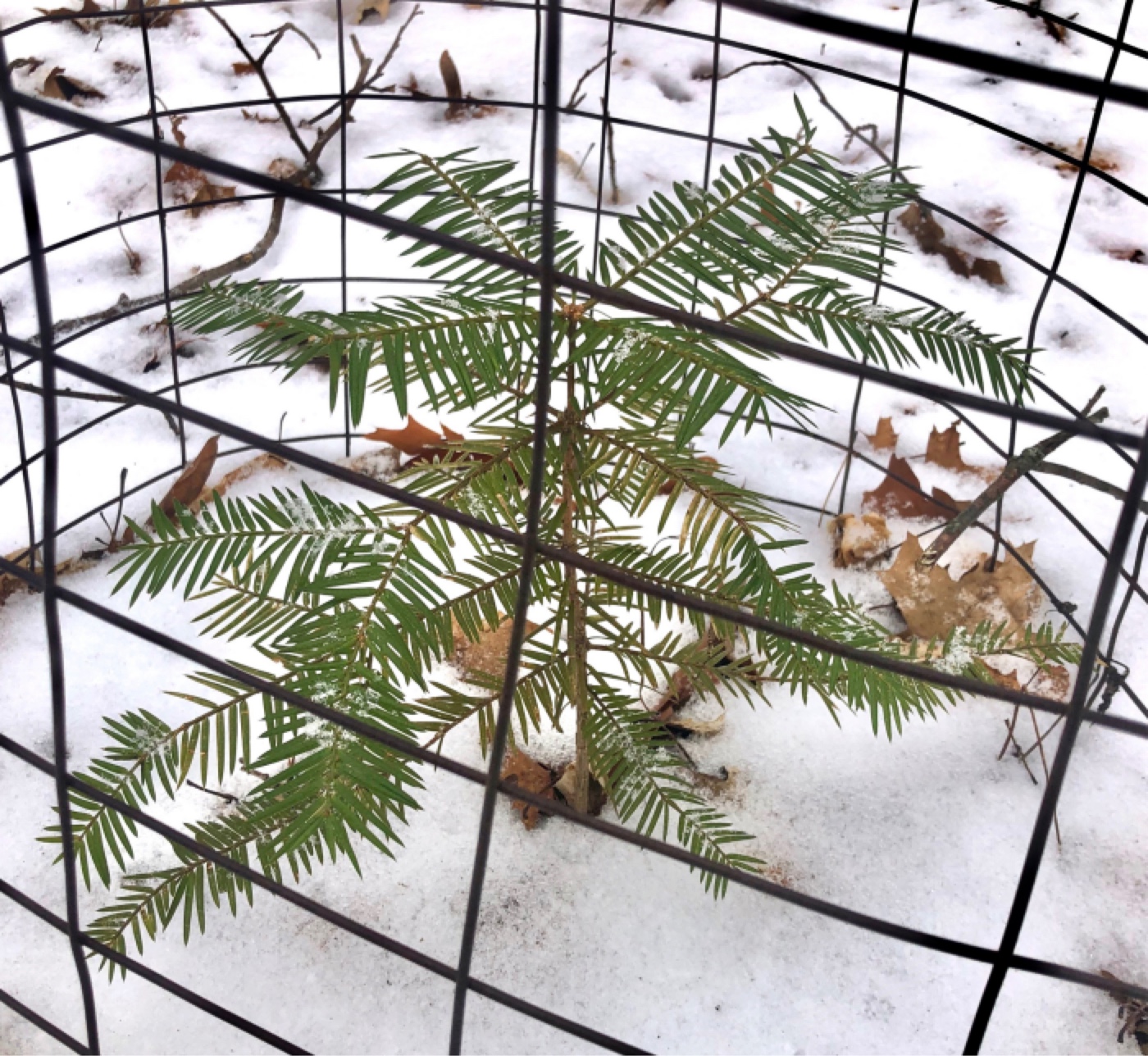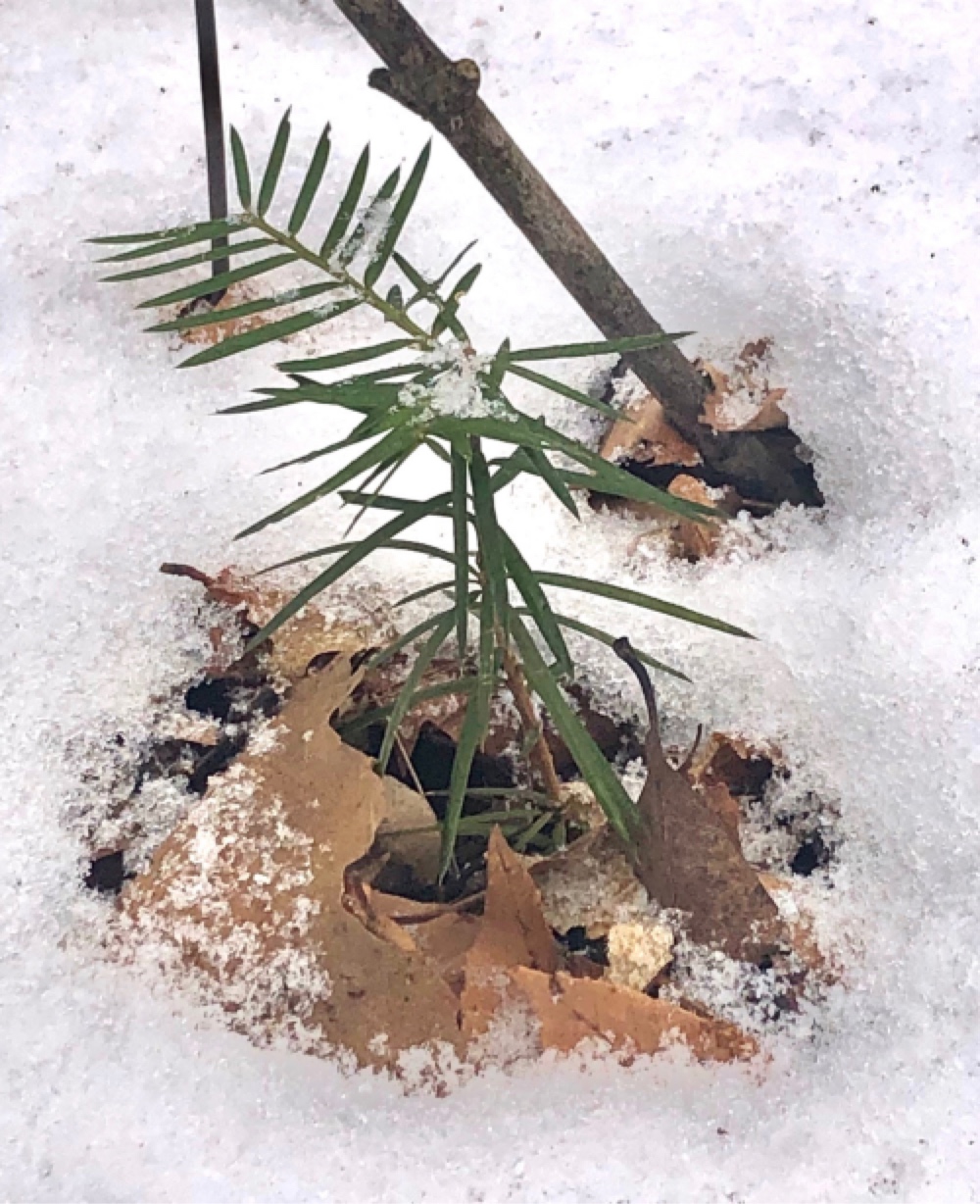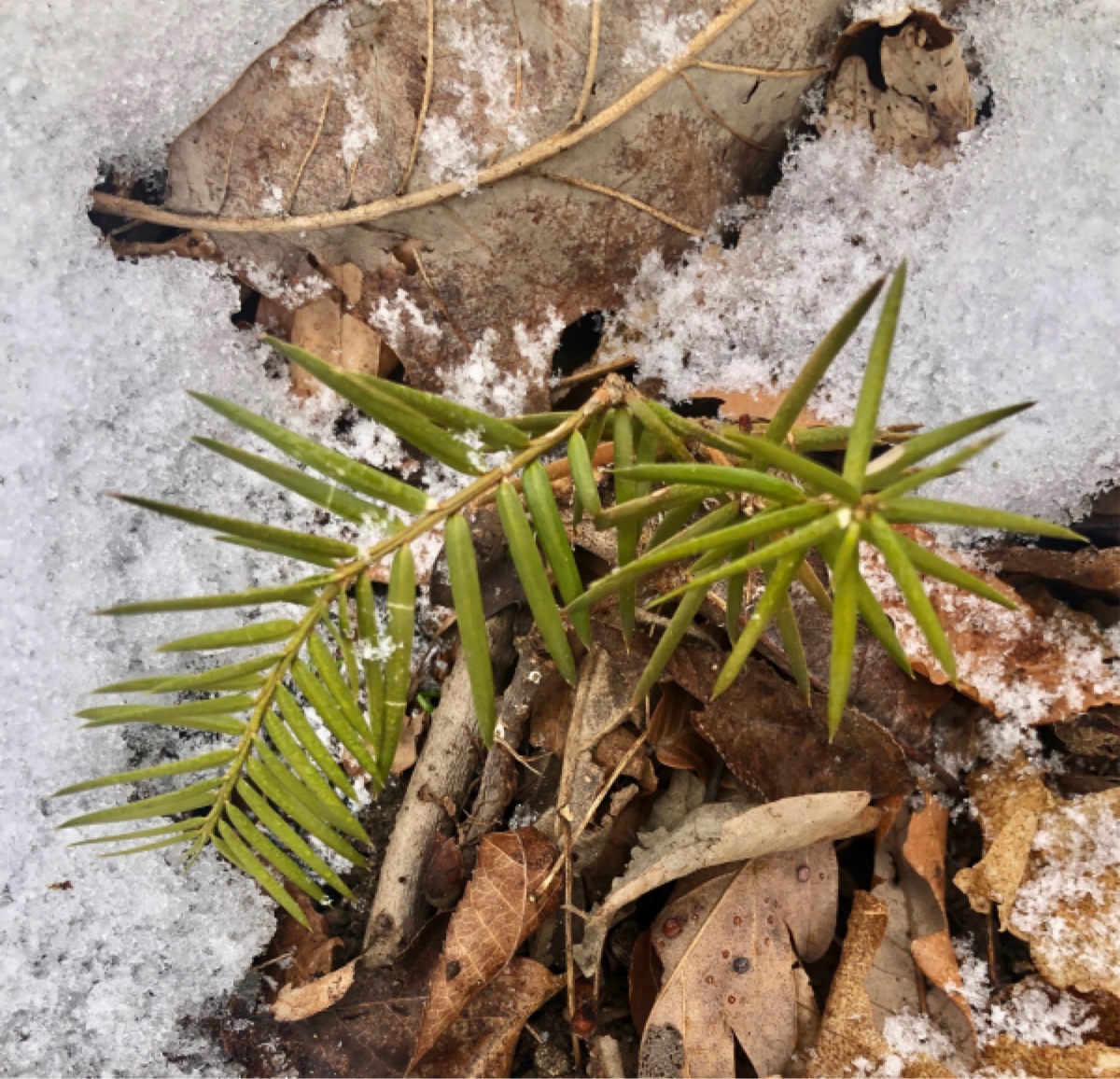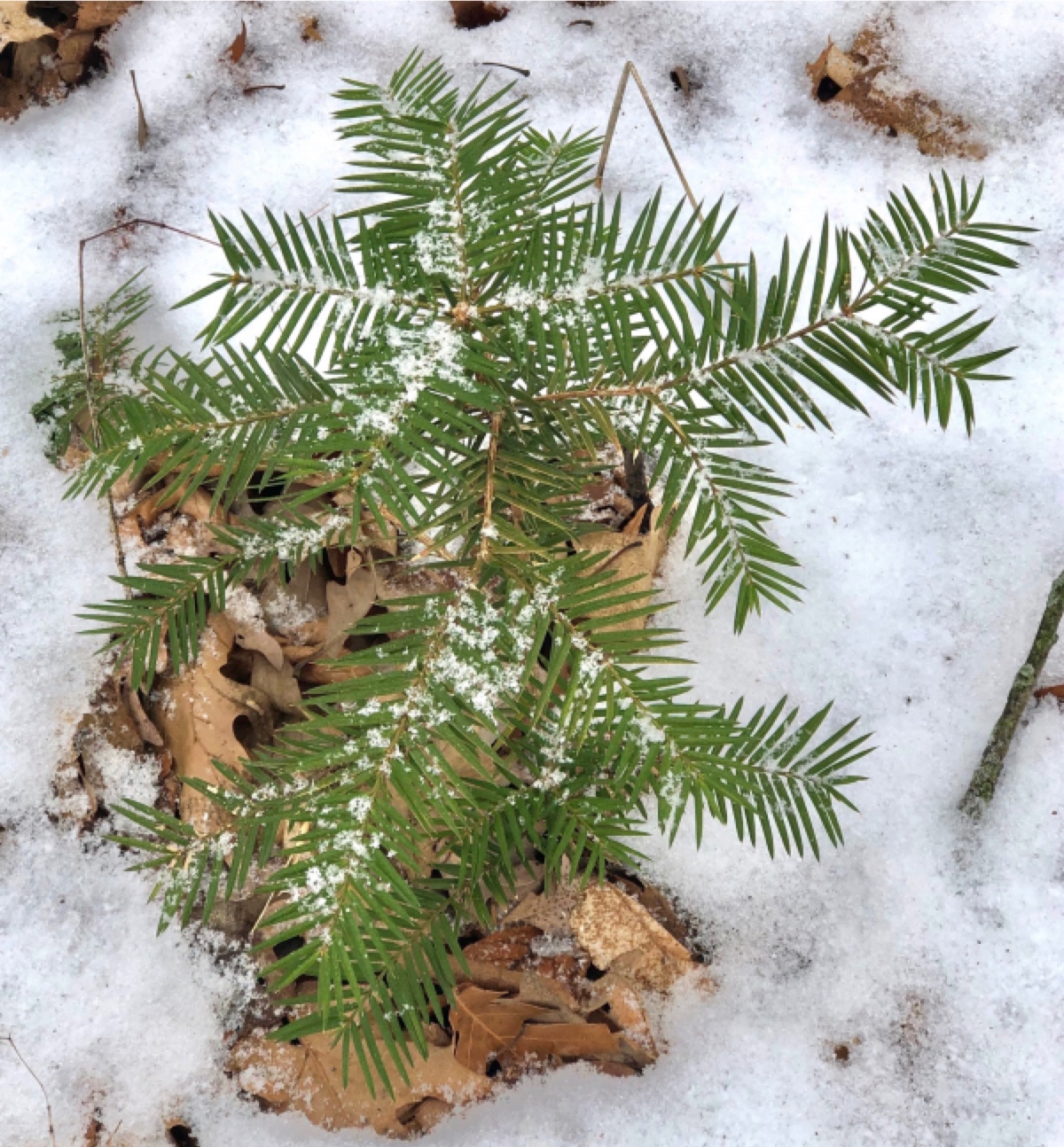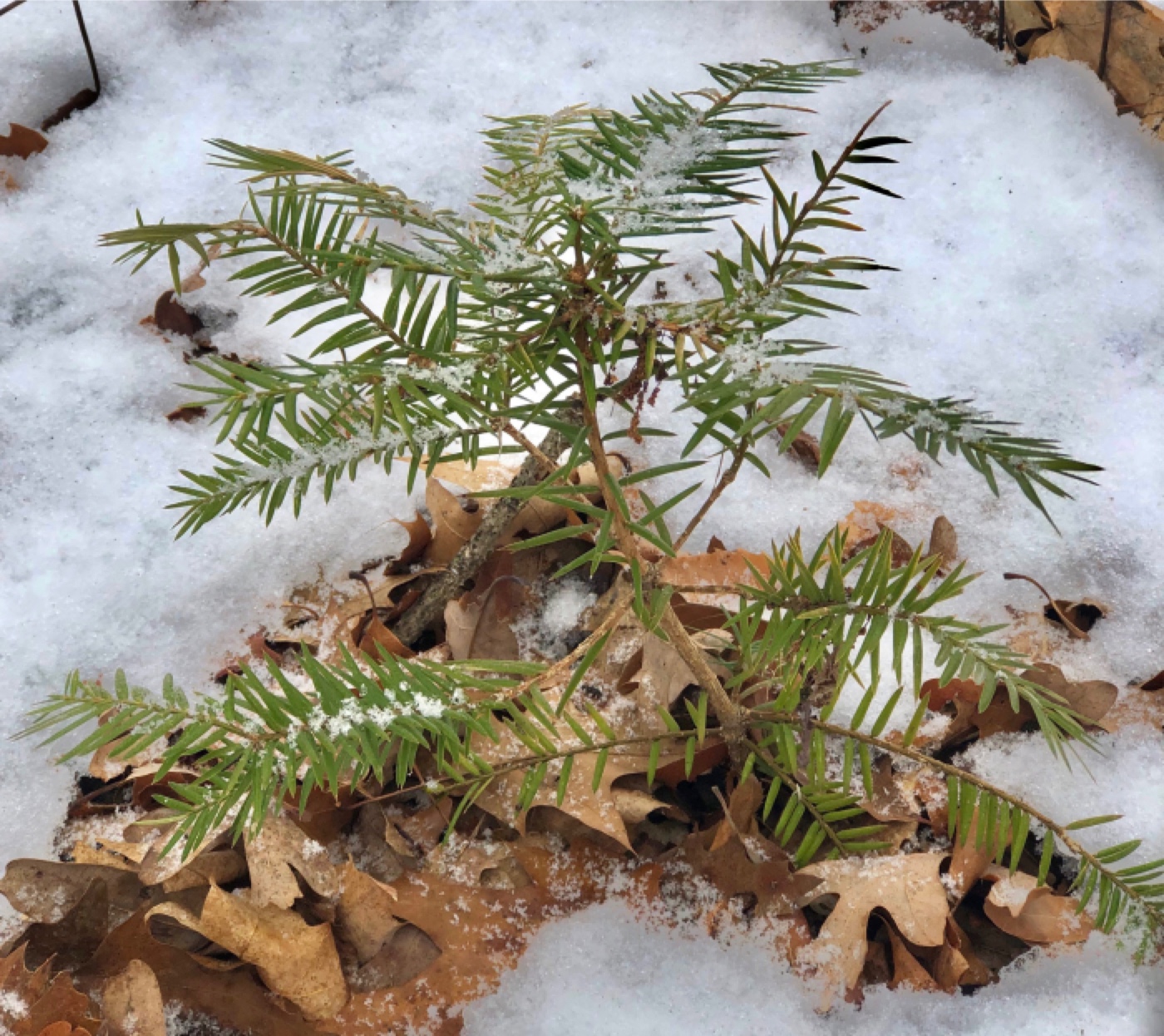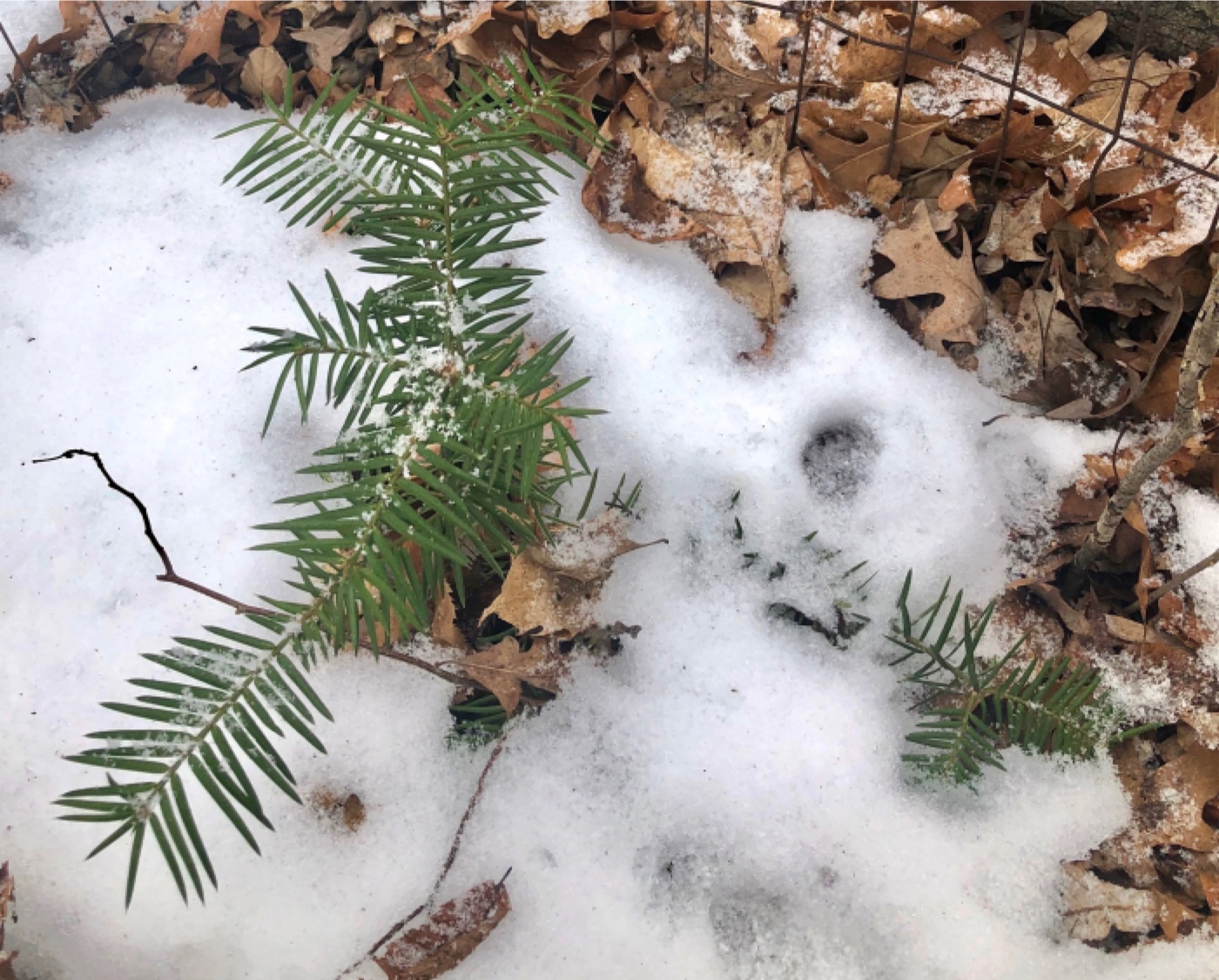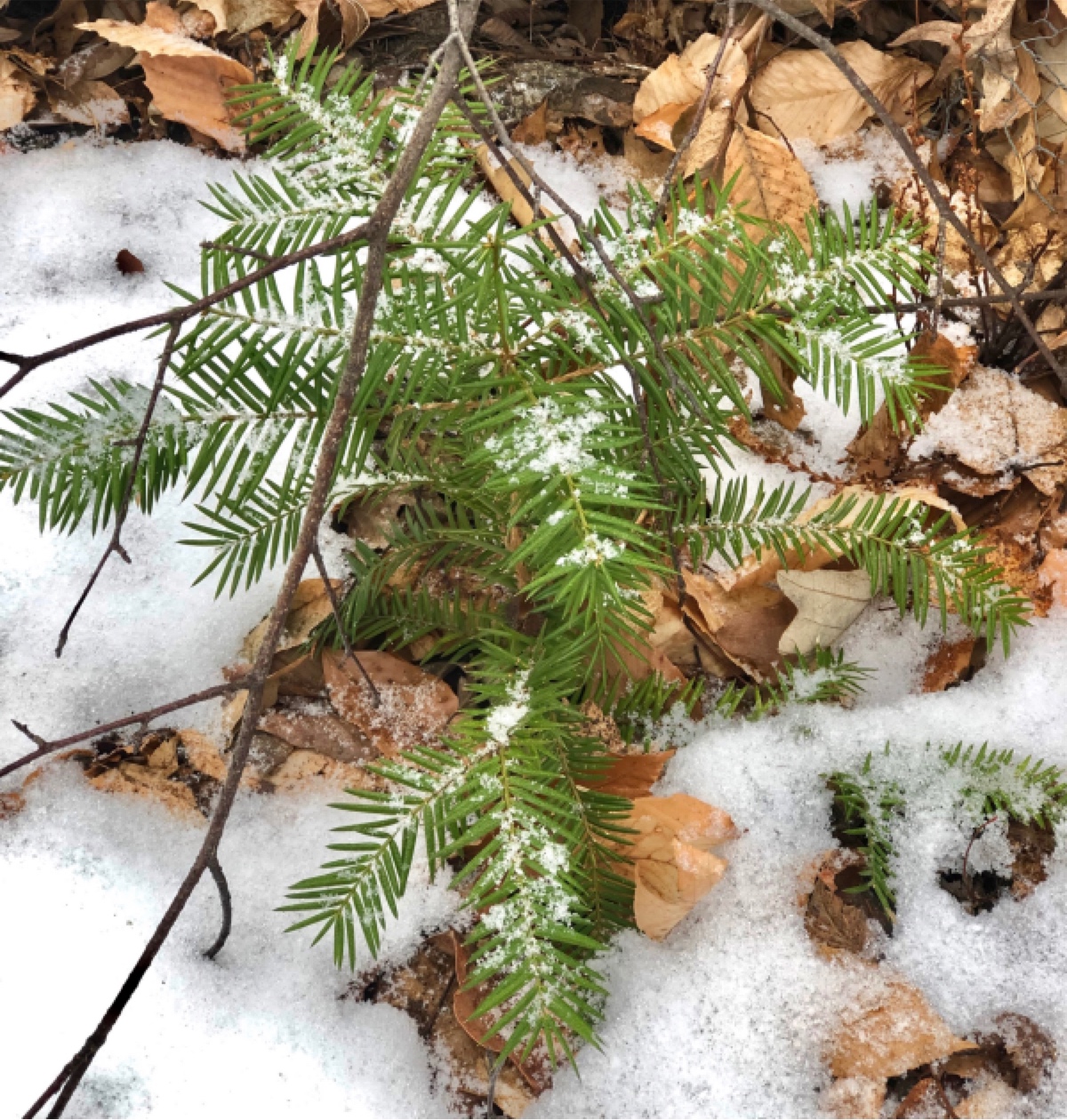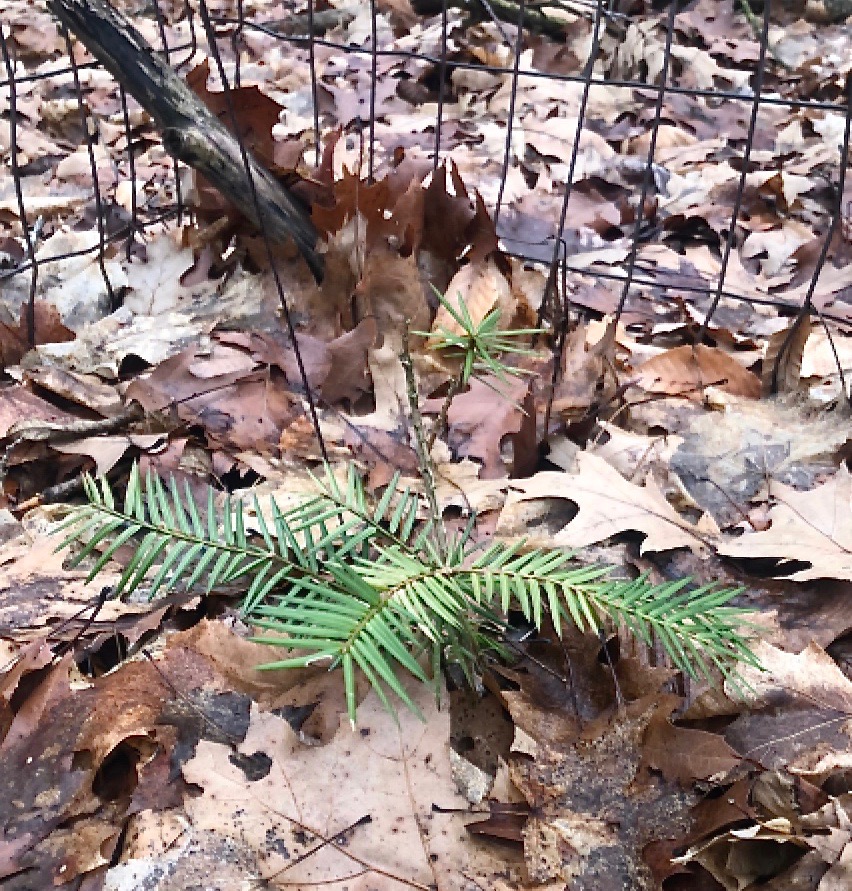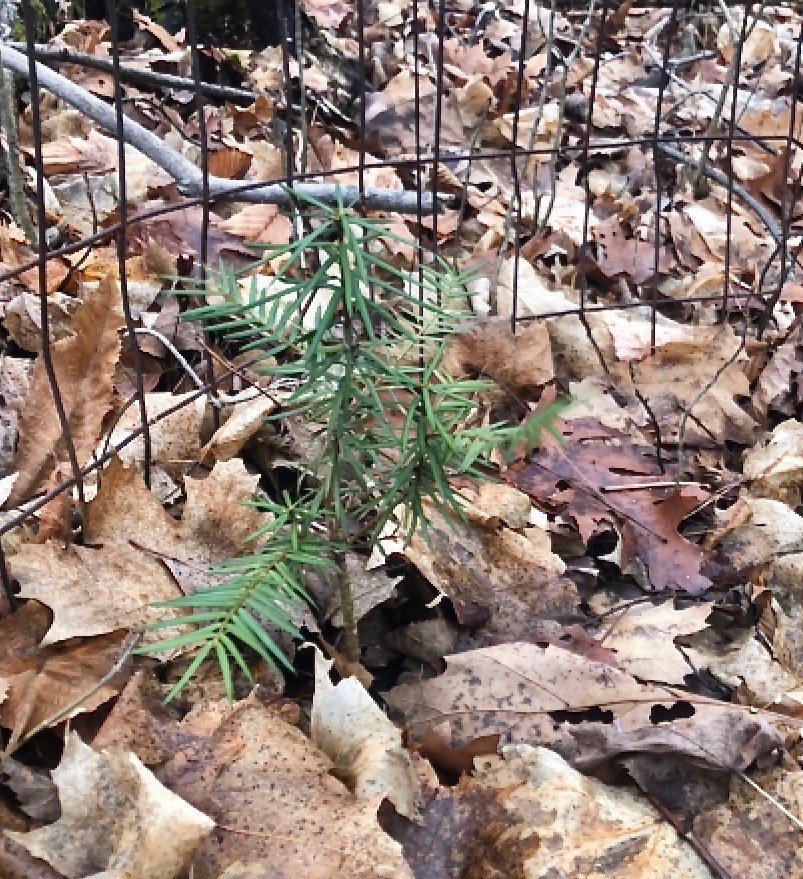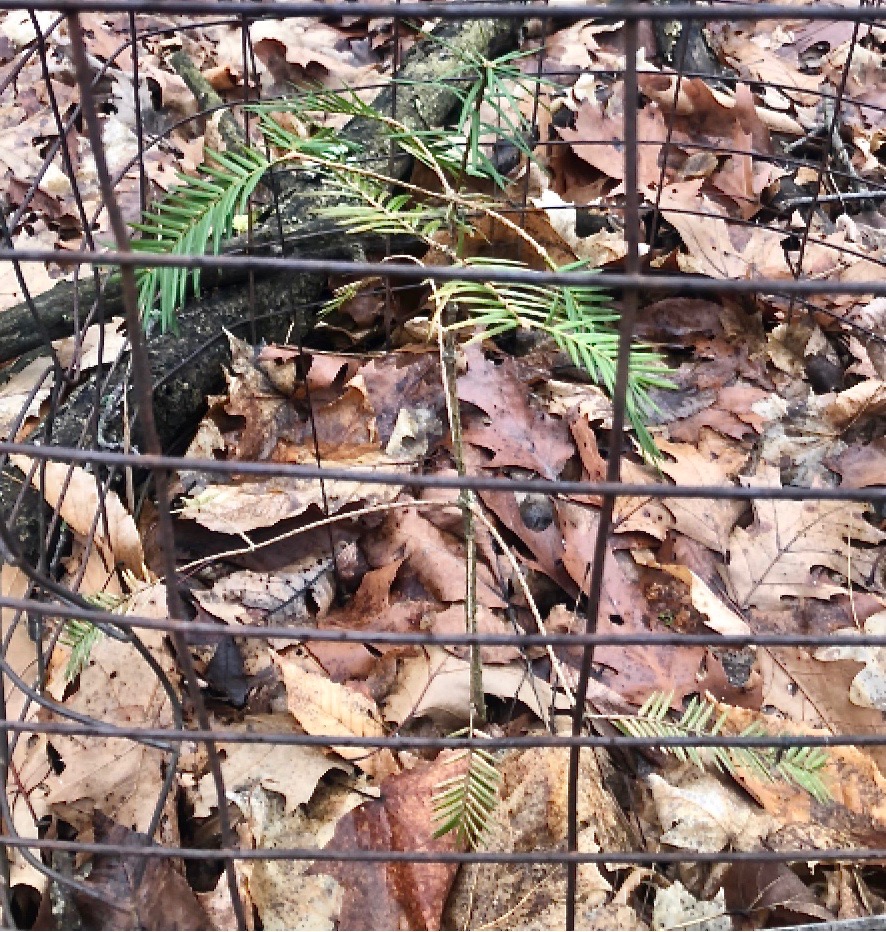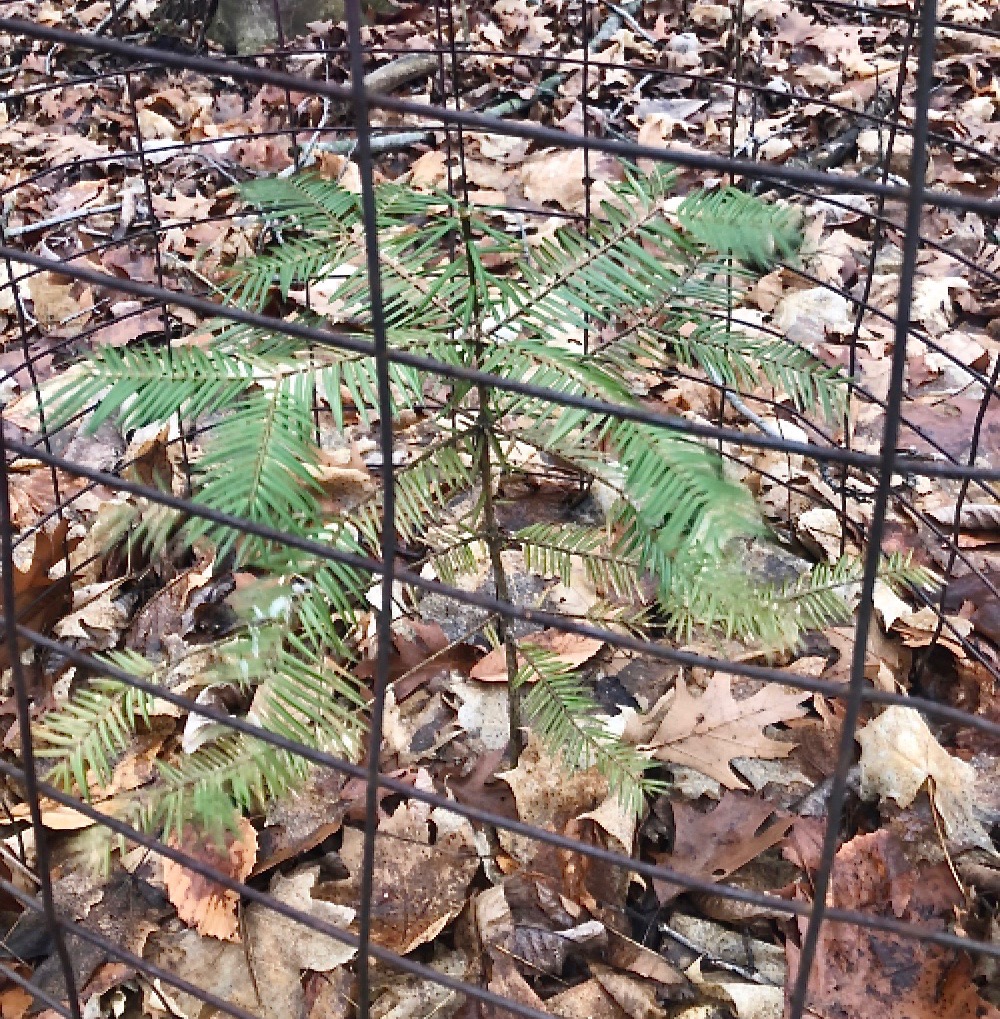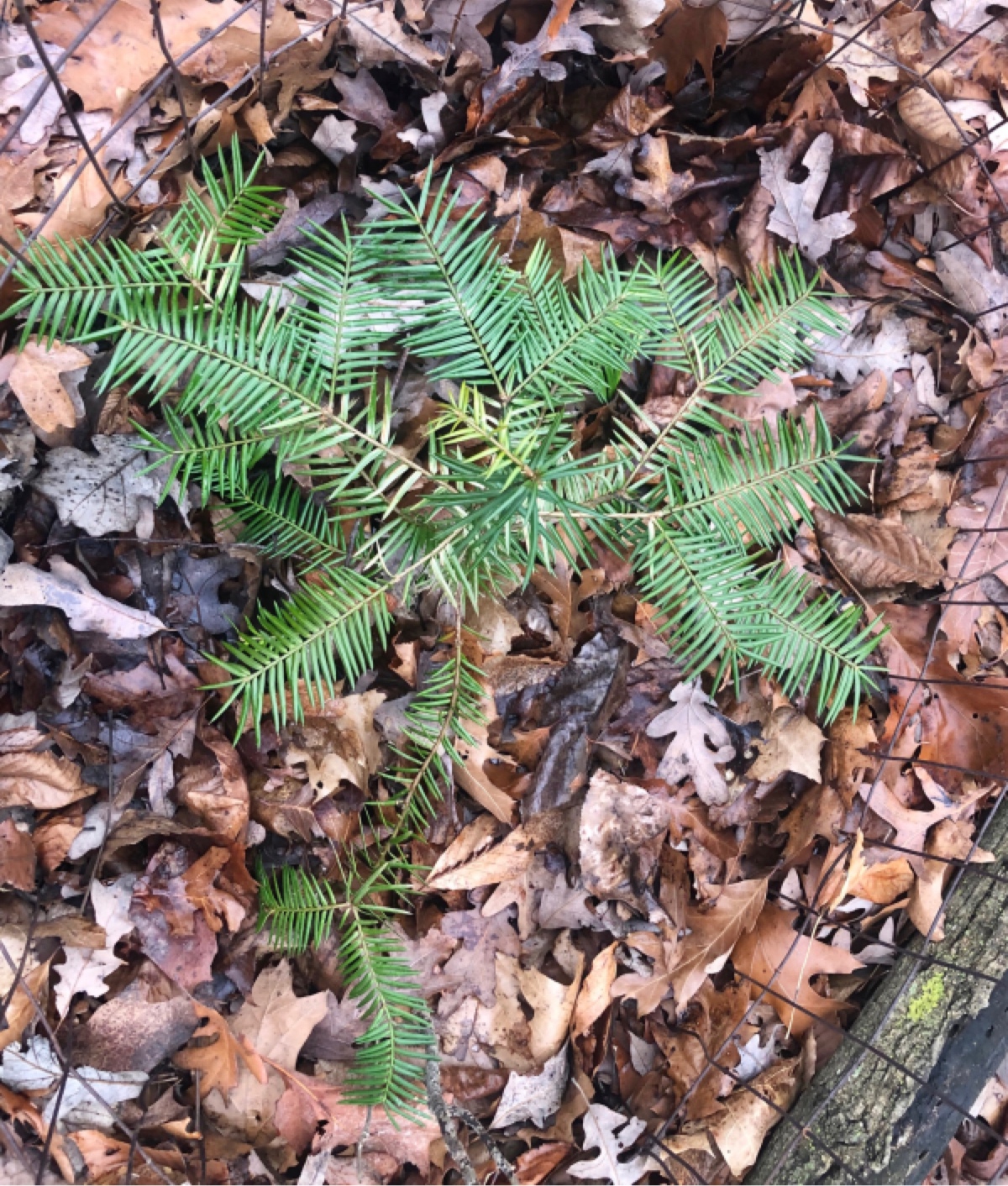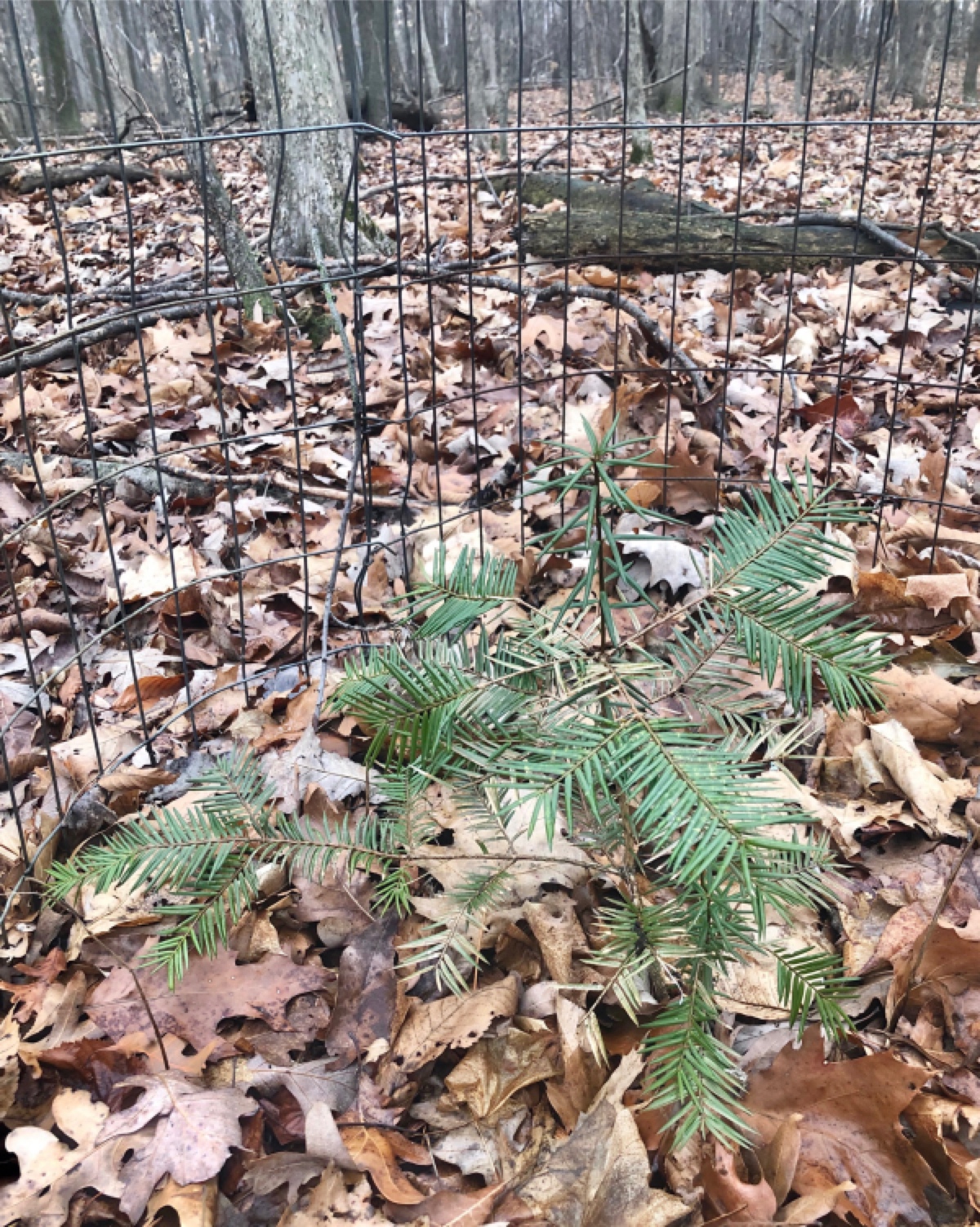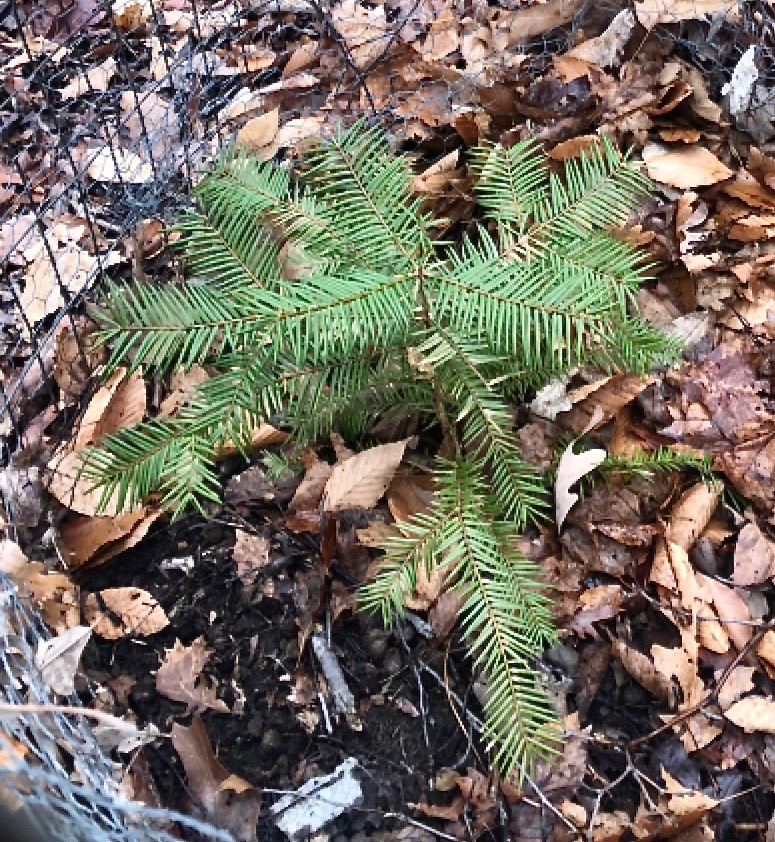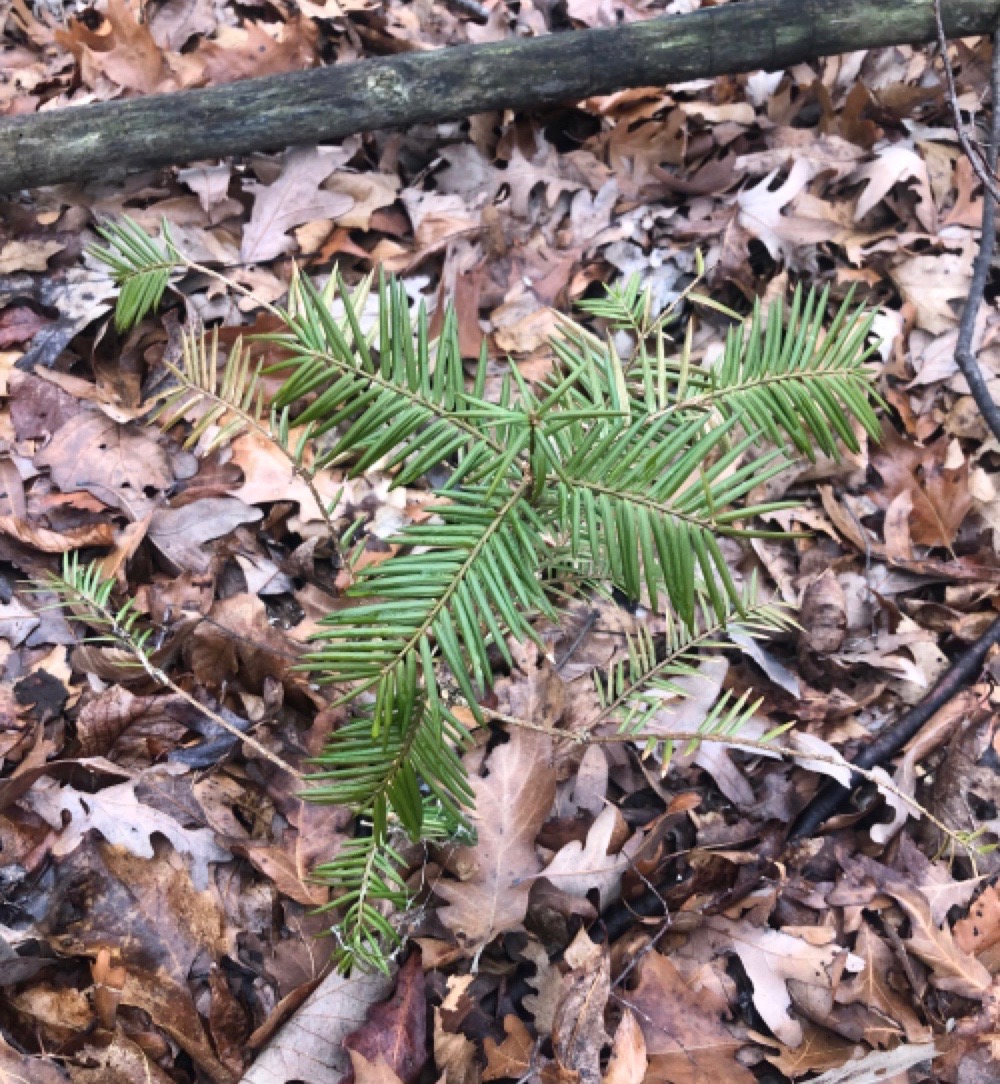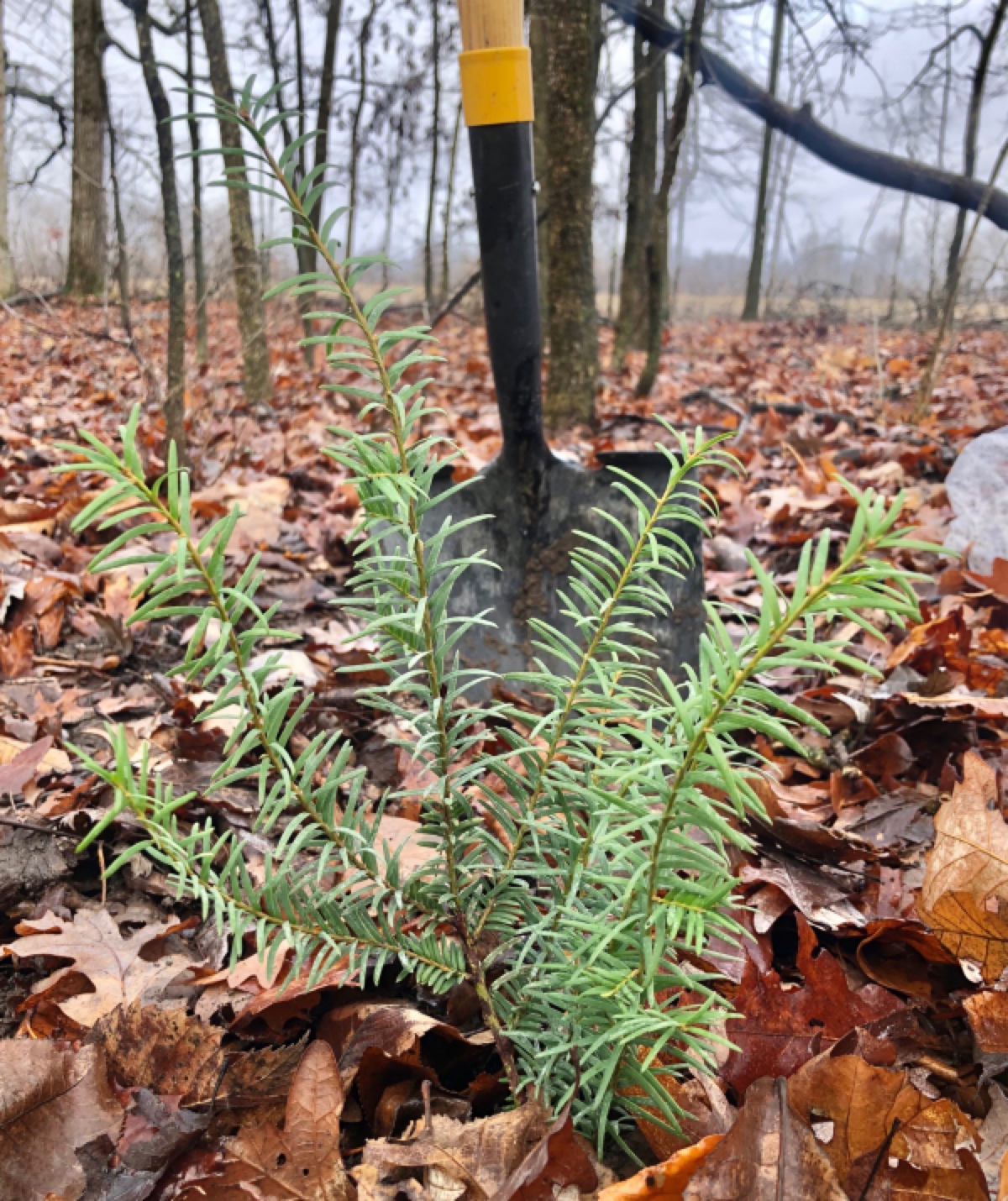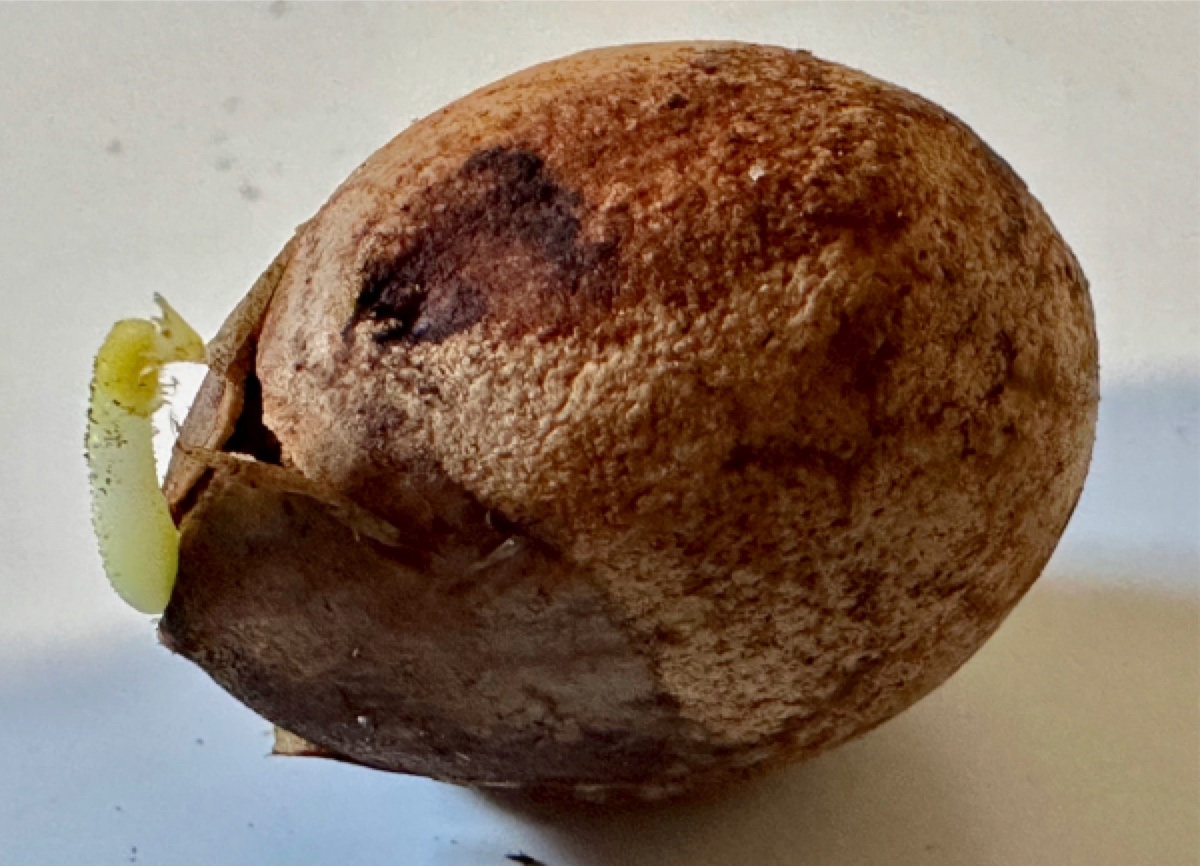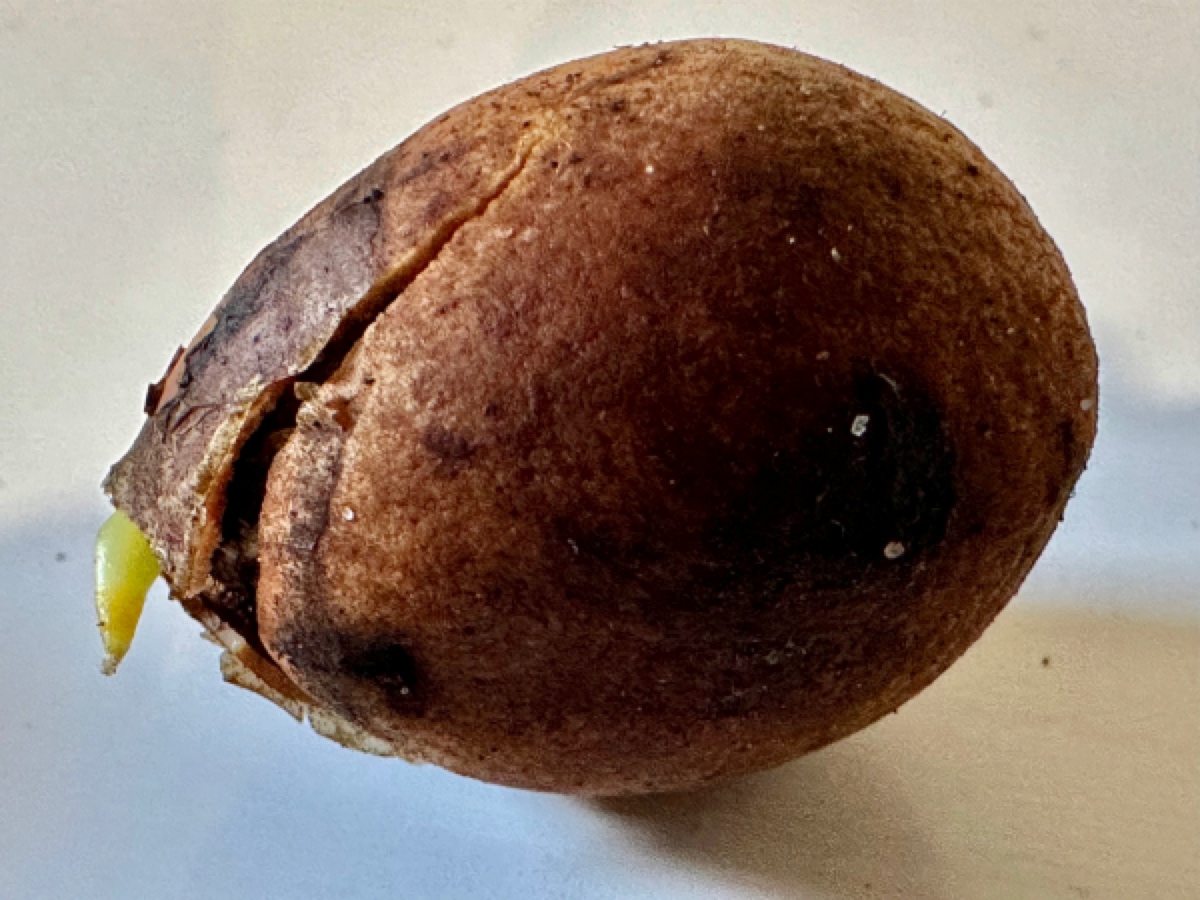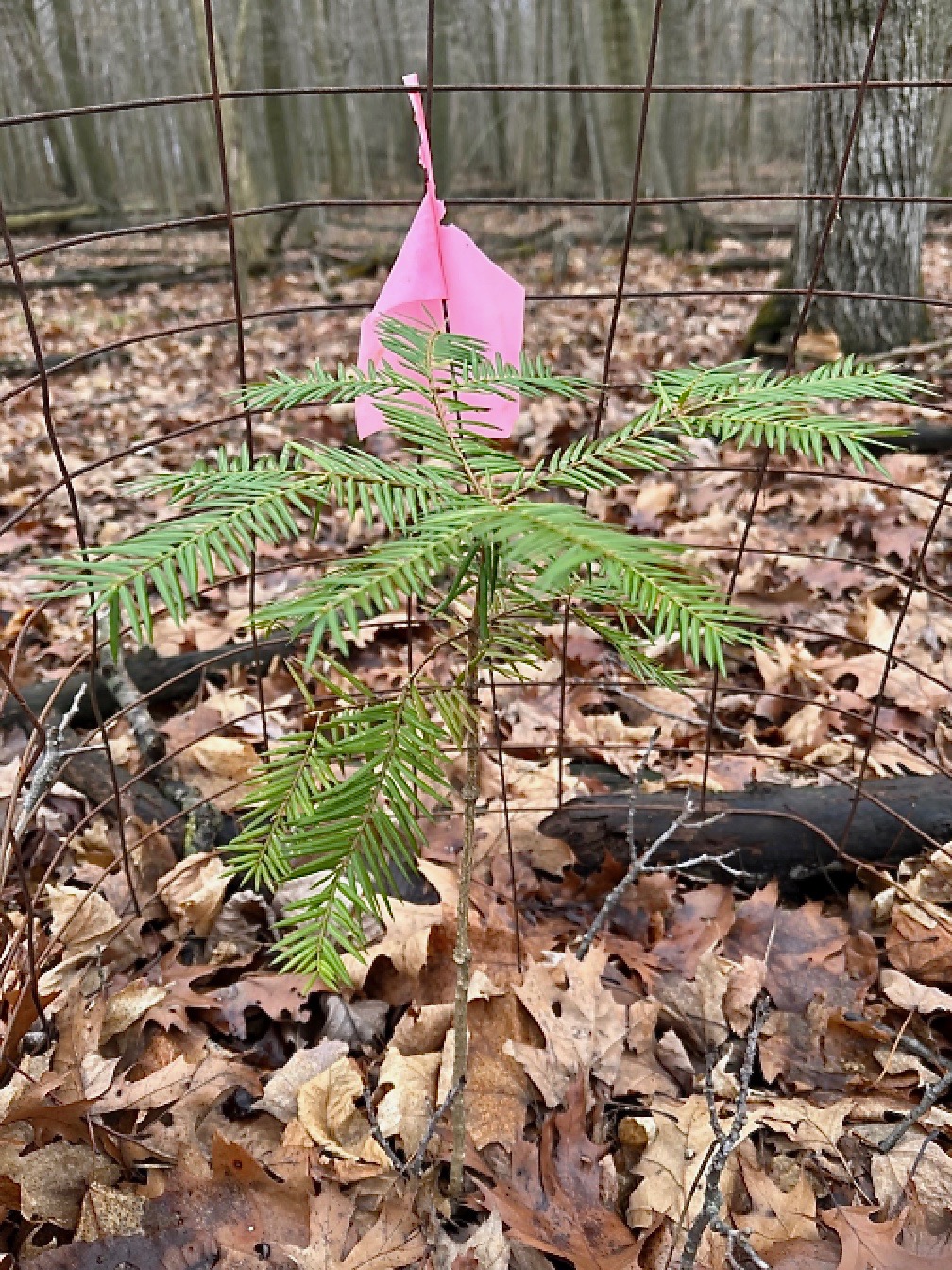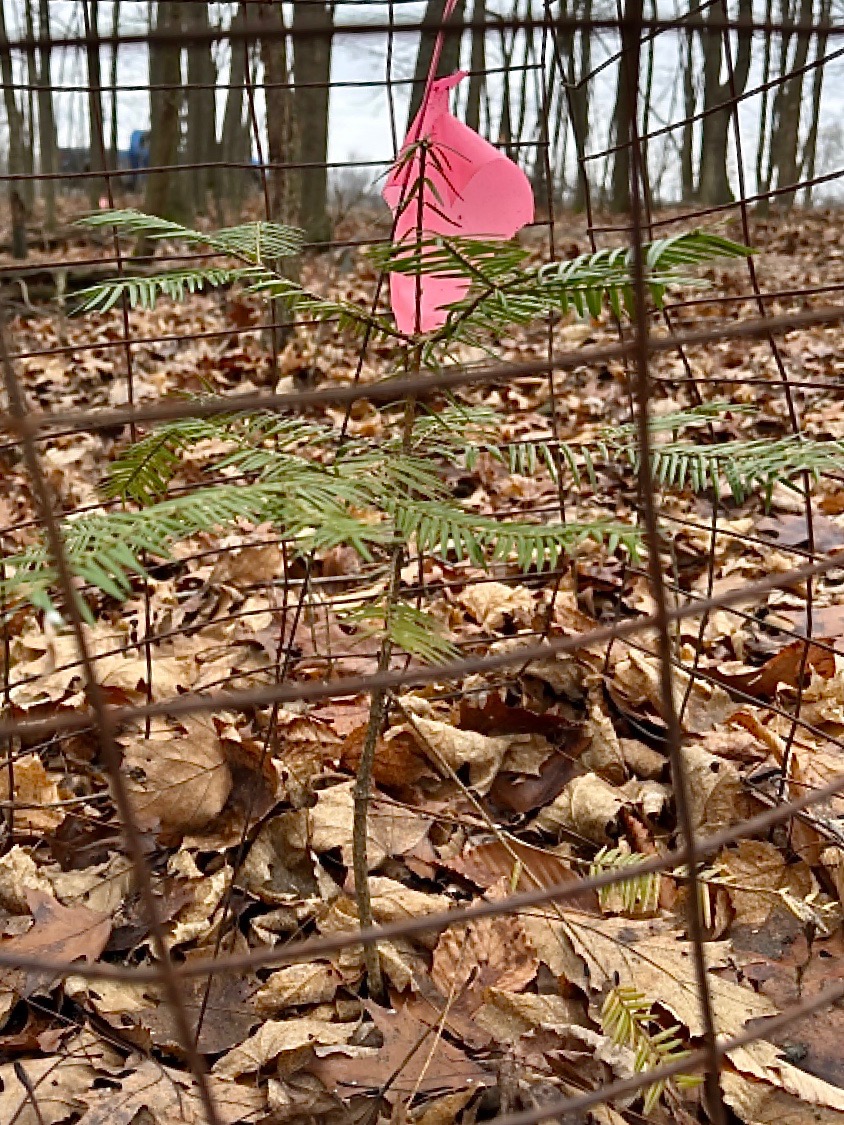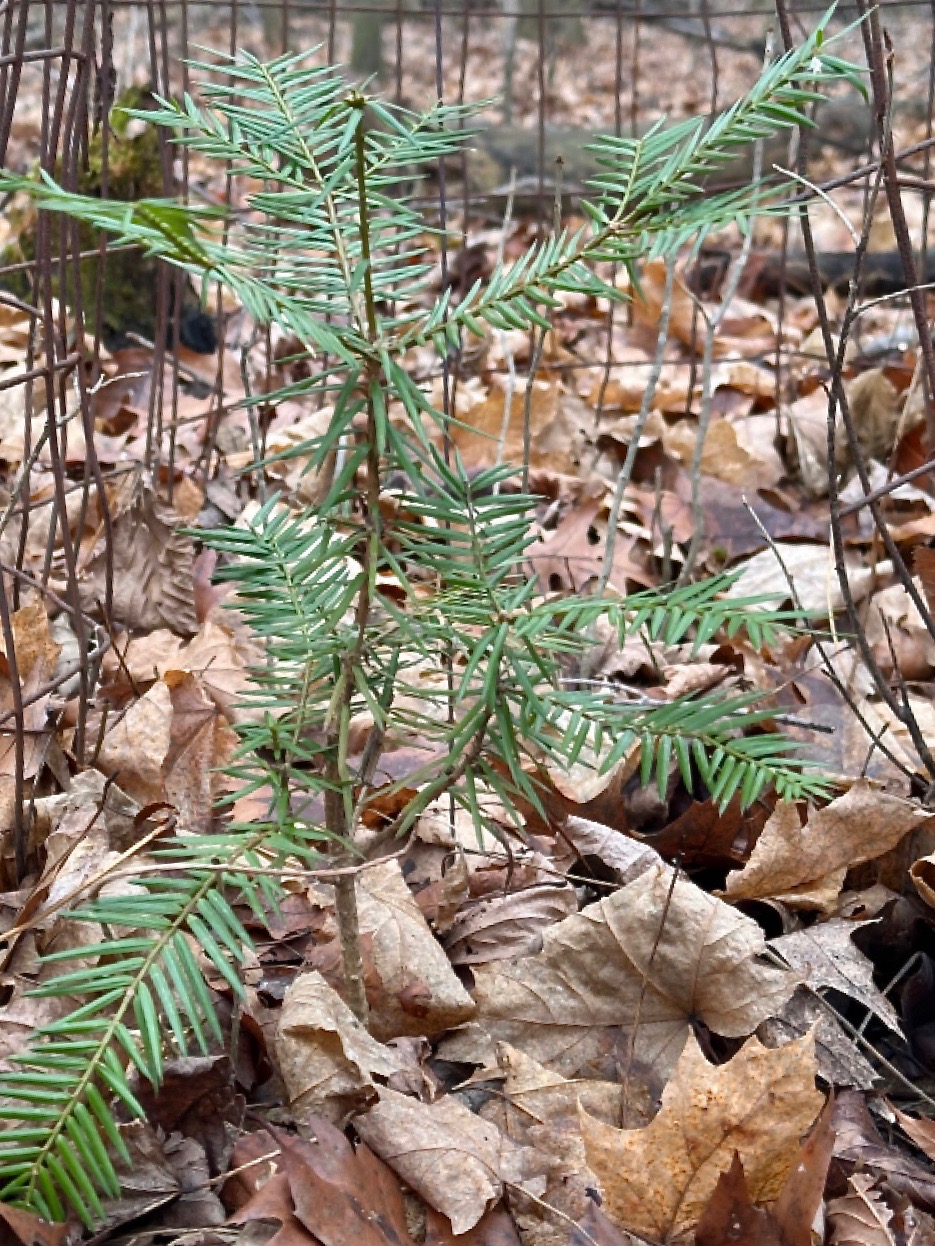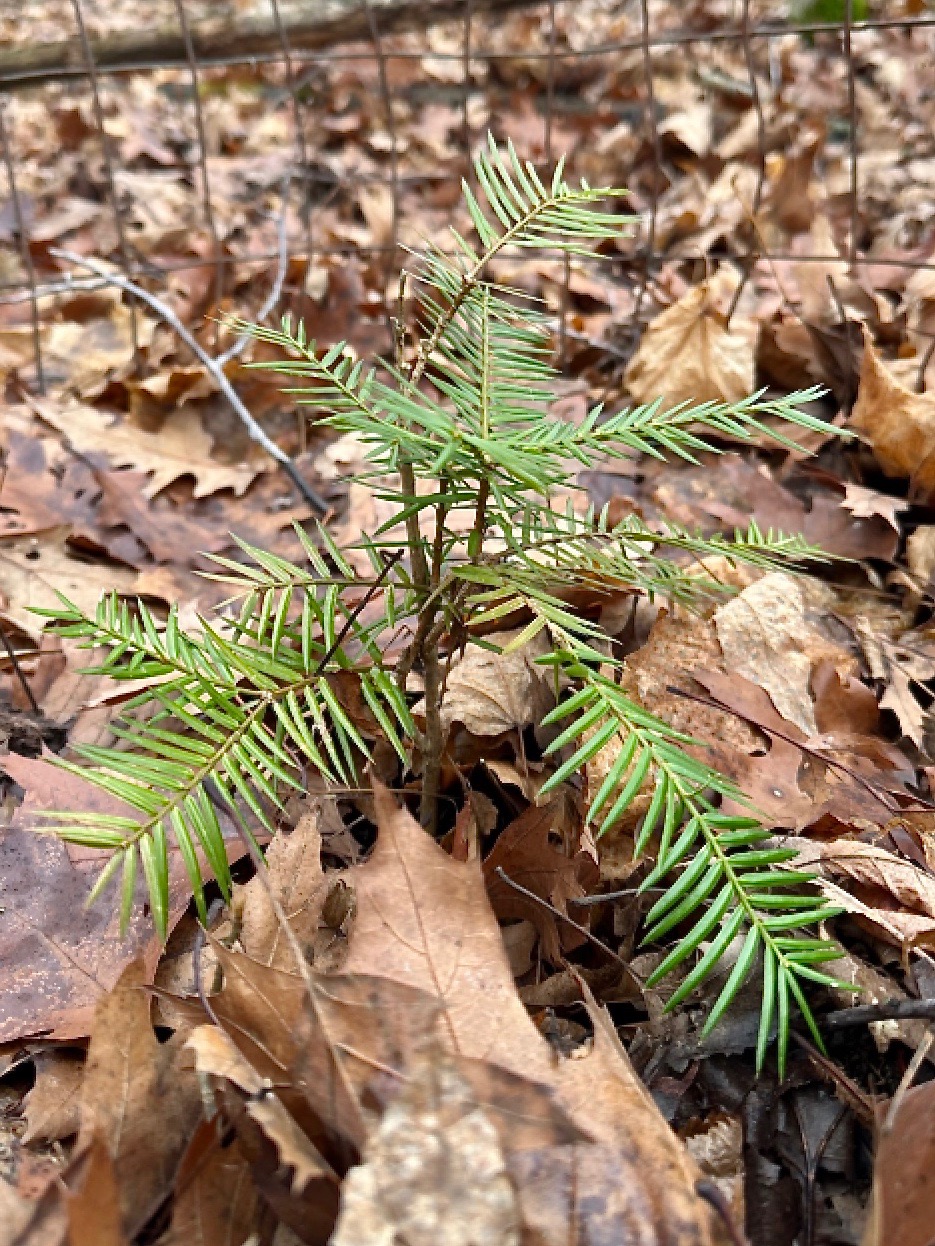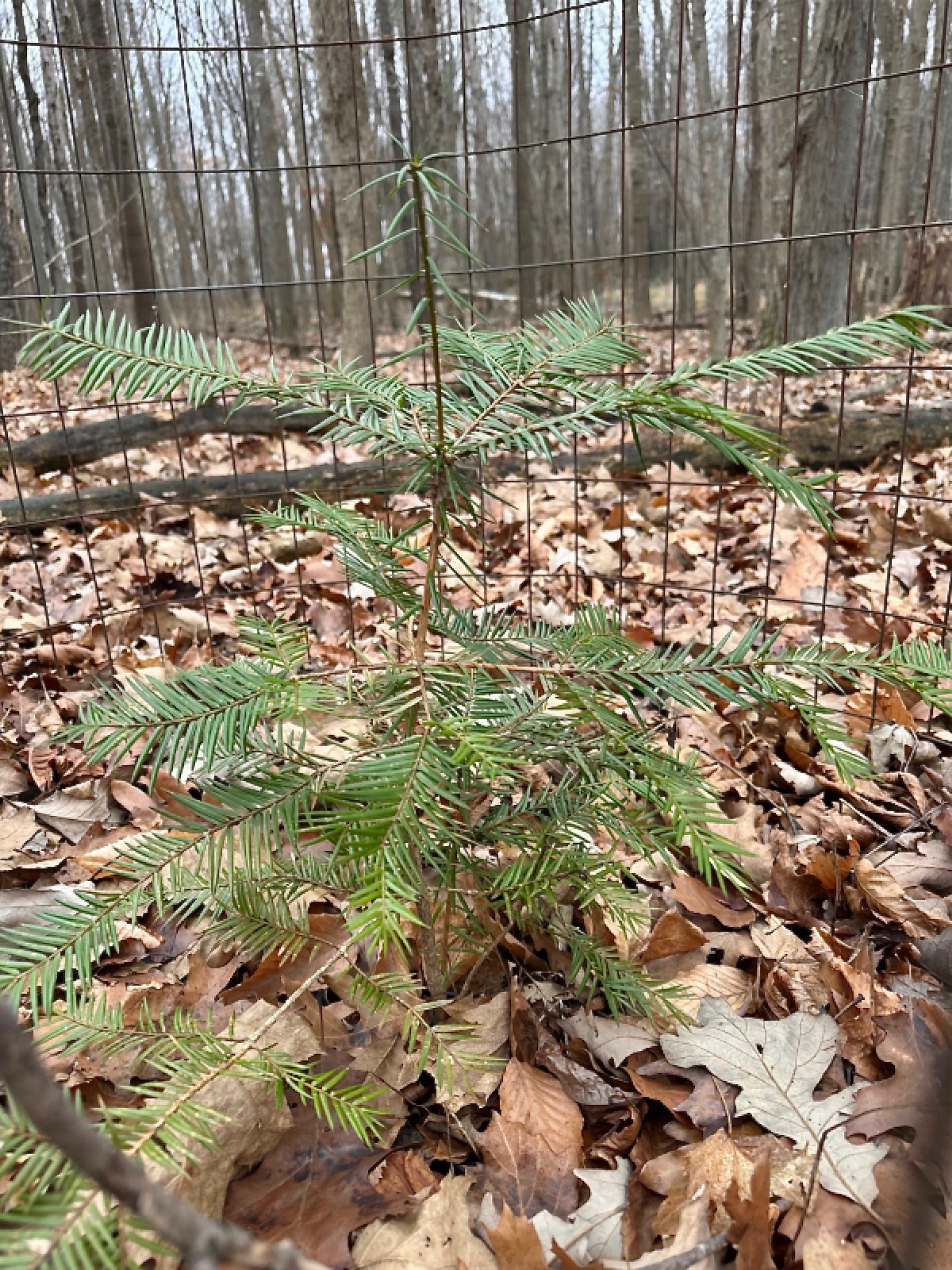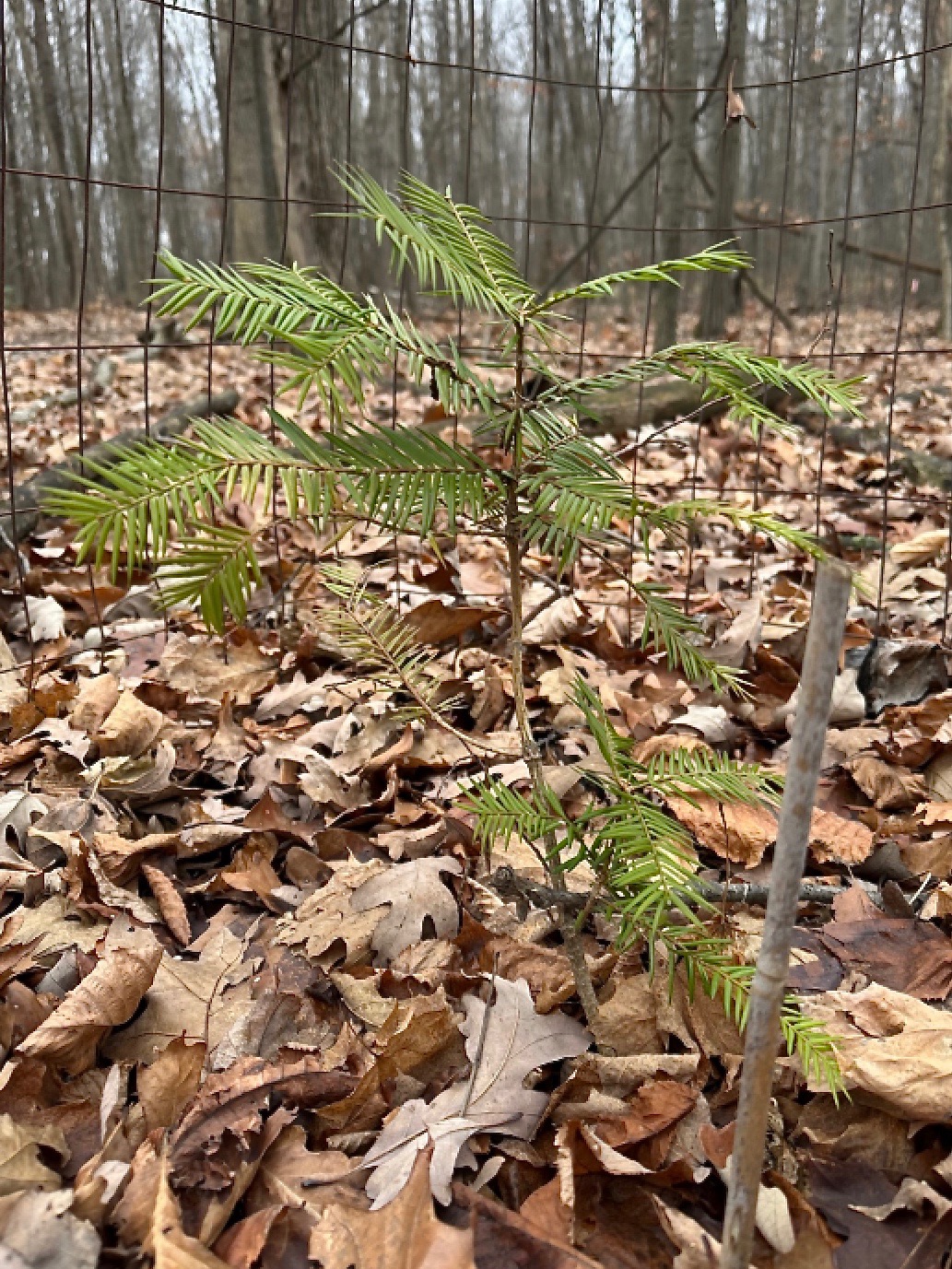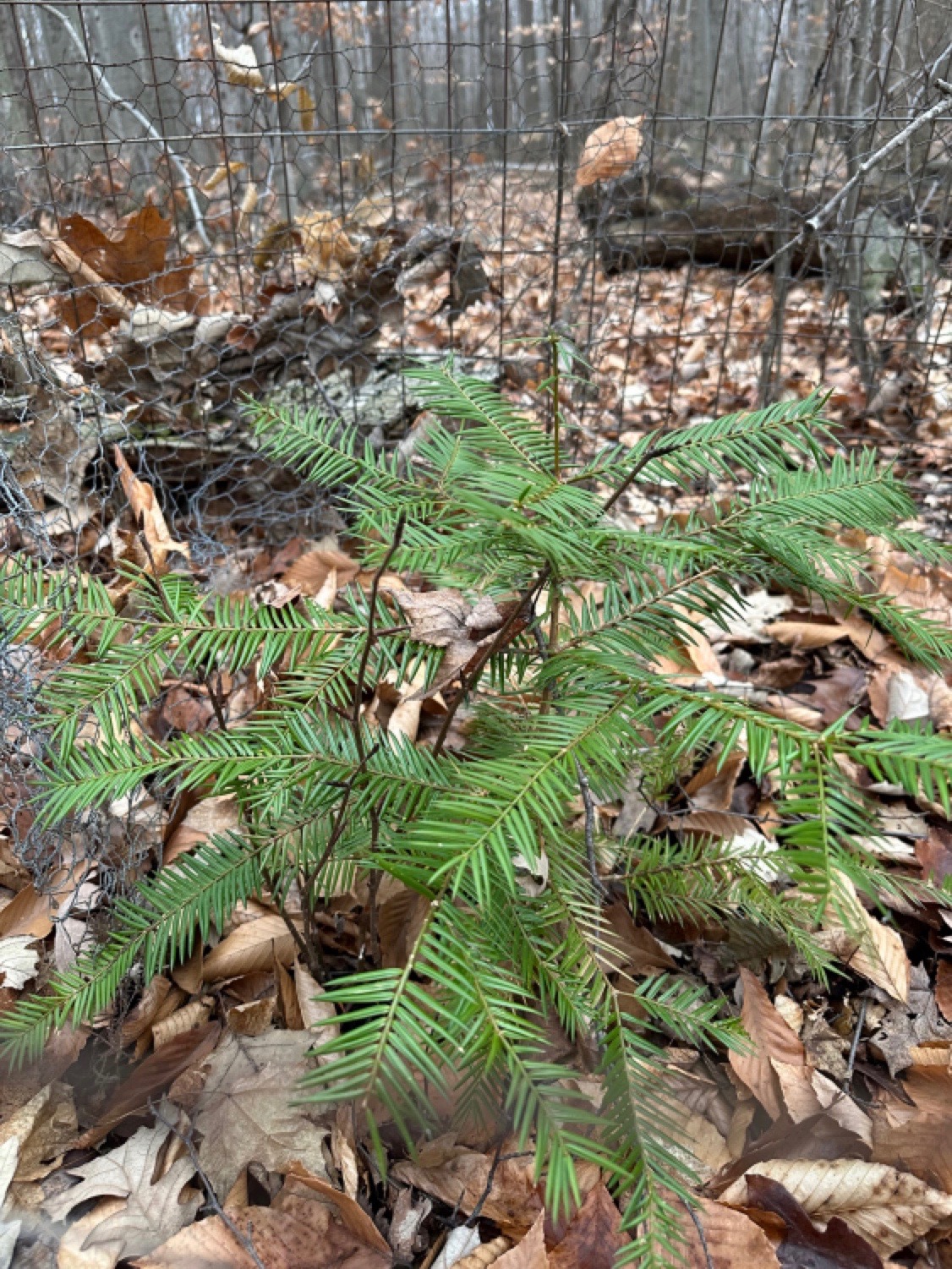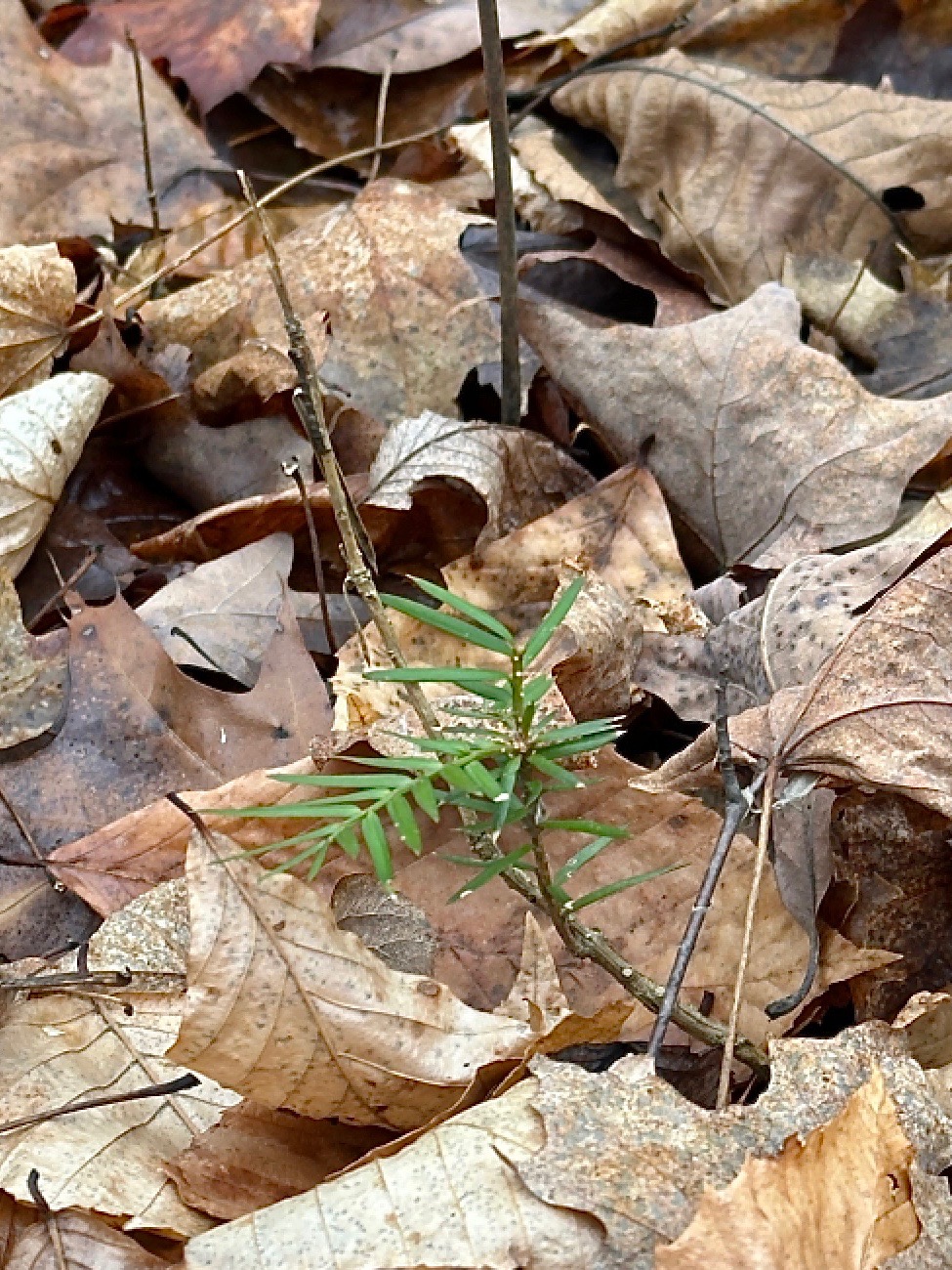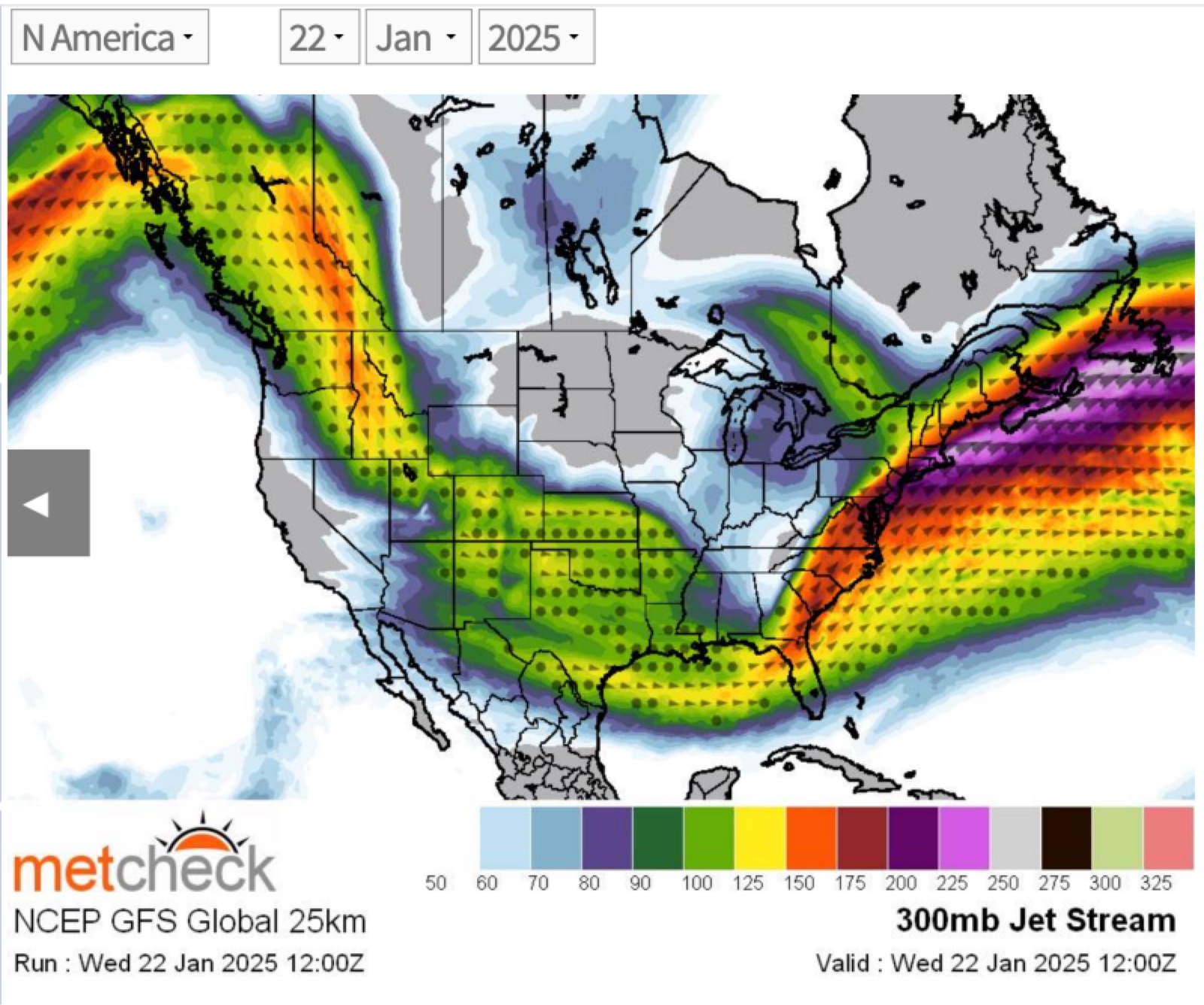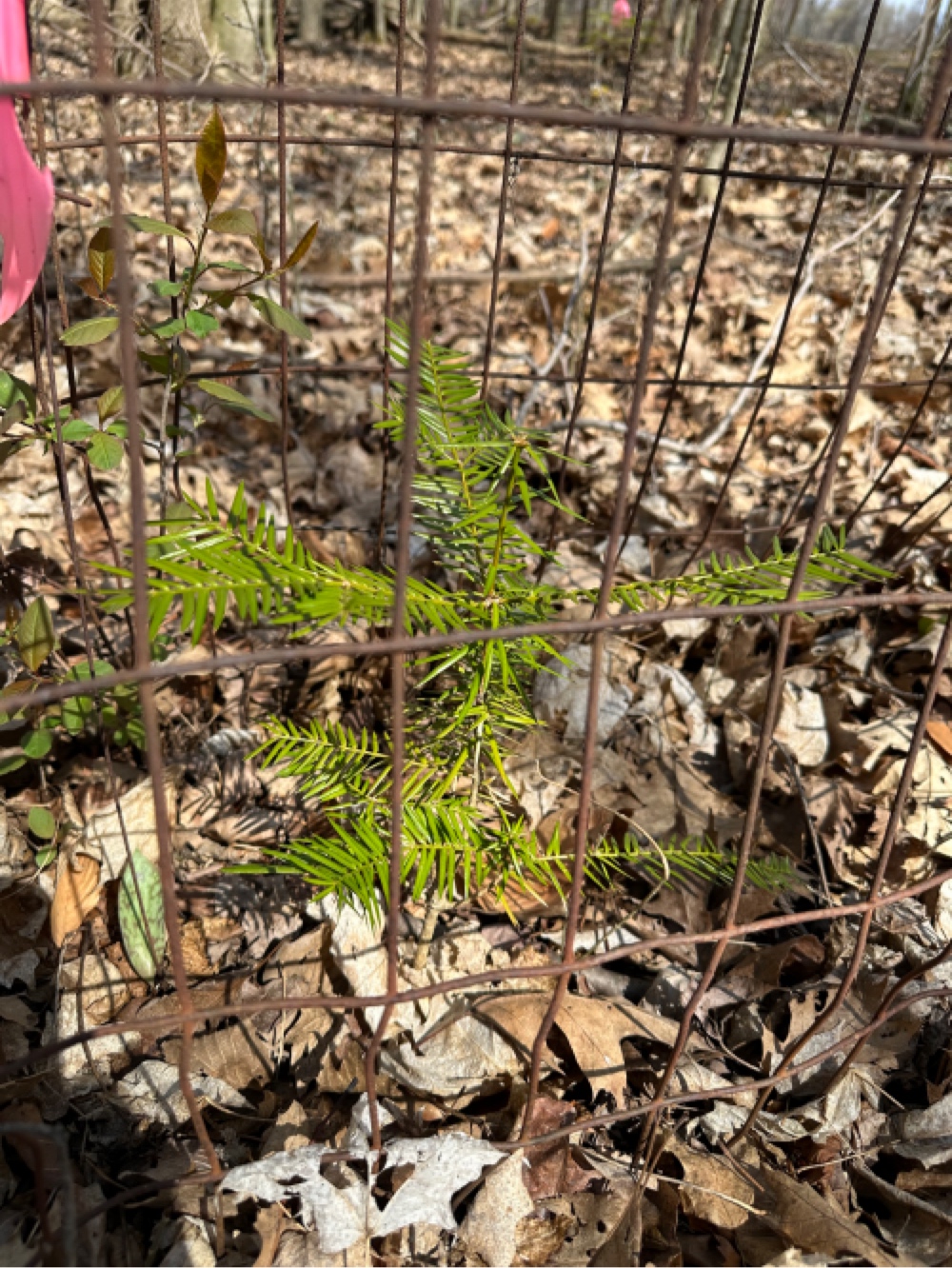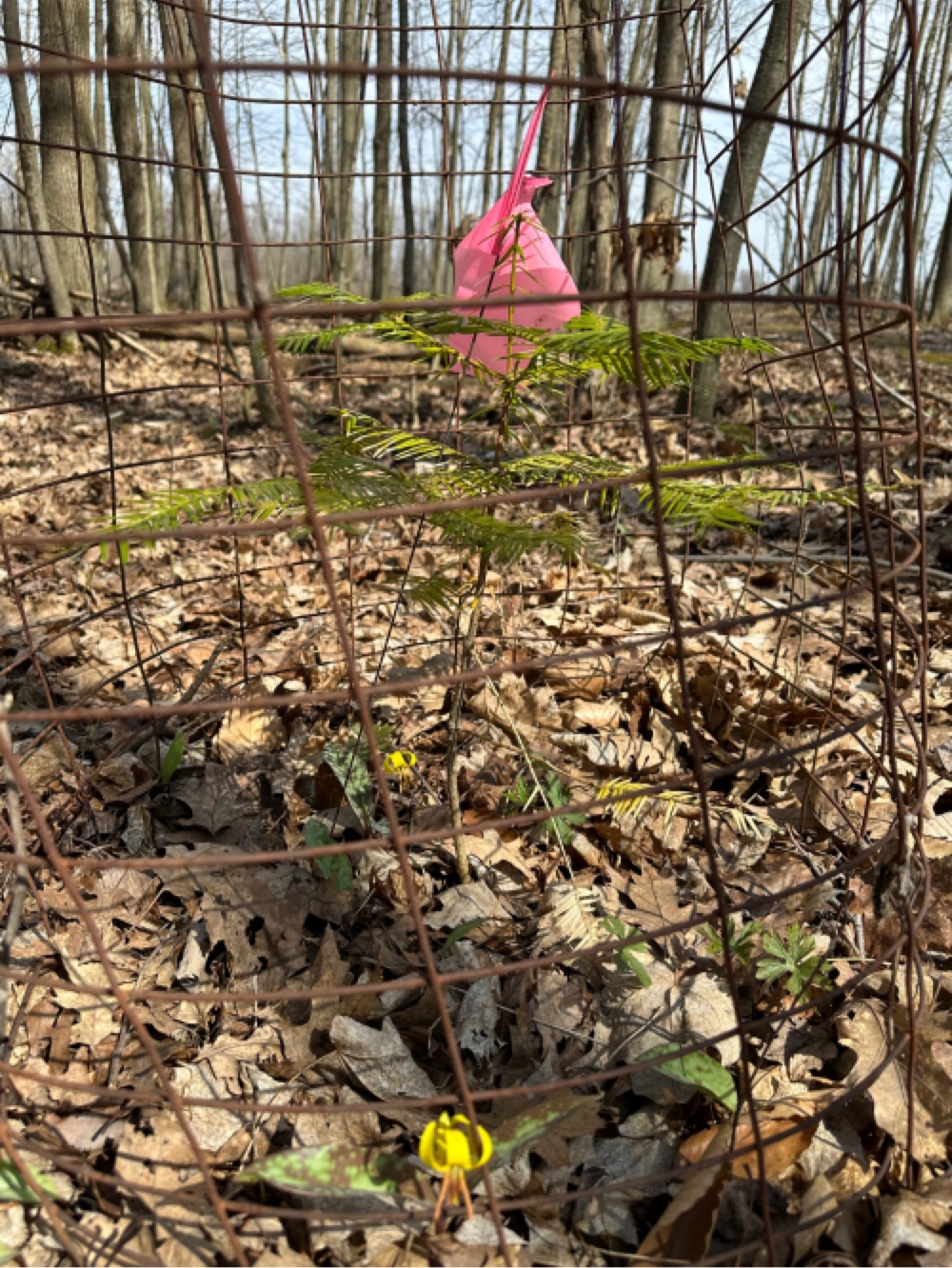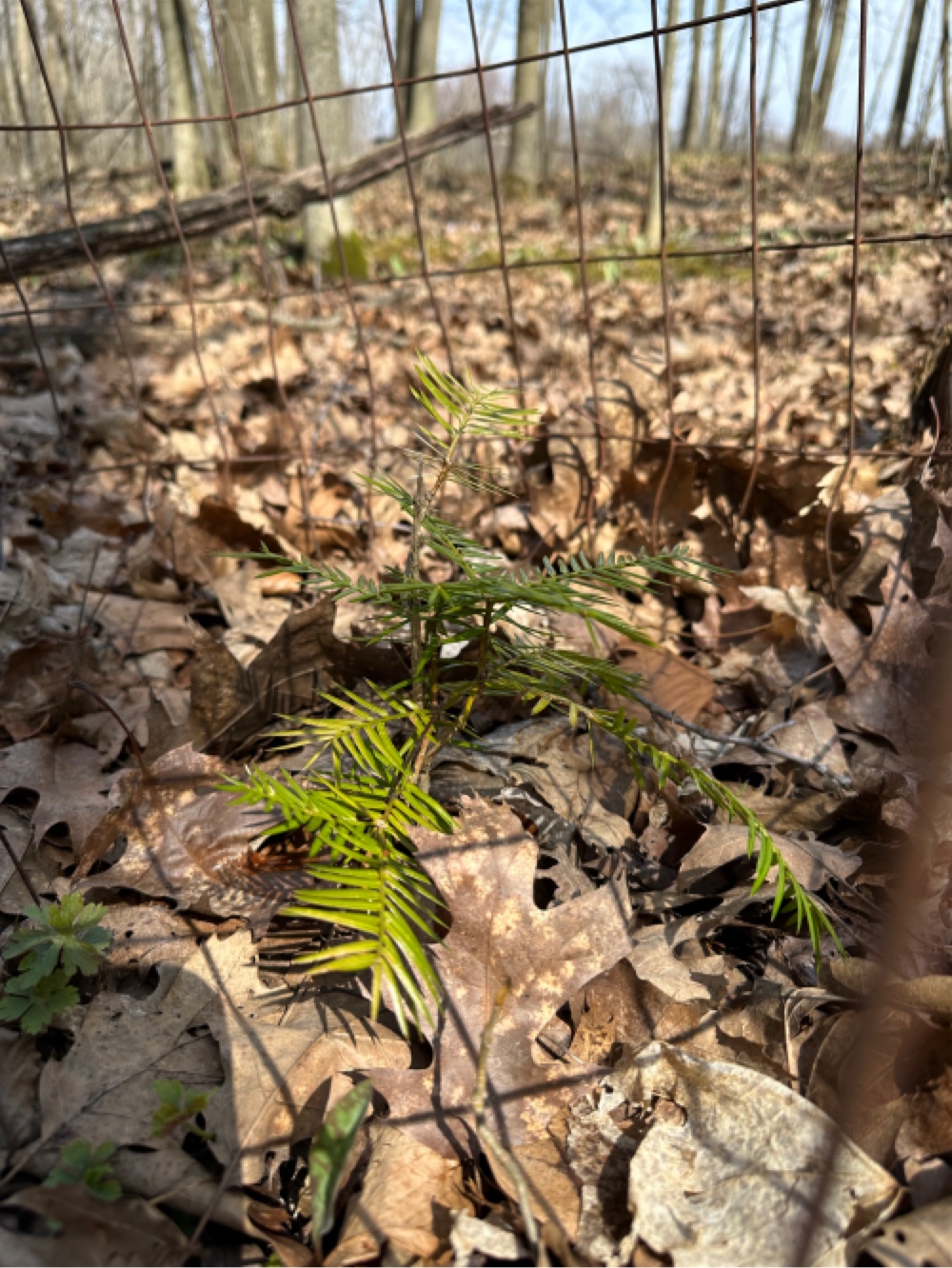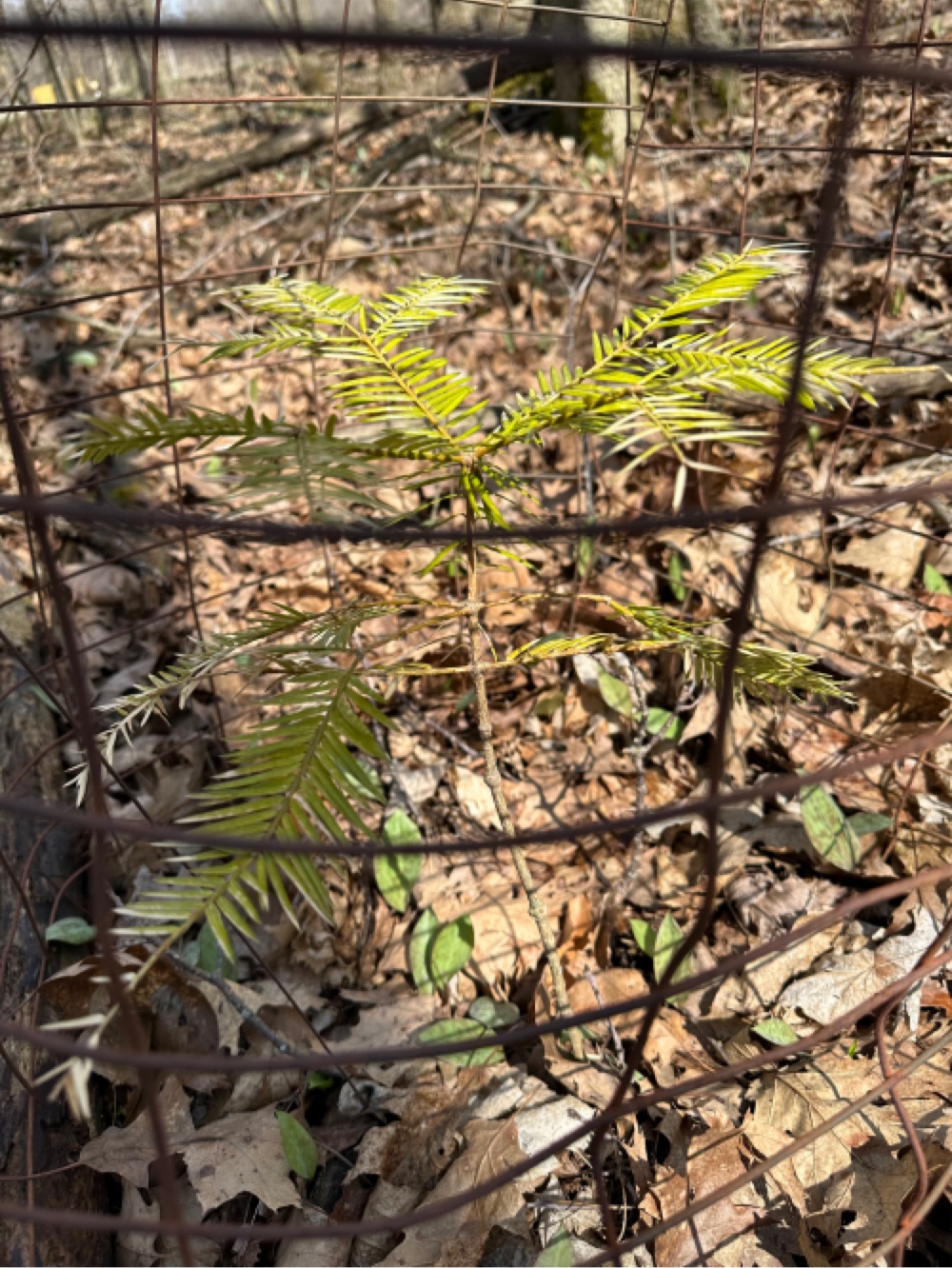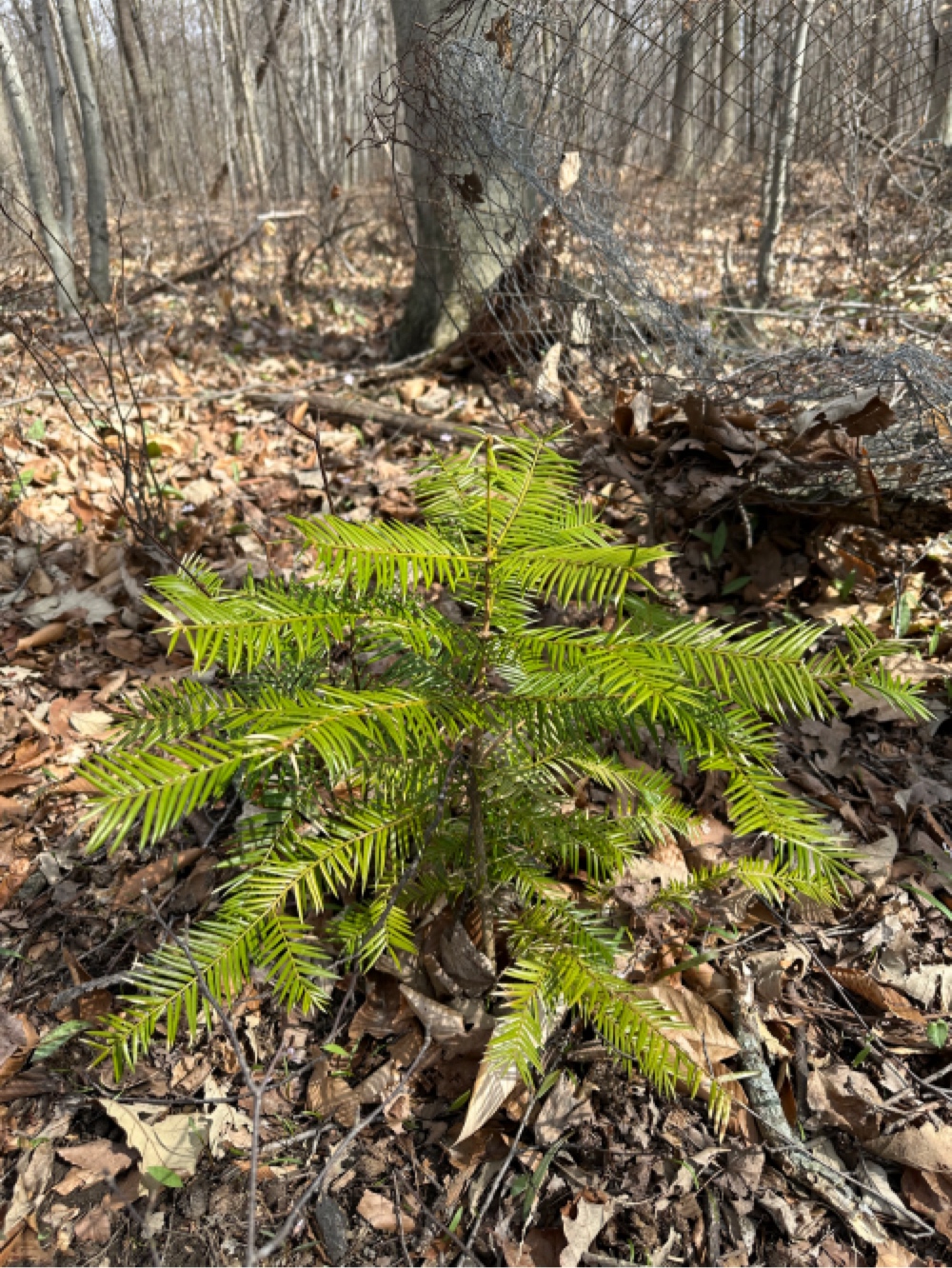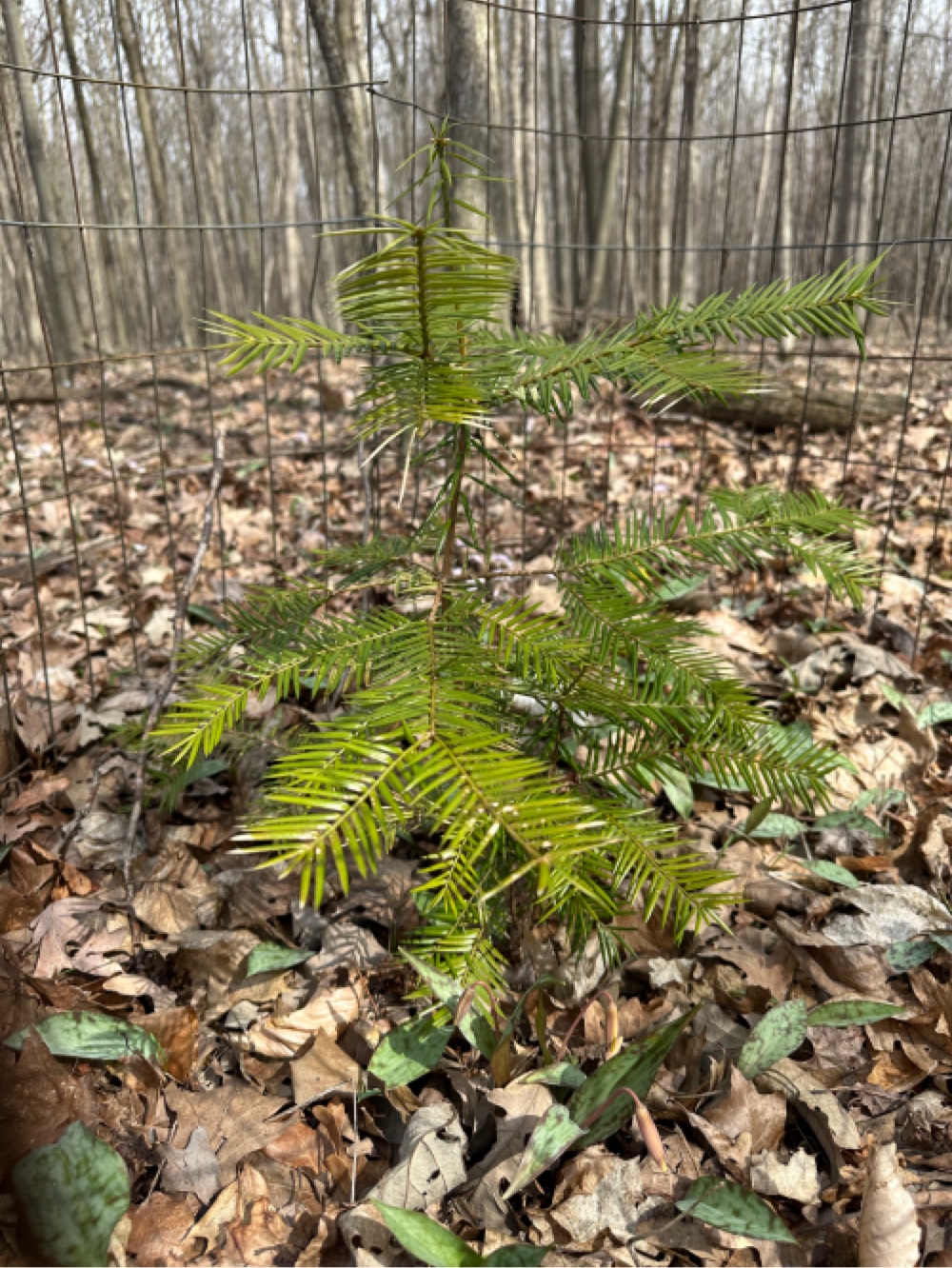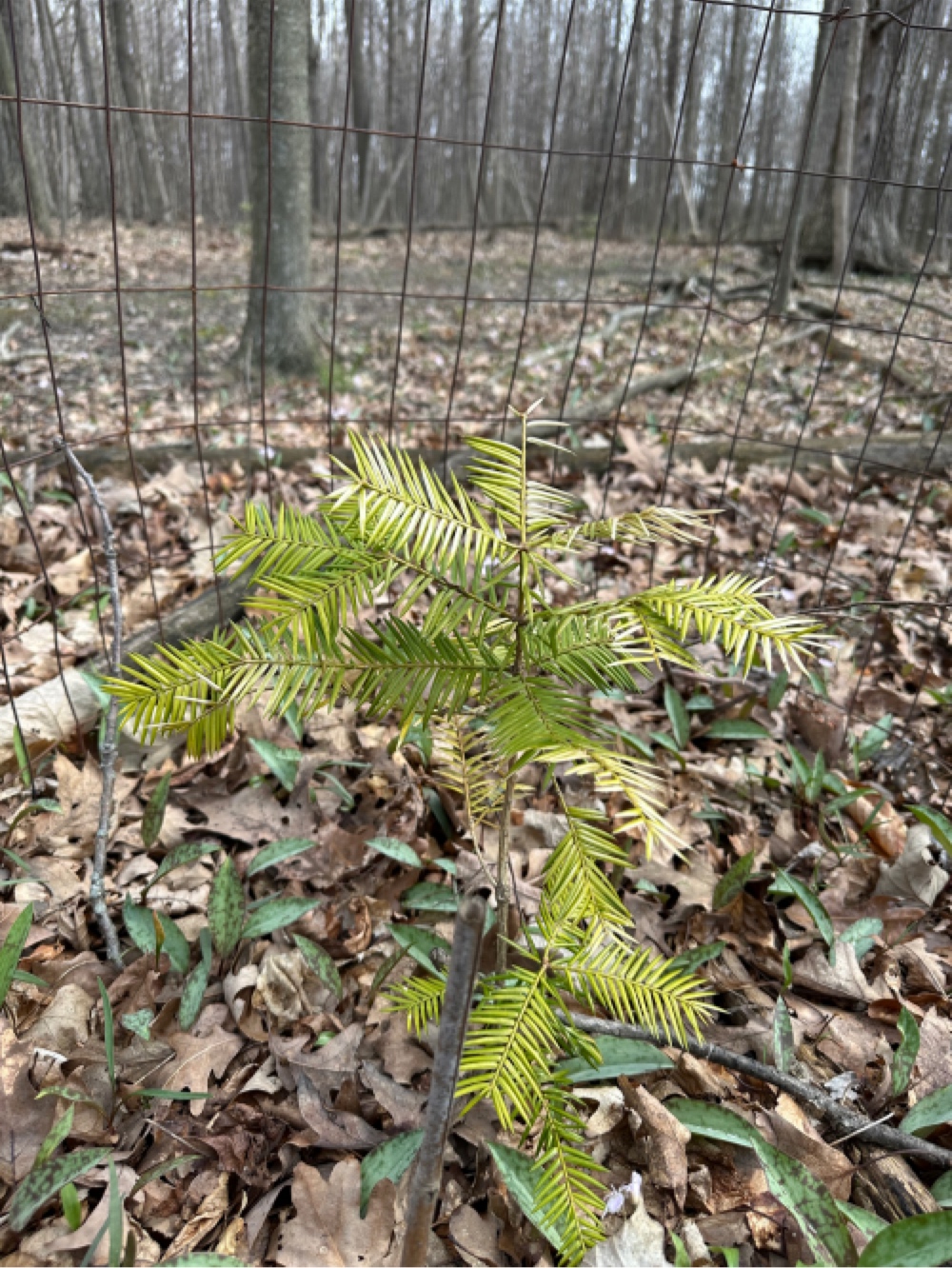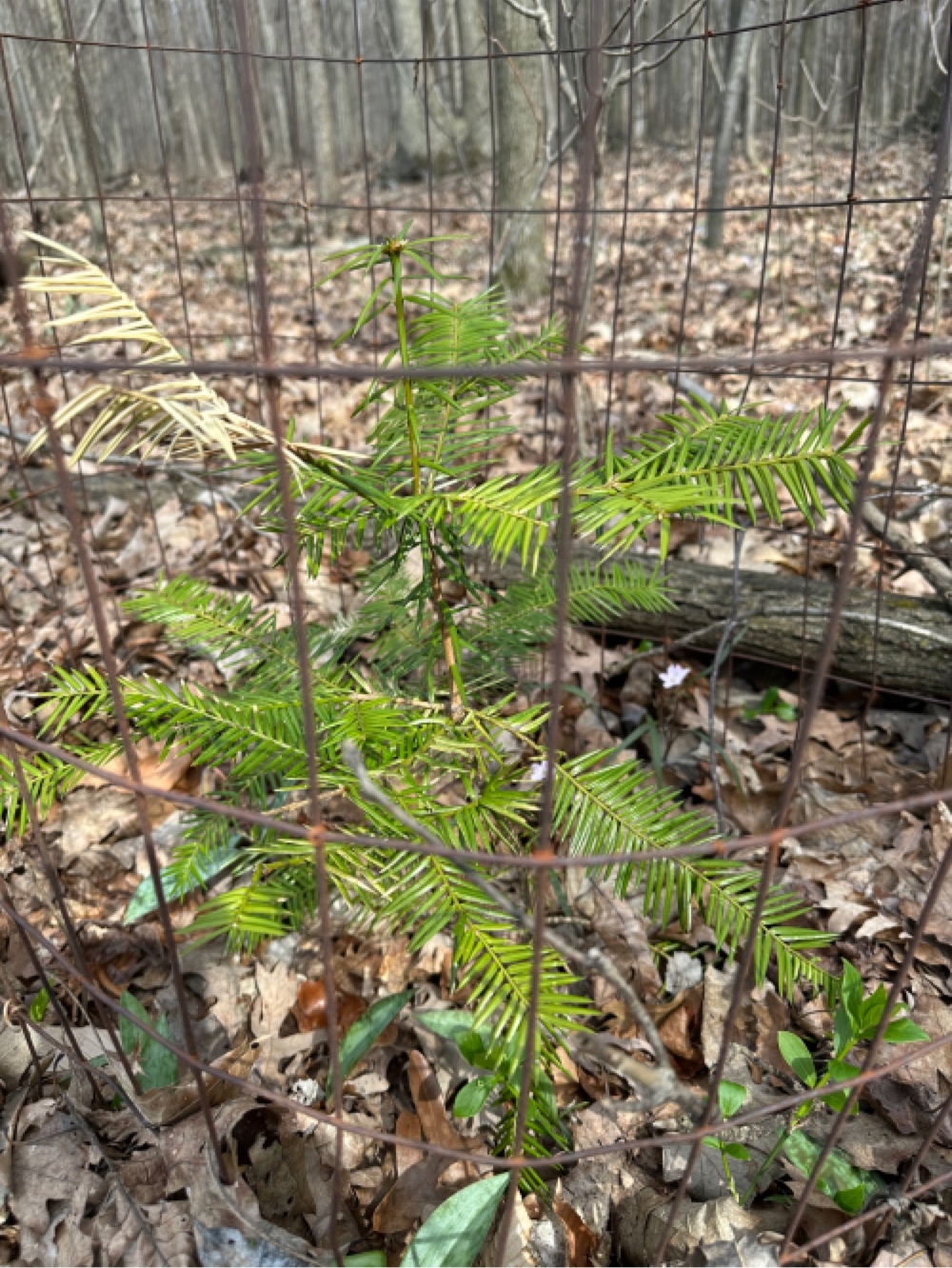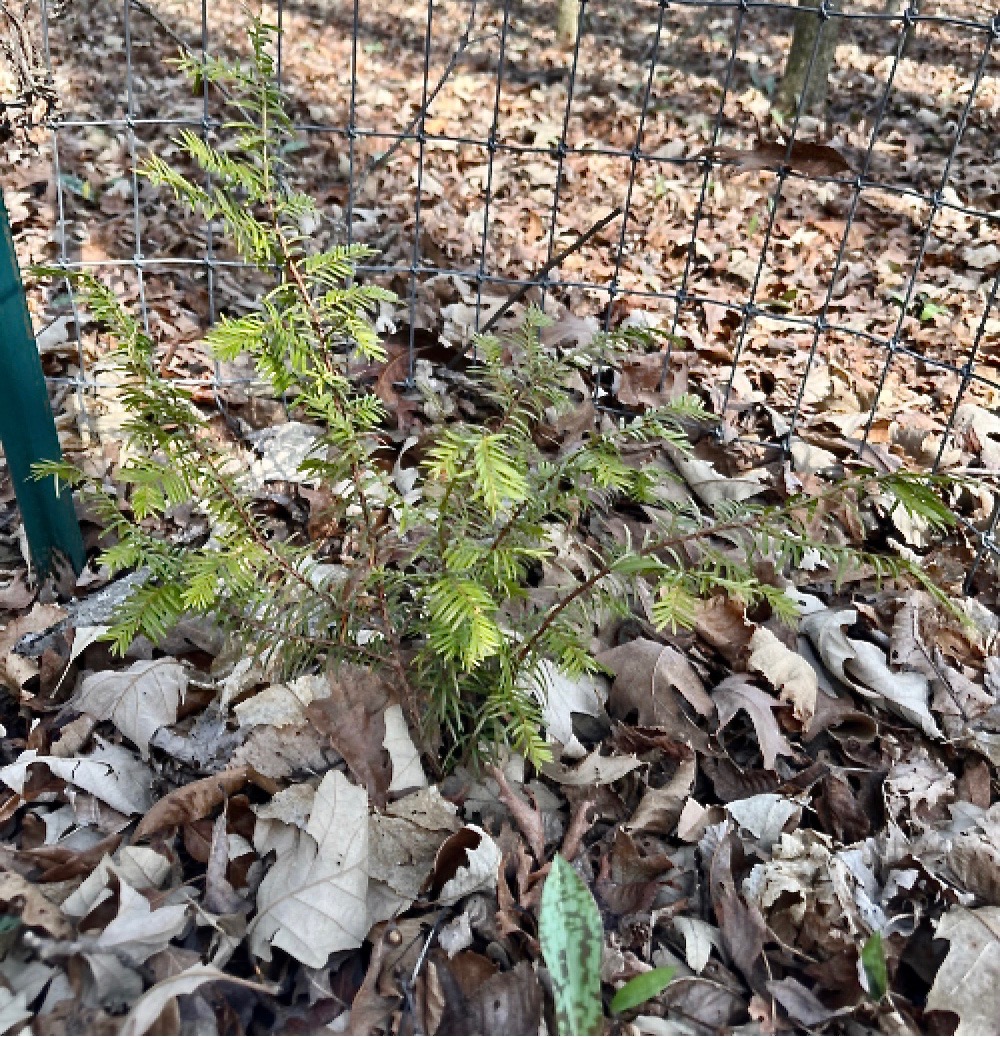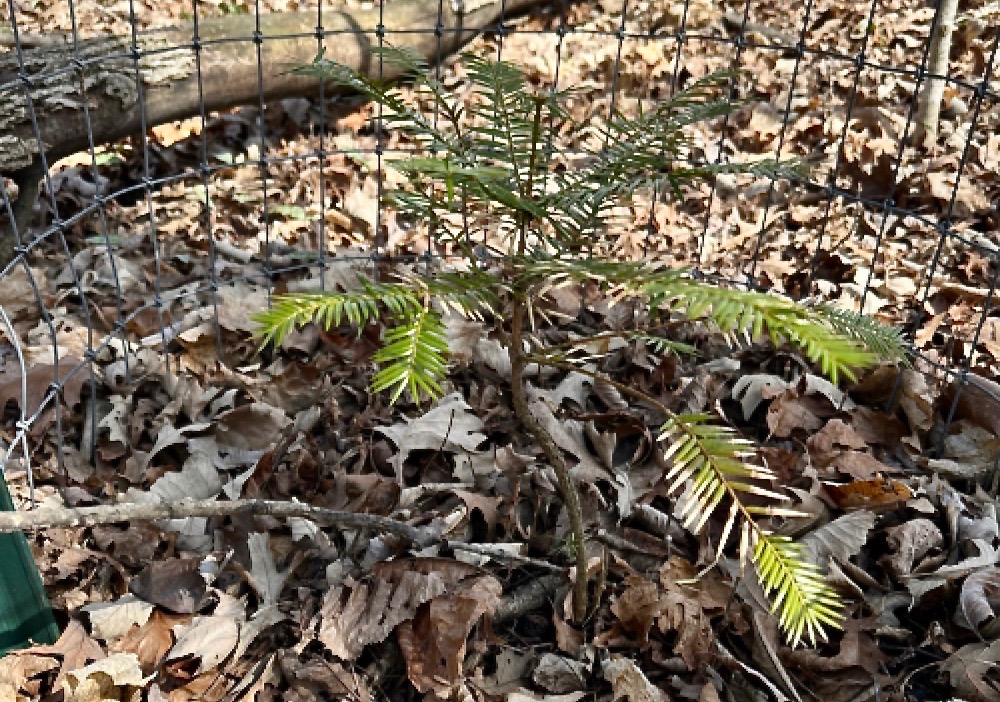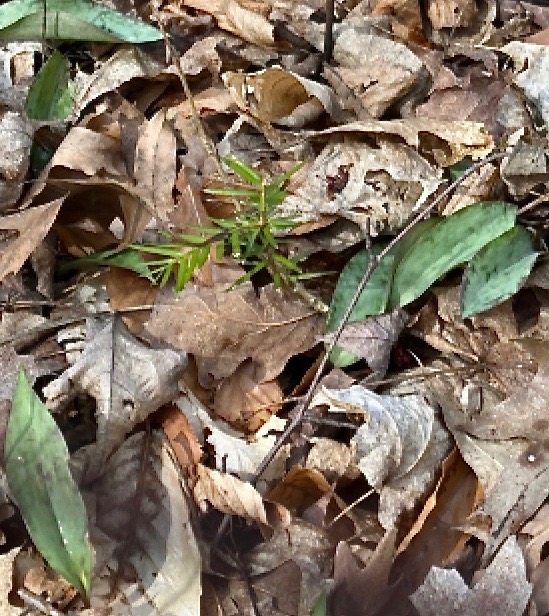to Capac, Michigan
45 forested acres owned by Paul Camire
|
PAUL CAMIRE, whose family farm and forest is in the "thumb" of southern Michigan, led CONNIE BARLOW on a tour of his Florida torreya plantings August 13, 2023. Despite setbacks by herbivory, Paul's 45-acre deciduous forest is proving to be good habitat for this endangered and slow-growing subcanopy conifer. Another 30 young ones still in pots outdoors at his home will join the forest plantings in the years to come.
Crucially, too: There is no evidence of winter kill or disease problems. And at timecode 10:52 you will hear Connie's surprise when Paul shows his vibrant Florida yew — another glacial relict left stranded amidst the wild torreya in the panhandle of Florida.
Watch on youtube: "Michigan welcomes endangered trees from Florida (2023)".
"My family has a 45 acre forest. With the loss of the ash trees to the emerald ash borer I am looking to replant with some conifers."
Editor's note: Paul Camire was one of two Michigan volunteers who received seeds in Spring 2017. By then, our group had determined via field experiments that rodents would decimate the "free-planted" seeds unless the depth was at least 4 inches. Both planters followed the depth instructions and, as of July 2018, have met with early signs of success. Meanwhile, all Michigan planters who received seeds in previous years (and thus planted shallow) had zero positive results.
ADVANCE DIRECTLY to Paul's
• SPRING 2017:
SEED PLANTING DOCUMENTATION: Paul wrote: "I free-planted in the woods and marked about 100 of them with a flag. I planted 10 in pots and the remainder I planted on the bank above the creek here or along my trail in the woods. There were about five to seven seeds that had been chewed/hollow broken in the batch."
• 19 JULY 2018 REPORT:
Paul wrote: "I went for a walk in the woods today and decided to do a survey of the Torreya I planted last spring. After checking about 30 flags I spotted one! I figured that would be it after checking about 60 more and then I found two more! So I have a total of 3 Torreyas that sprouted from Frank Callahan's seed source.
• 29 AUGUST 2018 REPORT:
The next group of seedlings are beginning to emerge. I checked last week and found no new sprouts, but today I found four more emerging — two of which also sent up a basal sprout. So now I have a total of 7 from the Oregon seed. I'm sure more are getting ready. It's interesting how they are sprouting in waves.
The sprout that was nipped off [see photo above right] has fully recovered. It created a bud by the top true leaf and two weeks later it appears to look like the other seedlings. I was surprised by how quick it recovered. Also interesting is that four of the seven seedlings are along the southern edge of the forest.
• 6 SEPTEMBER 2018:
I'm at 9 seedlings [germinated] from the Oregon seed. See the attached photos of the recuperating Torreya. The pictures of the new bud forming is from August 6th.
PHOTO SEQUENCE OF NIPPED SEEDLING RECOVERING: Below left to right: July 19, August 23, September 6.
... I also included 3 photos of the initial emergence and growth of three new seedlings. PHOTOS BELOW.
EDITOR'S NOTE: See the little basal sprout in the photo above far right.
... I also have 12 seedlings and a gallon Torreya from Nearly Native Nursery and 2 more gallon Torreyas from Niche Gardens Nursery. Grand total of 23 Torreyas here.
Connie Barlow filmed Paul on a walk through his woods visiting his Torreya plantings, including both the out-planted potted seedlings and the spots where "free-planting" of seeds directly into the forest in June 2017 had already yielded tiny seedlings.
Because Connie arrived at his woods just an hour before dusk, some of the photos below (snatched as still photos from the video) are a bit dark and grainy. When Connie edits and posts the VIDEO, it will be linked here.
Paul has a diversity of tree species and age classes within his family woods. Above left is the old white oak marking a property line. Above right is another white oak, with a younger X alongside.
Below left is a giant cottonwood about 10 feet from the property line. Below right in the center front is a shagbark hickory.
27 SEPTEMBER 2018: FIRST SPROUTS OF FREE-PLANTED SEEDS
ABOVE LEFT: The seed here had been free-planted directly into forest soil in June 2017. Paul calls this little seedling the "Discovery Tree" because it was the first that he noticed to have sprouted in early summer 2018. It had more sunlight than the other free-plantings that sprouted in 2018 (because he placed it in an area where a lot of ash trees had recently died).
ABOVE RIGHT: This little seedling first showed above ground during the late summer growth episode, in August.
ABOVE - Free-planted seed that began showing above ground in the spring of 2018. By the time Paul saw it in late June, the apex growth had already been nipped off. He added the fine wire-mesh barrier at that point. By late August 2018 it had put forth a new extension for terminal growth. Notice the slight side angle of the light green growth, but it will orient fully upward. (Scroll up to the September 6 entry to get a better view of the fresh growth.)
ABOVE: More 2018 sprouts from 2017 free-planted seeds. Notice the basal sprout by his thumb in the above right photo.
27 SEPTEMBER 2018: OUTPLANTED POTTED SEEDLINGS AFTER THEIR FIRST MICHIGAN WINTER
ABOVE: This seedling came through its first winter in Michigan very well. In the close-up photo you can see the light green of the lateral branchlets that burst forth in August 2018.
ABOVE: Two views of another of the largest potted seedlings; also in great shape.
ABOVE: Left shows fresh terminal growth in 2018 (and fresh extensional growth on the pre-existing lateral branch), following its first winter in Michigan. Right is top view of a two-stemmed seedling that got nipped, but has intact terminal buds on both stems.
In addition to "rewilding" experimentation for discerning how well Torreya taxifolia does in native forest habitats at his latitude, Paul decided to experiment with an "orchard style" planting — which is the only way that any planter can foster maximal growth and hence early reproduction. He used X young potted seedlings for the orchard planting, which he purchased in 2017 in STATE.
The "plot is buffered from severe winter winds by the surrounding trees. It was rather open to begin with because a lot of ash trees had died there. As with all orchard plantings anywhere, Paul intends to cut back the wild vegetation that will keep trying to grow in the sunlight — otherwise, these pioneer species will quickly overtop the slow-growing Torreya seedlings.
• 3 MAY 2019:
"In the last month the deer have flipped over 9 of my tomato cage shelters and eaten the majority of my seedlings to the ground. I had walked the seedlings in late March and all had survived the winter in great condition. I'm sure they will resprout, but I'm going to have to upgrade to larger and heavier fencing for protection."
• 24 JUNE 2019: CONNIE BARLOW films the torreya plantings at Paul Camire's forest and posts a 2-part video series on youtube.
Two-part video of Paul Camire's Torreya in-forest plantings in Capac MI of potted seedlings and also seeds from the 2016 fall harvest in Medford Oregon. Florida Torreya has been documented surviving (with little or no damage) subzero temperatures. But this is the coldest: -45 degrees F windchill during Winter 2019. Yet the exposed Torreya branches showed no damage! The biggest problem is deer herbivory: deer even push over wire cages. 30 minutes - filmed June 24, 2019
This last half of the video set surveys the health status of the remaining seedlings, turning up not only severe herbivory but also stunning recovery from such setbacks. Paul Camire shows and tells about three potted seedlings that suffered severe leaf-kill from just one day in full sun —, yet tremendous recovery. Video ends with the planting of 4 more (healthy) potted seedlings.
28 minutes - filmed June 24, 2019 and September 27, 2018
STILL IMAGES FROM THE VIDEOS:
ABOVE LEFT: No damage after exposure to -45F windchill. (Snow level was lower than left-most branch.)
RIGHT: Close-up of the new growth.
Seedlings that made it through the winter without any browse on their leader growth (the top of the main stem), show buds that will become either
• a triplet of new lateral growth (branches) or
• another spurt of straight upward growth.
ABOVE: Seedlings that lost their leader tops had to establish new leaders. In the LEFT image, see the single new bud right below the mangled top; that will become the new leader. In the RIGHT photo, this seedling is establishing a new leader farther down the stem.
ABOVE: Paul Camire has seedlings in the back of his truck ready to plant. Notice the sun-scalded torreyas next to the fresh leaves of the potted Tuliptree (Liriodendron). Those seedlings had leaves scalded after just one day in full sun. Fortunately, new buds are emerging from main stem — and later in the growing season, Paul noticed full recovery!
BELOW: Paul is planting the seedlings into his forest.
Connie and Paul on the farmland
• 1 JULY 2019 REPORT BY PAUL CAMIRE:
"Today I built 9 new wire cages and put them around my three, above ground, Medford, OR Torreyas, the four seedlings (Niche Gardens) you and I planted and two more on the open-grown seedlings (Nearly Native) by the gas well. It was full sun when I went there this afternoon and I really liked what I saw at the sites we selected for the seedlings. Just the right mix of sun and shade. The opening created by the tree fall is an interesting experiment to see how that Torreya does there. I may plant more Torreyas in those areas in the future and hopefully add some additional genetics. I also took a look at my larger Torreyas and was surprised to see the lateral and terminal buds had expanded already. I was surprised how fast it was. Thankfully no herbivory took place and the seedlings were all like we left them."
• 29 AUGUST 2020 REPORT BY PAUL CAMIRE:
My experiments with herbivory of Torreya are at an end. I had 9 seedlings I bought in spring 2018 and had planted in an area where ash and elm have died back. They were all eaten down that year, but 8 came back. They weren't touched in 2019, but this spring they were eaten back again. Unfortunately, during my check two days ago, only one resprouted. These seedlings are/were growing in the midst of poison ivy, grape, and Virginia creeper in addition to jack-in-the-pulpit, elm/ash/red maple seedlings, and geraniums. I thought this thick layer of underbrush would protect them, but they were still sought out. The herbivory was consistent with previous herbivory done by deer. I even peeled the poison ivy back expecting to see safely protected Torreyas, but it was not enough of a deterrent. So in my area, cages/fencing is a must in early years. I also have to conclude that herbivory in early to mid spring will be lethal to young Torreyas (seedlings) in my area.
1. woodland edge species
• NOVEMBER 2020 was sent 80 seeds from Torreya Guardians fall harvest (from private seed sources in Clinton and Mt. Olive NC).
• 30 MARCH 2021 REPORT BY PAUL CAMIRE: "My Torreyas are looking fine after winter. Not much burning of foliage from cold. Practically no discoloration on the plants along the southern edge of the forest."
• MAY 2021 report by Paul: "The torreya buds have been expanding here, with first swelling beginning 3 weeks ago (late April). Several have laterals and terminals emerging. The majority of my Torreya are looking well. My two remaining seedlings from the Oregon free-planted seeds are still going and are budding out. I planted a group in a very exposed spot next to the creek last year, and they all got varying degrees of winter injury/wind burn. It's interesting how one can know that they got damaged, but the coloring doesn't change until the growing season begins. I was curious if I could notice any signs of injury from the hot to super cold jumps we had in April. All my lilacs got their flower buds damaged from the cold and even my Alliums got damaged and have aborted flower buds and soft/wrinkled leaves."
• JULY 2021 report by Paul: "The Torreya in full sun are beginning their second wave of growth this year. Those on the woods look like buds may be getting ready to swell for a second spurt. I lost a few that were in pots, that I got when I visited Jack last fall. Maybe a display of cold hardiness in the rest? Who knows. One of my Highlands Torreya seeds sprouted that I received from Clint 2 years ago. He sent me six and hopefully I will have more grow. It sprouted a week and a half ago." UPDATE AUGUST: "Three of the six Highlands seeds have sprouted."
• OCTOBER 2021 report by Paul: "I ended up with three germinated Highlands seeds that I received from Jack and Clint's 2019 expedition there. I haven't lost anymore trees planted in the ground at the farm. We just took soybeans off at the farm last week and once we dry up, we have twenty more acres of soybeans left to harvest at a farm we rent a field at."
• JANUARY 2022 photos with captions by Paul Camire. (Each plant is within a large wire cage.)
Here are the original four Torreyas, when you first enter the woods. As you can see, the smaller two (ABOVE) were the ones eaten by deer, uncaged until they were eaten back twice. BELOW: The tall one is missing the lower growth and was the one that got sunburned after the dead ash tree fell onto it. The other is still in original form.
I received (and planted) the Medford seeds early spring 2017. Frank harvested them in late autumn 2016.
ABOVE & BELOW are the 4 potted seedlings that Connie and I planted when she visited in September 2019.
• JULY 2022 general update by Paul Camire: "... The progress of my Torreya has been slow. It seems like they take forever to get growing. When you visit you will see some recovery and some are taking on a more lanky, forest type growth. The four that you helped me plant are doing well and seem quite happy in the spots we chose. I have several in pots next to my house. The extended winter weather and the roofing crew in December really did a number on them. They are partially healed and insulated with straw. Many got broken by falling shingles and then severe winter dieback. I think it might be a good thing though, because I think that maybe the survivors may have a bit more expression of winter hardiness."
• JANUARY 2023 photo report by Paul Camire.
ABOVE and BELOW: January 2023 photos of the first 4 potted seedlings that had been planted in 2017. "Two of them [above] had been severely browsed on by deer (owing to twice-toppled cages), but you can see they are beginning to recover. They get a lot more shade than my other Torreyas, but are still doing good."
BELOW are two more seedlings (all protected now by sturdy cages):
• FLORIDA YEW SEEDLING PLANTED:
Thanks to the mild start of winter I was able to keep working on my planting projects.
It is about 16” tall.
It looks good so far, but the coldest temperature it has seen so far is 21 degrees F."
• July 2023 overall update:
The Torreya are definitely NOT in decline here. Deer remain the number one problem still.
Four of the seeds that Fred Bess sent me from his Cleveland torreyas last fall have germinated. I put them in pots with soil and in the basement and kept them slightly damp.
The only real Torreya loss I had was the seedling that germinated from the first batch of Medford Oregon seeds that you sent me. It was looking great at my April/May check, but when I checked a few weeks back it was completely dead. I haven't done anything with it yet to find the cause. I'm going to guess it is voles; they took down another one of my free-planted seeds a year or two ago.
I also received some cuttings from Fred's trees that I put in soil and kept alive all winter into this spring. Three of the four cuttings started budding, but then two of those and the non-budded cutting died. The other cutting survived another month but turned brown last week… So no luck with cuttings for me yet.
• August 2023: New VIDEO of Torreya thriving in MICHIGAN
PAUL CAMIRE led CONNIE BARLOW on a tour of his Florida torreya plantings August 13, 2023. Despite setbacks by herbivory, Paul's 45-acre deciduous forest is proving to be good habitat for this endangered and slow-growing subcanopy conifer. Another 30 young ones still in pots outdoors at his home will join the forest plantings in the years to come.
Crucially, too: There is no evidence of winter kill or disease problems. And at timecode 10:52 you will hear Connie's surprise when Paul shows his vibrant Florida yew — another glacial relict left stranded amidst the wild torreya in the panhandle of Florida.
Watch on youtube: "Michigan welcomes endangered trees from Florida (2023)".
• March 7, 2024: Highlands NC seeds germinate after 3 winter stratifications
PAUL CAMIRE writes: Mid-December 2023, I was pulling out some flower seeds I had in my refrigerator. There I discovered a bag of torreya seeds from the 2021 seed harvest at the mature grove near Highlands, NC. How I missed this seed lot for so long is beyond me. So I removed them from the refrigerator and put them in the basement. Today (7 March 2024) I checked on them for the first time and found that two had germinated. I potted them up and hopefully a few more will germinate this year. I am very surprised to have germination after so long.
• November 19, 2024: Brief update
PAUL CAMIRE writes: The Torreya in the woods did fairly well this year. Two of the trees we planted on the south side put on around 6" of vertical growth. The Florida yew is doing fine and seems happy. I still haven't been able to find any friends for it.
• DECEMBER 2024 photos with captions by Paul Camire. (Each plant is within a large wire cage.)
ABOVE & BELOW: This is the first/original group I planted that are seen when you first enter the trail.
ABOVE & BELOW: Here is the second group of 4 that you and I planted on the south side of the forest.
It has been back from the dead twice now.
• APRIL 2025: Barely any WINTERKILL despite cold snap.
Near Capac MI (Sarnia, Ontario) the lows were January 21 and 22 (-2 and -4 F).
ABOVE & BELOW: This is the first/original group I planted that are seen when you first enter the trail. WINTER KILL IS VISIBLE (though slight) only on the two below. (Yellow flower is trout lily in bloom.)
ABOVE & BELOW: Connie Barlow filmed and posted a video of these 4 torreyas from their pots in June 2019. WINTER KILL IS VISIBLE April 2025 (though slight) only on the two below.
BELOW LEFT: In contrast, its closest neighbor Torreya did catch some windkill: just on a part of its lowest branch (extending forward).
BELOW RIGHT: Despite all his attempts to nurture "freeplanted" Medford OR seeds (from 2016 harvest) directly into the woods, failure to appear and then tremendous herbivory took its tool. This little one, eaten back so many times, is the only torreya of that batch still alive in April 2025.
• September 2025: superb new growth after subzero winter 
 ABOVE LEFT: Circumstances sometimes encourage a torreya to preference lateral extension of its branches over any apical activity in some years. Clearly, this torreya extended the outward reach of its topmost lateral branches this year. But the condition of the apical stem itself is unclear.
ABOVE RIGHT & BELOW: This torreya offers a superb opportunity to study how winterkill affects the most vulnerable parts of this torreya. The CLOSE-UP PHOTO BELOW shows that the topmost new leaves grown in summer 2024 did not survive the winter kill of 2025. But the triplet buds at the tips of those branches did — and produced healthy branchlets. The stem's central apical bud survived too, and sent upward nearly 2 inches of new growth.
ABOVE LEFT: Circumstances sometimes encourage a torreya to preference lateral extension of its branches over any apical activity in some years. Clearly, this torreya extended the outward reach of its topmost lateral branches this year. But the condition of the apical stem itself is unclear.
ABOVE RIGHT & BELOW: This torreya offers a superb opportunity to study how winterkill affects the most vulnerable parts of this torreya. The CLOSE-UP PHOTO BELOW shows that the topmost new leaves grown in summer 2024 did not survive the winter kill of 2025. But the triplet buds at the tips of those branches did — and produced healthy branchlets. The stem's central apical bud survived too, and sent upward nearly 2 inches of new growth.

|
